Sharp HRO00038 GSM Cellular Phone W/ Bluetooth User Manual
Sharp Corporation GSM Cellular Phone W/ Bluetooth
Sharp >
User Manual

1
Introduction
Congratulations on your new 3G/UMTS 902SH phone.
Useful Functions and Services
Your phone offers you the following features:
•Video calls. You can talk while viewing each other on respective screens.
•A built-in digital camera for taking pictures and video clips.
•A message function for reading and creating SMS messages.
•MMS (Multimedia Messaging Services) for personalising your phone in various ways.
•A WAP browser for accessing information on the mobile Internet.
•Java™ applications. You can also download various applications from Vodafone via the
mobile Internet.
•A voice recorder function for recording and playing back voice clips.
•A Bluetooth ® wireless technology interface for establishing contact and transmitting data
with certain devices. You can transmit pictures, sounds, and video clips to OBEX-enabled
phones.
•An infrared interface for data communication. You can transmit pictures, sounds, and
video clips to OBEX-enabled phones.

2
Introduction
•A data synchronisation function for synchronising the Contacts List and schedule entries
with Microsoft Outlook or Outlook Express on a PC.
•A schedule alarm for creating and sending schedule entries with alarm settings.
•Video output. You can connect your phone to other devices, such as TVs or videos set to
output, and display Java™ data, images, or video clips.
•Barcode scanner. With the built-in digital camera, you can read texts and barcodes, and
create QR codes.
•Playback of the downloaded sound and video clip files.
•SD memory card slot that expands connectivity with a PC using the memory card.

3
Introduction
About This User Guide
This user guide is carefully designed to help you learn about your phone’s features and
operations quickly and effectively.
NOTICE
•We strongly recommend that you keep separate permanent written records of all
important data. Data may be lost or altered in virtually any electronic memory product
under certain circumstances. Therefore, we assume no responsibility for data lost or
otherwise rendered unusable, whether as a result of improper use, repairs, defects,
battery replacement, use after the specified battery life has expired or any other cause.
•We assume no responsibility, directly or indirectly, for financial losses or claims from third
parties resulting from the use of this product and any of its functions, such as stolen credit
card numbers, the loss or alteration of stored data, etc.
•All company and/or product names are trademarks and/or registered trademarks of their
respective holders.
•Screen layout may differ from that illustrated in this user guide.
The information described in this user guide is subject to change without notice.

4
Introduction
•All the functions described in this user guide may not be supported by all networks.
•We assume no responsibility for downloaded contents, information, etc. from the
network.
•Occasionally, a few black or bright pixels may appear on the screen. Please note that this
will not have any impact on any of the features or on performance.
Copyright
According to copyright laws, the reproduction, alteration and use of material which is
protected by copyright (music, pictures, etc.) is only permitted for personal or private use. If
the user is not in possession of more extensive copyright or has not received the explicit
permission from the copyright owner to reproduce, alter or use a copy which has been made
or modified in this way, this is considered to be a violation of the copyright laws and gives
the copyright owner the right to claim for damages. For this reason, avoid the illegal use of
material which is protected by copyright.
Windows is a registered trademark of Microsoft Corporation in the United States and/or
other countries.

5
Introduction
Powered by JBlend™ Copyright 1997-2004 Aplix
Corporation. All rights reserved.
JBlend and all JBlend-based trademarks and logos
are trademarks or registered trademarks of Aplix
Corporation in Japan and other countries.
Powered by Mascot Capsule®/Micro3D Edition™
Mascot Capsule® is a registered trademark of HI Corporation
©2002-2004 HI Corporation. All Rights Reserved.
Licensed by Inter Digital Technology Corporation under one or more of the
following United States Patents and/or their domestic or foreign
counterparts and other patents pending, including U.S. Patents:
4,675,863: 4,779,262: 4,785,450 & 4,811,420.

6
Introduction
T9 Text Input is licensed under one or more of the following: U.S. Pat. Nos.
5,818,437, 5,953,541, 5,187,480, 5,945,928, and 6,011,554;
Australian Pat. No. 727539; Canadian Pat. No. 1,331,057; United
Kingdom Pat. No. 2238414B; Hong Kong Standard Pat. No. HK0940329;
Republic of Singapore Pat. No. 51383; Euro. Pat. No. 0 842 463
(96927260.8) DE/DK, FI, FR, IT, NL,PT.ES,SE,GB; Republic of Korea Pat.
Nos. KR201211B1 and KR226206B1; and additional patents are pending
worldwide.
Bluetooth is a trademark of the Bluetooth SIG, Inc.
The Bluetooth word mark and logos are owned by the Bluetooth SIG, Inc.
and any use of such marks by Sharp is under license. Other trademarks
and trade names are those of their respective owners.
CP8 PATENT

7
Introduction
This product is licensed under the MPEG-4 Visual Patent Portfolio License for the personal and non-commercial
use of a consumer to (i) encode video in compliance with the MPEG-4 Video Standard (“MPEG-4 Video”) and/or
(ii) decode MPEG-4 Video that was encoded by a consumer engaged in a personal and non-commercial activity
and/or was obtained from a licensed video provider. No license is granted or implied for any other use.
Additional information may be obtained from MPEG LA. See http://www.mpegla.com.
This product is licensed under the MPEG-4 Systems Patent Portfolio License for encoding in compliance with
the MPEG-4 Systems Standard, except that an additional license and payment of royalties are necessary for
encoding in connection with (i) data stored or replicated in physical media which is paid for on a title by title
basis and/or (ii) data which is paid for on a title by title basis and is transmitted to an end user for permanent
storage and/or use. Such additional license may be obtained from MPEG LA, LLC. See http://www.mpegla.com
for additional details.

8
Contents
Introduction .............................................................. 1
Your Phone ............................................................. 11
Getting Started ....................................................... 12
Inserting the SIM Card and the Battery ..............18
Removing the SIM Card and the Battery ............ 19
Charging the Battery ........................................20
Inserting the Memory Card ............................... 23
Removing the Memory Card ............................. 24
Turning Your Phone On and Off ........................ 24
Keypad Lock .................................................... 26
Display Indicators (Main Display) ....................... 27
Display Indicators (External Display) .................. 30
Opening Your Phone ........................................ 32
Navigating Functions ............................................. 33
Using in the Normal Position of the Display ........ 33
Voice Call/Video Call Functions ............................. 35
Making a Voice Call .........................................35
Speed Dialling ................................................. 36
Redialling ........................................................ 37
Answering a Voice Call ..................................... 37
Incall Menu (Voice Call) ....................................39
Making a Video Call ......................................... 43
Answering a Video Call ..................................... 44
Incall Menu (Video Call) .................................... 46
Using the Menu ......................................................49
Top Menu ........................................................ 49
Contacts List ...........................................................52
Changing the Name Order ................................53
Changing the List Displayed .............................53
Selecting the Storage Memory .......................... 54
Changing the Contact List Order ....................... 54
Add New Contact ............................................. 54
Viewing My Contact Details ..............................55
Copying Contacts List Entries between SIM Card
and Handset .................................................... 56
Finding a Name ...............................................56
Dialling from the Contacts List .......................... 56
Editing Contacts List Entries .............................57
Deleting Contacts List Entries ...........................57
Manage Group .................................................58
Assigning a Ringtone or a Ring Video Clip to Each
Contacts List Entry ...........................................59
Memory Status ................................................60
Speeddial List ..................................................60
Sending a Contacts List Entry ........................... 61
Receiving a Contacts List Entry .........................62
Call Costs ........................................................62
Entering Characters ...............................................63
Changing the Input Languages .........................65

9
Contents
Changing the Input Mode ..................................65
Using Templates ..............................................67
Camera ....................................................................69
Taking Pictures ................................................69
Recording Video Clips .......................................79
Messages ................................................................87
MMS ...............................................................87
SMS ................................................................87
Email ...............................................................87
Cell Broadcasts ................................................97
Area Info ..........................................................99
Setting Up MMS/SMS/Email ............................100
Vodafone live! .......................................................104
Starting the WAP Browser ...............................105
Navigating a WAP Page ..................................105
Media Player .........................................................109
Switching between Music Player and
Video Player ...................................................109
Music Player ..................................................109
Video Player ...................................................112
My Items ...............................................................116
Pictures .........................................................117
Videos ...........................................................123
Sounds & Ringtones .......................................128
Games & More ...............................................132
Bookmarks .................................................... 137
My Saved Page ............................................. 137
Text Templates .............................................. 138
Other Documents .......................................... 139
Games & More ...................................................... 142
Games .......................................................... 142
Screensavers ................................................ 144
Settings ........................................................ 145
Java™ Information ........................................ 147
Organiser .............................................................. 148
Calendar ....................................................... 148
Alarms .......................................................... 152
Calculator ..................................................... 154
Voice Recorder .............................................. 156
Scanner ........................................................ 157
Stopwatch ..................................................... 161
Tasks ........................................................... 162
World Clock .................................................. 165
Countdown Timer .......................................... 166
Expenses Memo ............................................ 167
Phone Help ................................................... 168
SIM Application .................................................... 169
Settings ................................................................ 170
Profiles ......................................................... 170
Setting the Display ......................................... 177

10
Contents
Sound Settings .............................................. 184
Time & Date .................................................. 185
Language Setting ........................................... 187
Call Settings .................................................. 187
Video Call Settings ......................................... 194
Security ........................................................ 196
Memory Settings ........................................... 199
Master Reset ................................................. 200
Call Log ................................................................. 201
Call Timers .................................................... 202
Call Costs ...................................................... 203
Connectivity .......................................................... 205
Bluetooth ...................................................... 205
Infrared ......................................................... 211
Network Settings ........................................... 211
Internet Settings ............................................ 215
Backup/Restore ............................................. 218
Connecting 902SH to Your PC .............................. 221
System Requirements .................................... 221
3G/GSM GPRS Modem .................................. 222
Handset Manager .......................................... 223
Software Installation ....................................... 223
Troubleshooting ................................................... 225
Safety Precautions and Conditions of Use .......... 227
CONDITIONS OF USE .....................................227
ENVIRONMENT ..............................................233
PRECAUTIONS CONCERNING VEHICLE USE .....234
SAR ..............................................................235
PRECAUTIONS FOR USE IN USA ......................236
Specifications and Optional Accessories ............ 240
Specifications ................................................240
Optional Accessories ......................................240
Index ..................................................................... 241
List of Menu Functions ......................................... 246

11
Your Phone
Please check the following carefully. Your phone should come complete with:
• 3G (UMTS)/GSM 900/1800/1900/GPRS phone
• Lithium Ion Battery
• Battery Cover
•AC Charger
• Stereo Headset
• Handsfree Microphone Unit
• CD-ROM
• SD Memory Card
•Video Cable
•User Guide
•Quick Start Guide
• Vodafone live! / (3G/UMTS) Guide
• 3G Guide
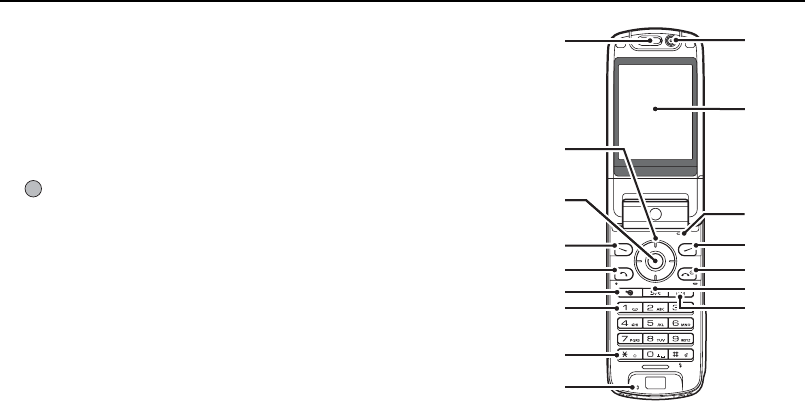
12
Getting Started
1. Earpiece
2. Navigation Keys (Arrow Keys):
a b c dMoves cursor to highlight a menu item, etc.
Up/Down arrow keys: Displays the Contacts List when pressed during stand-by.
Left arrow key: Press to view the message inbox.
Right arrow key: Press and hold to display the monthly calendar.
3. Centre Key: Displays Main menu when pressed during stand-by, then
executes a function highlighted.
4. Left Soft Key:
A
Executes a function at the bottom left of the screen.
Press during stand-by to display the Messaging screen.
5. Send/Redial Key:
D
Makes or accepts calls, displays the All Calls screen in
stand-by mode.
6. Shortcut Key:
S
Press to open the shortcut menu to access the desired
applications.
7. Voice Mail Key:
G
Press and hold to connect to the Voice mail centre
automatically. (Depending on the SIM card.)
8. * /Shift Key, Viewfinder Switch Key:
PSwitches character case between four modes: Abc, ABC,
123 and abc on the text entry screen.
Press to enter P, ? or * in stand-by mode.
1
2
3
4
5
6
7
8
9
11
10
12
13
14
15
16

13
Getting Started
9. Microphone
10. Sub Camera (Internal Camera)
11. Main Display
12. Microphone (for the viewer style of the display)
13. Right Soft Key:
C
Executes the function at the bottom right of the screen.
Shortcut to “Vodafone live!” by opening the browser. Press
during stand-by.
14. End/Power Key:
F
Ends a call and turns power on/off.
15. Clear/Back Key:
U
Clears the characters before the cursor, returns to the
previous screen, etc.
16. Multimedia Key:
E
Opens the Media Player screen.
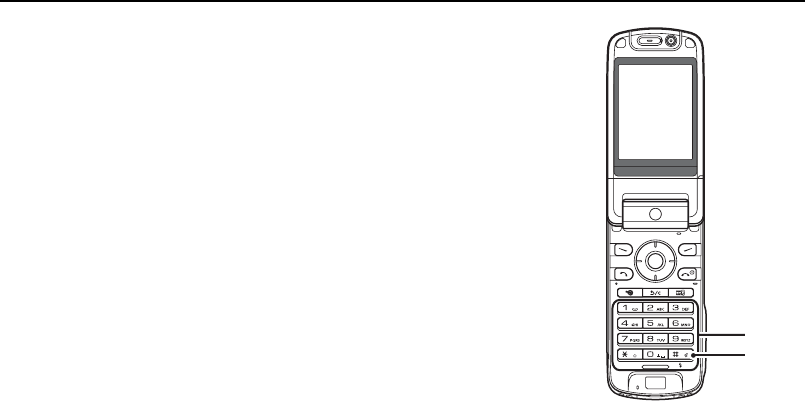
14
Getting Started
17. Keypad:
1 key: Shortcut to the Voice mail centre. (Depending on the SIM
card.) Press and hold during stand-by.
2-9 keys: Press and hold during stand-by to display each speed dial
phone number.
0 key: Press and hold to enter +.
18. #/Flash Light Key:
R
Switches symbol screens on the text entry screen.
Press and hold to switch languages on the text entry
screen.
Turns the flash/auxiliary light on or off in camera mode.
Press and hold during stand-by to switch Profiles settings
between the mode most recently activated and Silent
mode.
17
18
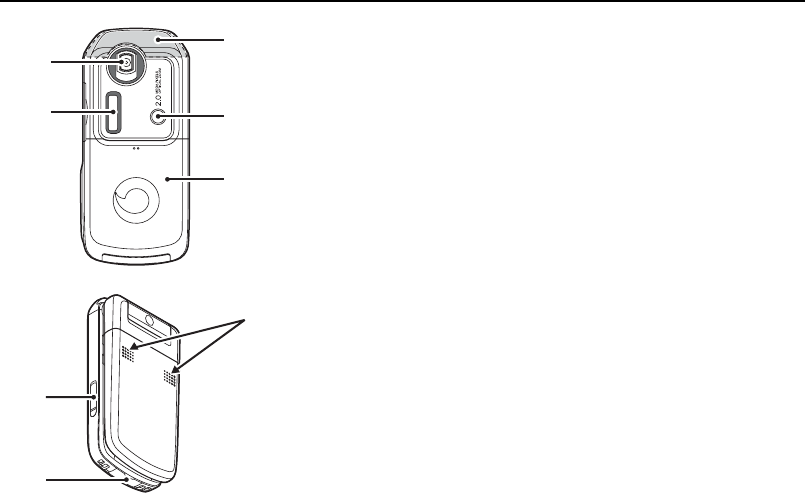
15
Getting Started
19. Camera (External Camera)
20. Sub Display
21. Built-in Aerial: Warning: Do not cover the top of the phone with your hand
when in use as this may interfere with the performance of
the built-in aerial.
22. Mobile Light: Used as a flash or an auxiliary light in camera mode.
23. Battery Cover
24. VIDEO OUT/Handsfree Microphone Connector
25. External Connector: Used to connect either the charger or a USB data cable.
26. Stereo Speakers
19
20 22
23
21
24
25
26
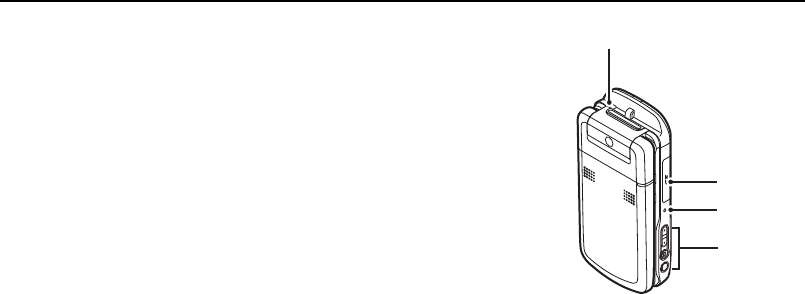
16
Getting Started
27. Infrared Port: Sends and receives data via infrared.
28. Memory Card Slot Cover
29. Small Light: Used as a battery charge indicator, or notification for
incoming calls.
30. Side Keys (Side-Up/Side-Down/Camera/Cancel):
Side-Up/Side-Down: (These two keys work in reverse with the viewer position of
the display.)
Moves the highlight up or down.
Press during stand-by or during a call to increase or
decrease the earpiece volume.
Press in camera mode to increase or decrease the zooming
ratio.
Camera Key: Displays the Main menu when pressed during stand-by,
then executes a highlighted function. Press and hold to
activate the camera.
Press and hold to display the Options menu.
Press during an incoming call to answer the call.
Press during a call to display the Call options.
Press halfway to lock the focus in camera mode.
Press (and hold) to take a picture with the camera.
27
28
29
30

17
Getting Started
Cancel Key: Press to return to the previous screen.
Press to reject an incoming call.
Press during an incoming call to send a busy tone to the
caller.
Press to end the call.
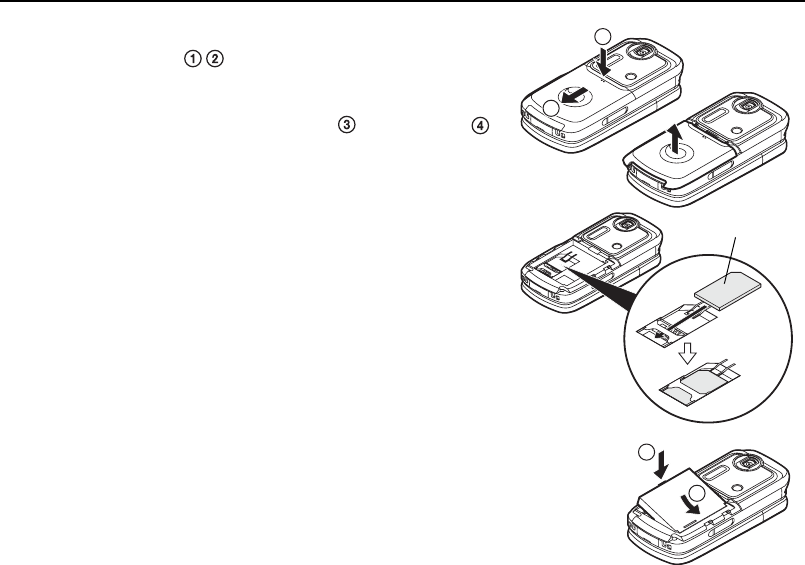
18
Getting Started
Inserting the SIM Card and the Battery
1. Slide off the battery cover ( ).
2. Slide the SIM card into the SIM holder.
3. Hold the battery so that the metal contacts of the battery are facing down, slide the
guides on the top of the battery into the battery slots , and then insert it .
4. Replace the battery cover.
Note
•Make sure that only 3V SIM cards are used.
•Make sure that the standard accessory battery (XN-1BT30) or the optional accessory,
high capacity Li-ion battery (XN-1BT31) is used. SIM card
4
3
2
1
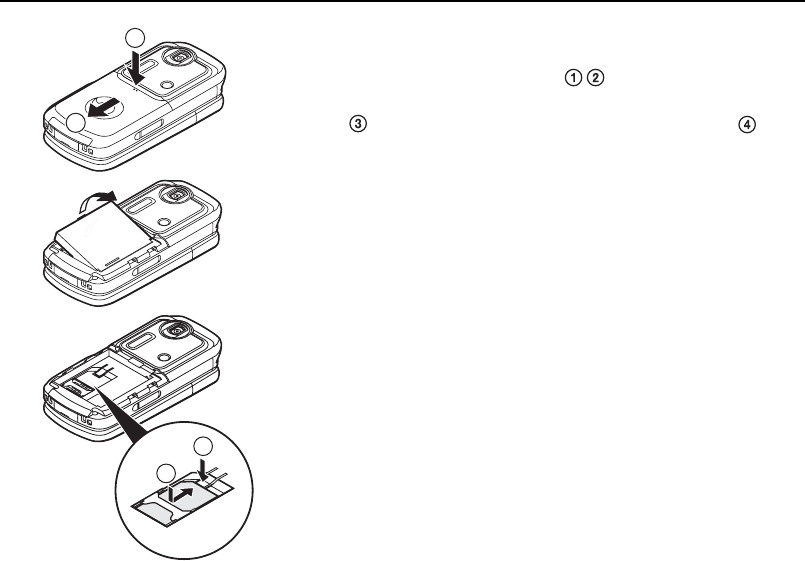
19
Getting Started
Removing the SIM Card and the Battery
1. Ensure that the phone is turned off and that the charger and other accessories are
disconnected. Slide off the battery cover ( ).
2. Lift the battery using the protruding edge and remove the battery from the phone.
3. Hold down gently while sliding the SIM card out of the SIM holder ( ).
Battery Disposal
The device is battery-powered. In order to protect the environment, please read the
following points concerning battery disposal:
• Take the used battery to your local waste depot, dealer or customer service centre for
recycling.
• Do not expose the used battery to a naked flame, immerse in water or dispose with the
household waste.
2
1
3
4

20
Getting Started
Charging the Battery
You must charge the battery for at least 2 hours before using your phone for the first time.
Using the Charger
1. Open the cover of the external connector, connect the charger to the external socket
located at the bottom of the phone by pressing both sides indicated with arrows, and
connect to an AC outlet.
The small light turns red.
Standard charging time: Approx. 2 hours
Note
•Charging time may vary depending on the state of the battery and other conditions. (See
“Battery” on page 229.)
Small light

21
Getting Started
To Disconnect the Charger
When charging is complete, the small light turns off.
1. Unplug the charger from the AC outlet, then unplug the charger connector from the
phone.
2. Close the cover.
Note
•Do not use any non-approved chargers as they may damage your phone and invalidate
any warranties, see “Battery” on page 229 for details.
•When the phone is charging, the small light blinks and the animated battery status
indicator ( ) in the upper right of the screen displays the current status of the battery.
To Charge Using the Cigarette Lighter Charger
The optional cigarette lighter charger supplies power for charging from the cigarette lighter
socket of a car.
Battery Level Indicator
The current battery level is displayed in the upper right of the main and the external displays.

22
Getting Started
Low Battery during Use
When the battery is running low, an alarm will sound and “ ” is displayed on the main
and external displays.
If you are using your phone and you hear the low battery alarm, attach your charger as soon
as possible. The phone may not be able to continue normal operation if you continue to use
it.
Battery Indicators Charge Level
Sufficiently charged
Charging recommended
Charging required
Empty
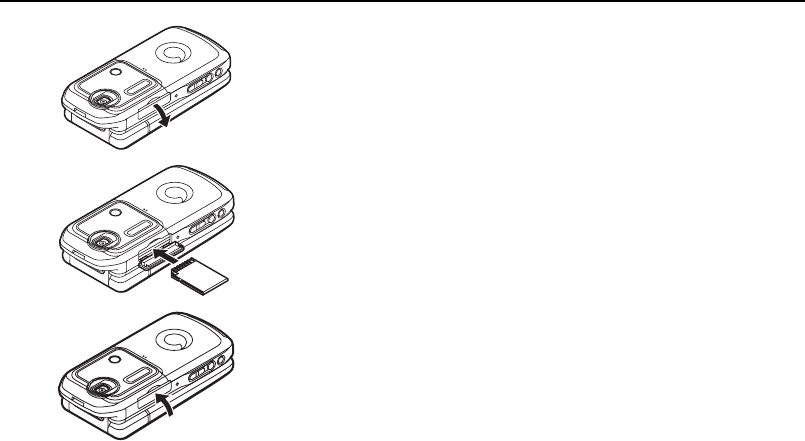
23
Getting Started
Inserting the Memory Card
1. Turn off the phone.
2. Open the memory card slot cover.
3. Insert the memory card all the way in.
4. Close the cover.
Note
•The miniSD memory card cannot be used with your phone.
•Make sure that the phone is turned off before inserting the memory card.
•Use only SD memory cards up to 512 MB, or MMC up to 128 MB.
•Be sure to insert the card in the correct direction and orientation.
•The SD memory card has a write-protect switch that prevents you from deleting memory
contents by accident. If you slide the switch to the lock position, you cannot save or delete
files.
•Do not open the memory card cover while the memory card is being formatted or written
to. The card may be damaged beyond use.
•Keep all memory cards out of the reach of small children.

24
Getting Started
Tip
•You see the following indicators when the memory card is in use:
: Appears when the card is inserted.
: Appears when the card is inserted and locked.
: Appears when the card is damaged or unusable.
: Appears when the card is locked and damaged or unusable.
: Appears when the card is being written or read.
: Appears when the card is being formatted.
Removing the Memory Card
1. Open the memory card slot cover, remove the card, and close the cover.
Note
•Make sure that the phone is turned off before removing the memory card.
•Do not remove the memory card while the memory card is being formatted or written to.
Turning Your Phone On and Off
To turn the power on, press and hold F for approximately 2 seconds.
The stand-by screen is displayed.

25
Getting Started
To Enter the PIN Code
If activated you are asked to enter a PIN (Personal Identification Number) code and handset
lock code after turning on your phone.
1. Enter your PIN code.
The PIN code is 4 to 8 digits.
2. Press .
To turn the power off, press and hold F for approximately 2 seconds.
Note
•If your PIN code is entered incorrectly three times in a row, the SIM card is locked. See
“Enabling/Disabling the PIN Code” on page 196.
•If the clock settings have not been made, the date and time entry screen is displayed
(p. 185).
To Copy All Contacts List Entries from the SIM Card
When you insert the SIM card into your phone for the first time and start the Contacts List
application, you are asked whether you wish to copy Contacts List entries on the SIM card.
Follow the on-screen instructions, or you can do it later using the Contacts List menu as
follows:
“Contacts”
→
“Advanced”
→
“Copy All Entries”
1. Select “SIM to Handset”.

26
Getting Started
Keypad Lock
You can lock the keypad to prevent it from being pressed accidentally.
Locking the Keypad
1. Press and hold P during stand-by.
To unlock, press and hold P.
Tip
•Emergency numbers (112, etc.) can be entered and dialled regardless of the keypad lock.
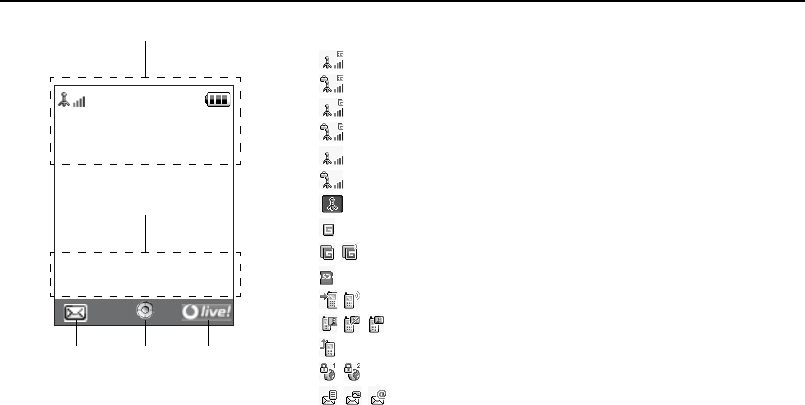
27
Getting Started
Display Indicators (Main Display)
1. : 3G (UMTS)/GPRS within or out of range
: 3G (UMTS)/GPRS within or out of range [roaming]
: GSM/GPRS within range
: GSM/GPRS within range [roaming]
: GSM/GPRS out of range
: GSM/GPRS out of range [roaming]
2. : Offline mode [enabled]
3. : Data exchange with external device
4. / : Connection to the server [established/communicating]
5. : Memory card inserted
6. / : Voice call [incoming/in progress]
7. / / : Video call communication mode enabled
8. : Diverts set to “All Calls”
9. / : Secure WAP page displayed [SSL1/SSL2]
10. / / : Alerts [text message/multimedia message/email]
01.01.05
12:00
I
n
di
ca
t
or area
Right soft
key
Left soft
key
Centre key
Indicator area
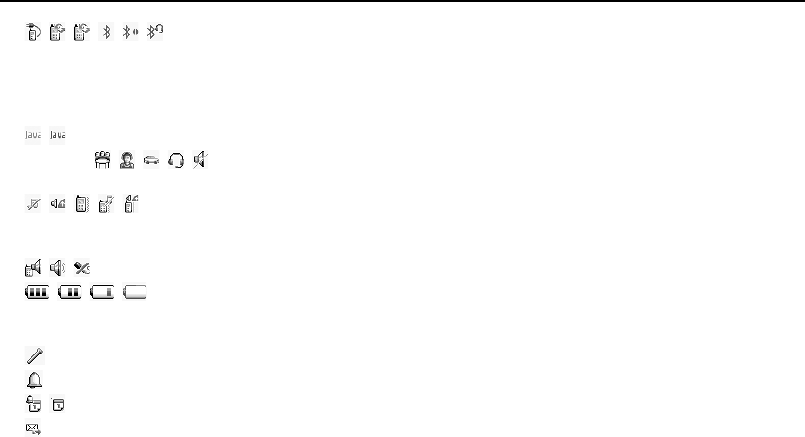
28
Getting Started
11. /////:
Connection status
[USB cable/2nd IrDA paired/IrDA exchanging information/
Bluetooth
wireless setting [enabled (during stand-by or except during stand-by)/
exchanging information/talking with the Bluetooth headset]]
12. / : Java™ application [executed (colour)/suspended (grey)]
13.(No display)/////:
Current profile [Normal/Meeting/Activity/Car/Headset/Silent]
14. ////:
Silent/vibration setting [silent/step tone/vibration enabled/silent and
vibration enabled/step tone and vibration enabled]
15. / / : Speaker mode [speaker phone/speaker activated/microphone muted]
16. ///:
Battery level [sufficiently charged/charging recommended/charging
required/empty]
17: : Mobile light enabled
18. : Daily alarm enabled
19. / : Schedule entry enabled [with/without reminder alarm]
20. : Outbox contains unsent messages [text message/multimedia/email]

29
Getting Started
21. / / : WAP/OTA provisioning alerts [WAP alert/OTA provisioning alert/WAP and
OTA provisioning alerts]
22. : Voicemail message alert
23. : Connection status [1st IrDA communication [enabled/exchanging
information]]
24. : Phone Lock enabled
25. : Keypad Lock enabled
26. /(blank): IrDA setting [enabled/disabled]
27. 12:00: Clock
28. 01.01.05: Date
29. (Operator name)
30. (Cell Broadcasts information)
Soft Key Indicators
To execute the operation indicated, press the corresponding key.
31. Area at the lower left of the screen:
Display the operation executed by the left soft key.
32. Area at the lower right of the screen:
Display the operation executed by the right soft key.
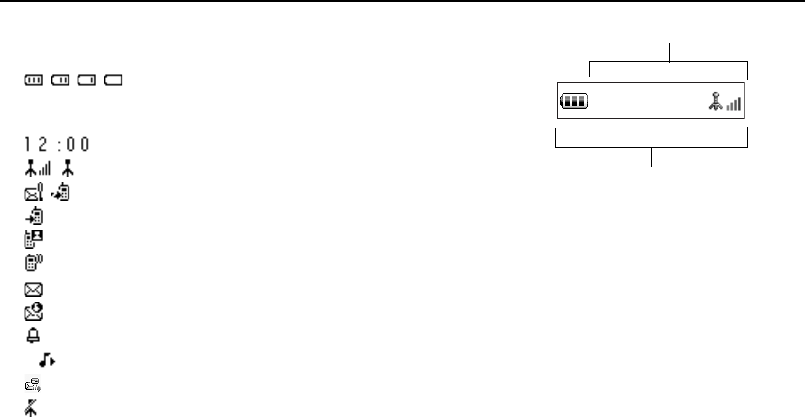
30
Getting Started
Display Indicators (External Display)
Status Indicators
1. ///:
Battery level [sufficiently charged/charging recommended/charging
required/empty]
2. : Clock
3. / : Strength of received signal/Service out of range
4. / : Missed events (up to 4)
5. : Voice call incoming
6. : Video call incoming
7. : Call in progress
8. : Alerts [messages/Delivery Report]
9. : WAP Push service
10. : Daily alarm enabled
11. : Sound file being played
12. : Mail message being sent
13. : Offline mode
M
essage area
12:00
Indicator area

31
Getting Started
14. (stopwatch/countdown timer)
15. : OBEX data incoming
16. : Voice Recorder activated
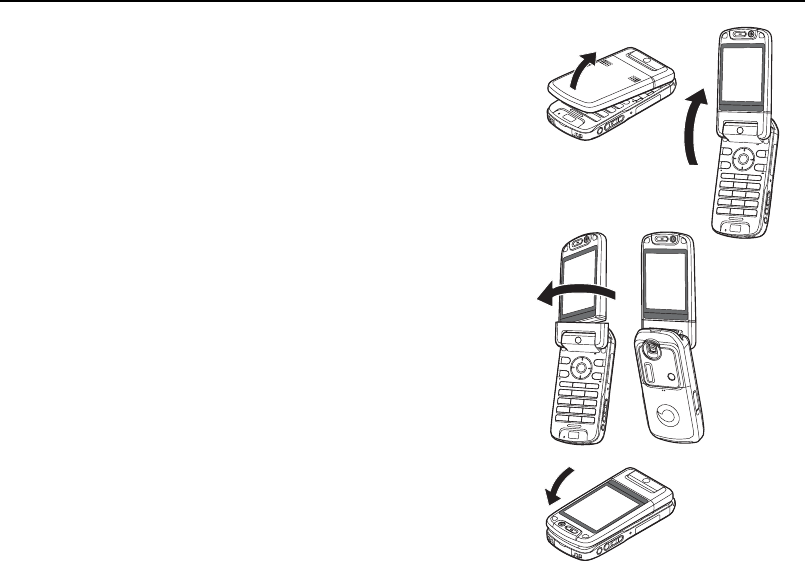
32
Getting Started
Opening Your Phone
Your phone can be opened in the following three positions: normal, self-portrait and viewer
positions.
Normal Position
1. Open the phone until the display stops as illustrated.
Self-portrait Position
2. Turn the display 180° clockwise.
Use this position to take a self-portrait position with the external camera.
Do not turn the display counterclockwise as this may damage it.
Viewer Position
3. Close the main display toward the keypad.
Note
•Operations of the side-up and side-down keys are reversed in the viewer position of the
display.
•Keypad operations cannot be performed in the viewer position of the display.
•Do not carry the phone in the viewer position of the display as this may damage the
display.

33
Navigating Functions
Using in the Normal Position of the Display
All applications are accessed from the Main menu. To open the Main menu, press the centre
key ( ) during stand-by.
To launch applications, you will need to highlight menu items, and make selections. To
select a menu item (indicated in quotation marks), move the cursor using a, b, c and
d, and press to select.
In certain procedures, you will need to press one of the soft keys (indicated in square
brackets), which are displayed at the bottom left and right of the screen. Press the
corresponding soft key (A or C).
To return to the previous screen, press the right soft key if it displays
Back
. To close the
Main menu, press the right soft key if it displays
Exit
.
Each section in this user guide starts with a list of items you will need to select in order
(indicated in italics) before performing the procedures shown. Select each item to reveal the
next set of items that you have to select. Open subsection items after opening those listed
in the main section.
Example:
“Contacts”
→
“Contacts List”
→
“Add New Contact”

34
Navigating Functions
Using in the Viewer Position of the Display
Available keys in viewer position of the display are the side-up and side-down keys, camera
key and cancel key.
To open the Main menu, press the camera key during stand-by.
To select a menu item (indicated in quotation marks), press the side-up and side-down keys
and press the camera key to select.
In certain procedures, you will need to press one of the soft keys (indicated in square
brackets), which are displayed at the bottom left and right of the screen. The left soft key is
the camera key and right soft key is the cancel key.
The side keys function in camera mode as follows:
Side-up/Side-down keys: Zoom-in/Zoom-out
Camera key: Capture
Cancel key: Options
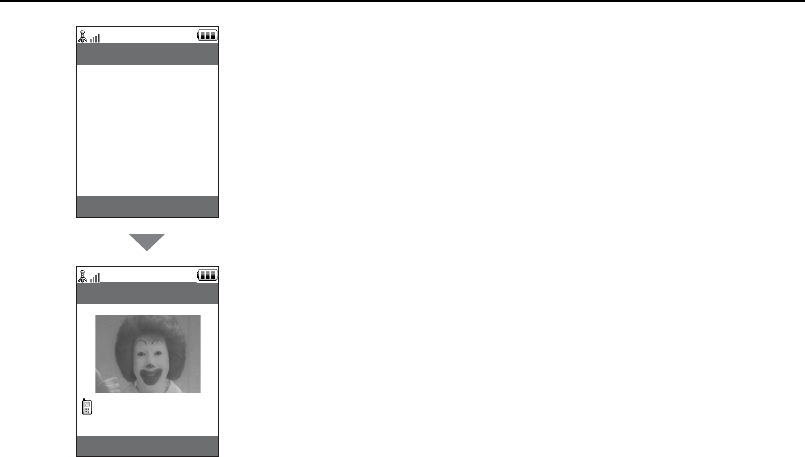
35
Voice Call/Video Call Functions
Making a Voice Call
1. Enter the area code and the phone number you wish to dial and press D to dial.
If you enter the wrong number, press [Clear] to delete the number to the left of the
cursor.
Emergency Calls
1. Enter 112 or 911 (international emergency number) using the keypad and press D
to dial.
Note
•Emergency calls may not be able to be made on all mobile phone networks when certain
network services and/or phone features are in use. Contact your network operator for
more information.
•This emergency number can normally be used to make an emergency call in any country,
with or without a SIM card inserted, if a UMTS/GSM network is within range.
Options Back
Enter Number:
XXXXXXXXXXX
End Call
Voice Call
xxxx
XXXXXXXXXXX

36
Voice Call/Video Call Functions
International Calls
1. Press and hold Q until a + (international dialling prefix) sign is displayed.
2. Enter the country code, followed by the area code (without the leading zero) and the
phone number, and press D to dial.
Adding an Entered Phone Number to the Contacts List
1. After entering a phone number, press [Options] and select “Save Number”.
For details on creating a new entry, see “Add New Contact” on page 54.
Showing or Hiding My Phone Number on the Display of the Called Party
1. After entering a phone number, press [Options] and select “Hide My ID” or “Show
My ID”.
Speed Dialling
Up to 8 phone numbers from the Contacts List memory (Handset and SIM) can be assigned
to speed dials. You can call the numbers using the digit keys (G to O). The phone
number of the Voice mail centre is assigned to G.
For details on setting the speeddial list, see “Speeddial List” on page 60.
1. To dial a number using the speed dial, press and hold any of the digit keys (G to
O).
The phone number saved in the speeddial list is dialled.

37
Voice Call/Video Call Functions
Redialling
You can redial numbers in the call log. Select from specific categories or “All Calls”. Specific
categories contain up to 10 numbers and the “All Calls” list contains up to 30.
1. Press D during stand-by.
2. Select the category from “All Calls”, “Dialled Calls”, “Missed Calls” or “Received
Calls”.
To switch logs, press c or d.
3. Highlight the phone number you wish to call.
4. Press D to redial the call.
Answering a Voice Call
When an incoming call is detected, the phone rings.
1. Press D or [Answer] to answer the call.
Or press any key except F and [Busy] when the “Any Key Answer” function is enabled.
Set the Any Key Answer function in the profile of each mode (p. 176).

38
Voice Call/Video Call Functions
Tip
•If you have subscribed to the Calling Line Identification (CLI) service and the caller’s
network sends the number, the caller’s number is displayed on the screen. If the caller’s
name and number are saved in the Contacts List, the caller’s name and phone number
are displayed on the screen.
•If the number is a restricted number, the display shows “Withheld”.
•When you receive a call from the person whose picture is registered in the Contacts List,
the picture, name and phone number are displayed.
Rejecting an Incoming Call
1. Press F while the phone is ringing to reject a call you do not wish to answer.
Letting the Caller Know You are Unavailable
1. Press [Busy] while the phone is ringing to send a busy tone to the caller of an
incoming call letting them know that you cannot answer the call.

39
Voice Call/Video Call Functions
Incall Menu (Voice Call)
Your phone has additional functions available while a call is in progress.
Adjusting the Earpiece Volume
During a call, you can adjust the earpiece volume (and handsfree volume, if connected).
1. During a call, press the side-up or side-down key to display the Earpiece Volume
screen.
2. Press the side-up key (or a/d) to increase the volume of the call or press the
side-down key (or b/c) to decrease the volume.
Five levels (level 1 to 5) can be selected.
3. Press when the volume is set to the desired level.
The phone returns to the in-call screen automatically if left unoperated.
Turning the Stereo Speakers On and Off
You can turn the stereo speakers on to hear the voice of the called party.
The stereo speakers are located on the back of the phone.
1. During a call, press [Options] and select “Loud Speaker On”.
Putting a Call on Hold
This function allows you to manage two calls at the same time. If you wish to make another
call while you are talking to someone, you can put the current call on hold to call someone
else.

40
Voice Call/Video Call Functions
To Make Another Call during a Call
1. During a call, press [Options] and select “Hold”.
The current call is put on hold.
2. Press [Options] and select “Dial New Number”.
3. Enter the phone number you wish to make another call to, then press D.
Tip
•You can also make another call by entering the phone number during a call instead of
step 1. The current call is automatically put on hold.
Accessing SMS/MMS Menu during a Call
1. During a call, press [Options] and select “Send Message”.
The following options are available: “Create Messages” to make an SMS and MMS, or
“Inbox”, “Sent” or “Drafts” to access these folders. For details on SMS, see “SMS” and
“MMS” on page 87.
Call Waiting
This service notifies you of another incoming call while you have a call in progress.
1. During a call, press [Options] and select “Hold & Answer” to answer the second call.
The first call is put on hold and you can now talk to the second caller.
2. Press [Options] and select “Release & Answer” to end the current call and return to
the held call.

41
Voice Call/Video Call Functions
Note
•You need to set “Call Waiting” to “On” if you use the Call Waiting service (p. 189).
•Call Waiting service may not be available on all networks. Contact your network operator
for more information.
•If you do not wish to answer the second call, press [Options] and select “Busy” in step 1.
If “Reject” is selected, the log of the second call is saved as a missed call.
Conference Call
Conference call is a call with more than 2 participants. You may include up to 5 participants
in a conference call.
To Make a Conference Call
You must have one active call and one held call.
1. During a call, press [Options] and select “Multi Party”.
2. Select “Conference All” to join the conference call.
3. Press F to end the conference call.
Note
•The conference call service may not be available on all networks. Contact your network
operator for more information.
•You have more options for the Conference call in step 2:
•To put all participants on hold, select “Hold All”.
•To put all participants except the current call on hold, select “Private”.

42
Voice Call/Video Call Functions
•To end the call with all participants, select “End Active Call(s)” or “End Held Call(s)”.
•To reject adding more participants to the current party, press [Options] and select
“Reject”, or you can send the busy tone by selecting “Busy”.
To Add New Participants to the Conference Call
1. Press [Options] and select “Dial New Number”.
2. Enter the number you wish to include in the conference call and press D to dial.
3. Press [Options] and select “Multi Party”.
4. Select “Conference All” to join the conference call.
If you wish to add other participants, repeat steps 1 to 4.
To End the Call with a Conference Call Participant
1. During a conference call, highlight the person that you wish to disconnect from the
conference call.
2. Press [Options] and select “End Active Call(s)” or “End Held Call(s)”.
To Have a Private Conversation with One of the Participants
If you wish to have a private conversation with one of the participants, you may select the
participant from the conference list and put the other participants on hold.
1. During a conference call, select the person that you wish to talk to.
2. Press [Options] and select “Multi Party”.
3. Select “Private”.
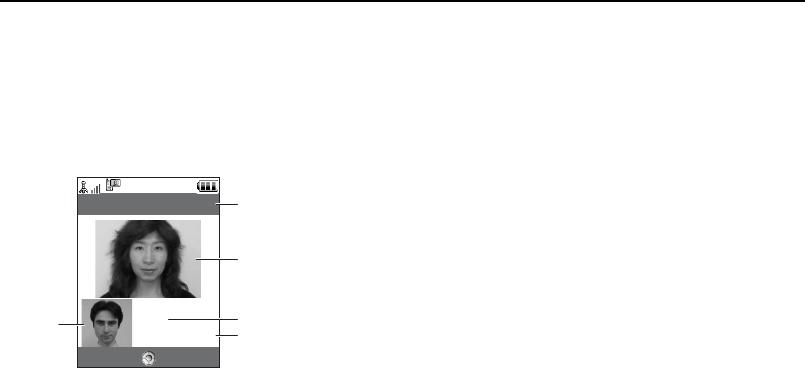
43
Voice Call/Video Call Functions
4. Once you have finished the private conversation, press [Options] and select
“Multiparty”.
5. Select “Conference All” to return to the conference call.
Muting the Microphone
1. During a call, press [Mute] to mute the microphone.
To unmute the microphone, press [Unmute].
Making a Video Call
Note
•Use this function with only the video call enabled phones.
•Make sure that the battery is fully charged and the signal length is greater before using
this function.
•Turn the stereo speakers on or use a switch-equipped earphone microphone or
handsfree kit so that you can talk while looking at the video call screen on the main
display.
Status Indicators
1. Sub screen for your image
2. Elapsed time (hour:minute:second)
3. Main screen for the calling party’s screen
4. Calling party’s name
5. Calling party’s phone number
Options Mute
Video Call '0:00:02
xxxx
XXXXXXXXXXX
2
3
4
5
1

44
Voice Call/Video Call Functions
Making a Video Call
1. Enter the area code and the phone number you wish to dial and press [Options] and
select “Video Call” to dial.
If you enter the wrong number, press [Clear] to delete the number to the left of the
cursor.
When the line is connected, the image of the called party is displayed upper on the
screen, and yours lower left.
Tip
•If the called party’s phone is not video call enabled, you can press F and enter the
phone number again to make a voice call.
•When the call ends, the last call cost is displayed.
Answering a Video Call
When an incoming call is detected, the phone rings.
1. Press D to answer the call by video or A [Voice] to answer the voice only.

45
Voice Call/Video Call Functions
Tip
•When the call is ended, the call cost is displayed.
•When receiving a voice or video call during a video call, the phone number and a name
are displayed under the time indicator. Press [Options] and select the desired menu.
•If you have subscribed to the Calling Line Identification (CLI) service and the caller’s
network sends the number, the caller’s number is displayed on the screen. If the caller’s
name and number are saved in the Contacts List, the caller’s name and phone number
are displayed on the screen.
Rejecting an Incoming Call
1. Press F while the phone is ringing to reject a call you do not wish to answer.
Letting the Caller Know You are Unavailable
1. Press [Busy] while the phone is ringing to send a busy tone to the caller of an
incoming call letting them know that you cannot answer the call.
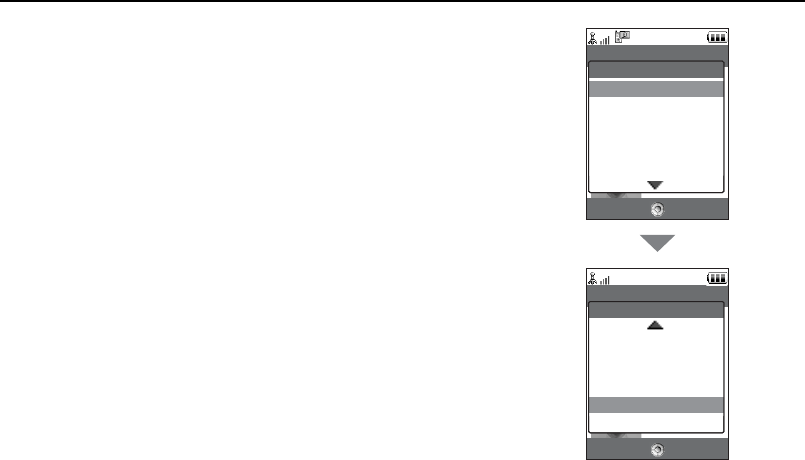
46
Voice Call/Video Call Functions
Incall Menu (Video Call)
Muting the Microphone
1. During a call, press [Mute] to mute a microphone.
To unmute the microphone, press [Unmute].
Swapping Images
You can swap images between the main and sub screens.
1. During a video call, press [Options] and select “Swap Images”.
Changing the Image of Yourself
1. During a video call, press [Options] and select “Camera Picture”.
2. Select from “Use Internal Camera”, “Use External Camera” or “Alternative Image”.
“Use Internal Camera”: The image through the internal camera is displayed and sent
to the party.
“Use External Camera”: The image through the external camera is displayed and sent
to the party.
“Alternative Image”: The camera is turned off and the image selected in
“Alternative Image” of “Video Call Settings” (p. 194) is used.
Select Back
Video Call '0:00:02
Options
Mute Microphone
Swap Images
Camera Picture
Enable Opt. Zoom
Switch Loud Speaker On
Select Back
Video Call '0:00:02
Options
Switch Loud Speaker On
Video Call Settings
DTMF Tones On
Hold/Retrive
Open Contacts

47
Voice Call/Video Call Functions
Using the Optical Zoom Function
The optical zoom enables you to zoom the picture more clearly by the actual zooming action
of the optical lens. The optical zoom is used up to the [×2] zooming ratio. If you increase the
ratio more than that, it is replaced by the digital zoom.
1. During a video call, press [Options] and select “Enable Opt. Zoom”.
The image is magnified.
Turning the Stereo Speakers On and Off
You can turn the stereo speakers on to hear the voice of the called party.
The stereo speakers are located on the back of the phone.
1. During a call, press [Options] and select “Switch Loud Speaker On”.
Video Call Settings
To Change the Quality of the Incoming Image
You can adjust the quality of the called party’s image.
1. During a video call, press [Options] and select “Picture Quality”.
2. Select “Normal”, “Quality Prior” or “Frame Rate Prior”.
“Normal”: The standard quality is used.
“Quality Prior”: The quality of the picture takes precedence over the frame
rate.
“Frame Rate Prior”: The frame rate takes precedence over the quality.

48
Voice Call/Video Call Functions
To Turn the Backlight On or Off
You can turn on the backlight of your screen.
1. During a video call, press [Options] and select “Video Call Settings”.
2. Select “Backlight”.
3. Select from “On”, “Depend on Backlight” or “Off”.
When “On” is selected, the backlight will always be on during a video call.
When “Depend on Backlight” is selected, the backlight will time out depending on the
Backlight setting (p. 181).
To Adjust the Video Exposure
1. During a call, press [Options] and select “Video Call Settings”.
2. Select “Exposure”.
3. Press a (Light) or b (Dark).
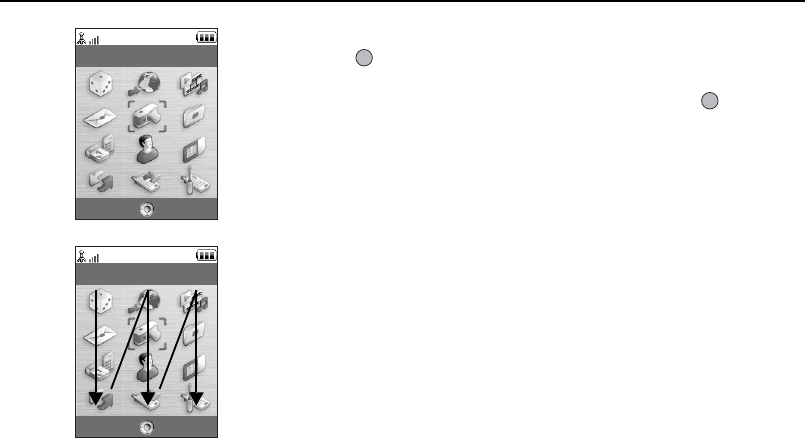
49
Using the Menu
Top Menu
1. Press during stand-by.
The Main menu is displayed.
2. Press a, b, c or d to highlight the desired menu, then press to access the
function.
The sub menu is displayed.
For details on the menu options, see the table on pages 246 and 247.
Using the Menu in the Viewer Position of the Display
1. Set the phone in the viewer position of the display.
2. Press the camera key to display the main menu.
3. Press the side-up or side-down key to move the focus up or down, then press the
camera key.
Press the cancel key to return to the Main menu.
The focus moves the same as in the normal position of the display by using the side-up
and side-down keys illustrated by arrows.
For details on the functions of these keys, see page 16.
Select Exit
Camera
Select Exit
Camera

50
Using the Menu
Shortcuts
Your phone has a shortcut key (assigned to the shortcut key: S) with which you can
access the desired menu quickly. The default shortcuts are as follows, which you can later
customise:
• Dialled Calls
•Received Calls
• Calendar
•Calculator
• Voice Recorder

51
Using the Menu
To Use the Shortcuts
1. Press the shortcut key.
2. Select the desired item.
To Customise the Shortcuts
1. Press the shortcut key.
2. Press [Options] and select “Assign”.
The list of the available items is displayed.
3. Select the desired item.
Note
•To move the item in the list that appears in step 1, highlight the item, press [Options] and
select “Move”.
Then press a or b to the desired location and press .

52
Contacts List (M 8-1)
You can store the phone numbers and email addresses of your friends, family and
colleagues in the Contacts List.
Your phone can store up to 500 entries. In a Contacts List, you can save the following items:
Items Saved in the Handset Memory
First name: up to 16 characters
Last name: up to 16 characters
Add Telephone: up to 32 digits
Tel 2 (displayed if “Add Telephone” is entered): up to 32 digits
Tel 3 (displayed if “Tel 2” is entered): up to 32 digits
Add Email Address: up to 128 characters
Email 2 (displayed if “Add Email Address” is entered): up to 128 characters
Email 3 (displayed if “Email 2” is entered): up to 128 characters
Group: 16 groups (Group names can
be edited by the Manage
Group menu.)
Street name: up to 64 characters
City name: up to 64 characters
State name: up to 64 characters
Zip code: up to 20 characters
Country name: up to 32 characters
Note: up to 256 characters
Select Back
Contacts
Contacts List
Manage Group
Speeddial List
My Contact Details
Advanced

53
Contacts List
Birthday:
Picture:
Assign Tone/Video (For Voice Call, For Video Call, For New Messages):
Secret:
Items Saved in the SIM Memory
Name: up to 16 characters
Add Telephone: up to 32 digits
Tel 2 (displayed if “Add Telephone” is entered):
up to 32 digits
Add Email Address: up to 80 characters
Group: 16 groups (Group names can be edited using the Manage
Group option.)
Using the infrared or
Bluetooth
wireless function, you can send the Contacts List entry to a
PC to share the same entries.
Changing the Name Order
“Contacts”
→
“Advanced”
→
“Name Order”
1. Select “First-Last Name” or “Last-First Name”.
Changing the List Displayed
“Contacts”
→
“Advanced”
→
“Contacts Location”
1. Select “Handset” or “SIM”.

54
Contacts List
Selecting the Storage Memory
“Contacts”
→
“Advanced”
→
“Save New Contact to”
1. Select the Contacts location from “Handset”, “SIM” or “Choice”.
Tip
•“Choice” prompts you to choose the memory every time you save a new entry.
Changing the Contact List Order
You can change the listing order of the Contacts List entries between by alphabet order or
by group.
“Contacts”
→
“Advanced”
→
“View Contacts”
1. Select “By Alphabet” or “By Group”.
Add New Contact
You can choose either the phone or SIM card memory locations to store the new entry. For
switching locations, see “Selecting the Storage Memory”.
The amount of phone numbers that you can store to the SIM card is dependent on its
capacity. Contact your network operator for details.
“Contacts”
→
“Contacts List”
→
“Add New Contact”
If you select the “Choice” option for the memory to be used, the selection is between
“Handset” and “SIM”.
1. Select the field you wish to fill in, and enter the relevant information.
2. Press [Save] when finished.

55
Contacts List
Tip
•To create an entry, at least one field must be filled (“First name”, “Last name”, “Add
Telephone” or “Add Email Address” for the handset memory; “Name”, “Add Telephone”
or “Add Email Address” for the SIM memory).
Adding a Thumbnail to Entries
“Contacts”
→
“Contacts List”
1. Highlight the desired entry.
2. Press [Options] and select “Edit”.
3. Select “Picture:”.
4. Select “Assign Picture”.
5. Select the desired picture.
6. Press [Save] when finished.
Note
•If you delete a picture in Saved Pictures, the corresponding thumbnail is also deleted.
Viewing My Contact Details
You can register and edit your own contact as other Contacts List entries.
“Contacts”
→
“My Contact Details”
(M 8-4)

56
Contacts List
Copying Contacts List Entries between SIM Card and Handset
“Contacts”
→
“Advanced”
→
“Copy All Entries”
1. Select “SIM to Handset” or “Handset to SIM”.
Note
•When you insert the SIM card into your phone for the first time and start the Contacts List
application, the confirmation screen is displayed automatically, asking you if you wish to
copy or not. The number of Contacts List entries to be copied varies depending on the
SIM capacity.
•If the memory space is not enough to save all entries, you cannot complete copying.
Finding a Name
“Contacts”
→
“Contacts List”
1. Enter the first few letters of the name.
Search results are displayed in alphabetical order.
Tip
•You can select the Contacts location from “Handset” or “SIM” before searching.
Dialling from the Contacts List
“Contacts”
→
“Contacts List”
1. Highlight the desired entry and press D.

57
Contacts List
Tip
•If more than one phone number is registered for the entry, highlight the desired phone
number after step 1 and press D.
•You can also dial from the details screen of the Contacts List. On the details screen, select
the desired phone number and press D.
Editing Contacts List Entries
“Contacts”
→
“Contacts List”
1. Highlight the entry you wish to edit.
2. Press [Options] and select “Edit”.
3. Modify the information.
4. Press [Save] when finished.
Deleting Contacts List Entries
Deleting All Contact Entries
“Contacts”
→
“Advanced”
→
“Delete All Entries”
1. Select “Handset Entries” or “SIM Entries”.
2. Enter your handset code.
The default handset code is “9999”. For details on changing the handset code, see “To
Change the Handset Code” on page 198.

58
Contacts List
Deleting a Contact Entry
“Contacts”
→
“Contacts List”
1. Highlight the desired entry.
2. Press [Options] and select “Delete”.
Manage Group
Different ringtones can be set for each group. If you do not change a group ringtone, the
ringtone assigned in the Settings menu is used.
“Contacts”
→
“Manage Group”
1. Highlight the desired group.
2. Press [Options] and select “Assign Tone/Video”.
3. Select from “For Voice Call”, “For Video Call” or “For New Messages”.
4. Select “Assign Tone” or “Assign Video”.
When selecting “Assign Video”, go to step 6.
5. Select “Preset Sounds” or “My Sounds”.
6. Select the desired tone or video clip.
For details on selecting a ringtone or a ring video clip, see “Assigning a Ringtone or a
Ring Video Clip to Each Contacts List Entry” on page 59.
Note
•You can only edit group names in the SIM card. You cannot edit the ringtone or ring video
settings.
(M 8-2)

59
Contacts List
Editing the Group Name
You can edit group names to be assigned to the Contacts List entries. First, change the
Contacts List displayed (p. 53).
“Contacts”
→
“Manage Group”
1. Highlight the desired group name.
2. Press [Options] and select “Edit Name”.
3. Modify the name.
Assigning a Ringtone or a Ring Video Clip to Each Contacts List
Entry
A specified ringtone or vibration setting can be associated to a pre-registered entry.
“Contacts”
→
“Contacts List”
1. Highlight the desired entry.
2. Press [Options] and select “Edit”.
3. Select “Assign Tone/Video”.
4. Select “For Voice Call”, “For Video Call” or “For New Messages”.
5. Select “Assign Tone” or “Assign Video”.
6. Select the desired tone or video clip.
7. Press [Save] when finished.

60
Contacts List
Tip
•For details on selecting a ringtone or a ring video clip in the Settings menu, see
“Assigning a Ringtone” on page 172 or “Assigning a Ring Video Clip File” on page 173.
Memory Status
This function helps you to check the memory used in the Contacts List.
“Contacts”
→
“Advanced”
→
“Memory Status”
Speeddial List
You can set a maximum of 8 phone numbers in the speeddial list (p. 36).
Setting Contacts List Entries in the Speeddial List
“Contacts”
→
“Contacts List”
1. Select the desired entry.
2. Highlight the desired phone number.
3. Press [Options] and select “Add to Speeddial”.
4. Select the desired location.
Tip
•The nine digit keys correspond to list numbers.
•To view the speeddial list, see “Speed Dialling” on page 36.
(M 8-3)

61
Contacts List
To Edit the Speeddial List
“Contacts”
→
“Speeddial List”
1. Highlight the entry you wish to edit.
2. Press [Options] and select the desired option.
“Re-Assign” (displayed when a phone number is already assigned):
Displays the Contacts List entries. Select (Reassign) other entries.
“Assign” (displayed when no phone number is assigned):
Displays the Contacts List entries. Select (assign) the desired entry.
“View”: Displays the assigned phone number.
“Delete”: Deletes the selected phone number from the speeddial list.
“Clear All”: Clears all phone numbers from the speeddial list.
Sending a Contacts List Entry
“Contacts”
→
“Contacts List”
1. Highlight the desired entry.
2. Press [Options] and select “Send Contact”.
3. Select “As Message”, “Via Bluetooth” or “Via Infrared”.

62
Contacts List
For “As Message”
For details, see “MMS” on page 87.
For “Via Bluetooth”
For details, see “Bluetooth” on page 205.
For “Via Infrared”
For details, see “Infrared” on page 211.
Receiving a Contacts List Entry
When the phone receives a Contacts List entry, a confirmation message is displayed during
stand-by.
1. Press [Yes].
The received entry is saved in the Contacts List. Press [No] to reject.
Tip
•For details on making Infrared or Bluetooth wireless settings, see “Connectivity” on
page 205.
•For details on making MMS settings, see “MMS Settings” on page 102.
Call Costs
This function lets you check the charges for your calls.
For details, see “Call Costs” on page 203.
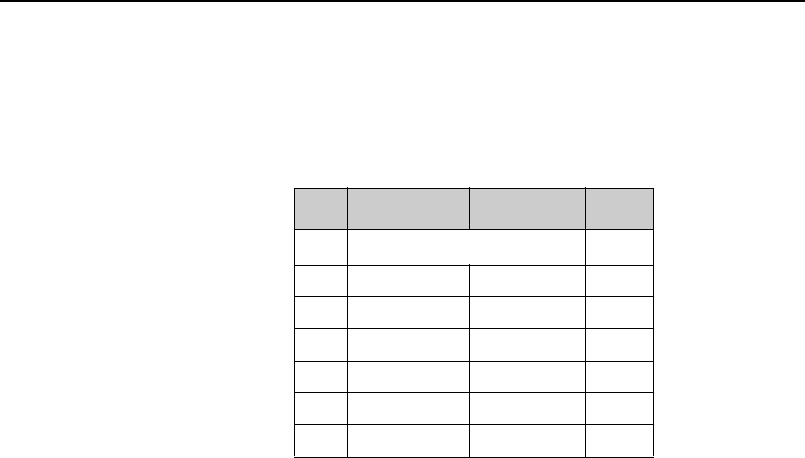
63
Entering Characters
When entering characters to create Contacts List entries, text messages or multimedia
messages, etc., press the corresponding keys.
In multi-tap input method, press each key until the desired character is displayed. For
example, press H once for the letter A or twice for the letter B.
Table of Characters
Pressing each key scrolls characters in the following order. The order varies depending on
the language selected.
English Mode
Key Upper Case
Characters Lower Case
Characters Numeric
G. (full-stop) , (comma) - (hyphen) ? !
’ (apostrophe) @ :1 1
HABC2 abc2 2
IDEF3 def3 3
JGHI4 ghi4 4
KJKL5 jkl5 5
LMNO6 mno6 6
MPQRS7 pqrs7 7

64
Entering Characters
NTUV8 tuv8 8
OWXYZ9 wxyz9 9
Q(space) + = < > € £ $ ¥ % & 0 0
PSwitches character case between four modes:
Abc, ABC, 123 and abc.
R
.,?!:;-+#∗
@' " ( ) _&€£$
%/ ˜<>§=\ | ¥
¿¡^[ ]{ }¤ÅÄ
Æå äæàÇÉèé ì
ÑñÖØöøòßÜü
ù∆ΦΓΛΩΠΨΣΘ
Ξ (space) ø
G-O:
QPress and hold to enter 0 - 9 numbers.
P: Press and hold to shift between multi-tap and T9 mode.
R: Press and hold to display the Input Language screen.
Key Upper Case
Characters Lower Case
Characters Numeric

65
Entering Characters
Changing the Input Languages
You can change the input language on the text entry screen.
1. On the text entry screen, press [Options] and select “Input Language”.
2. Select the desired language.
Changing the Input Mode
T9 Text Input
T9 text input method is a shortcut to enter text easily and quickly.
1. On the text entry screen, press and hold P to enter T9 mode.
2. Press [Options] and select “Input Mode”.
3. Select the input mode (Abc, ABC, abc, 123).
4. Press each key once for any letter you require on that key.
To enter the word “How”, press J L O.
5. If the word shown isn’t the one you want, press a or b until you highlight the
correct one.
6. Press to select the word.
Note
•If the correct word is not shown in step 5, enter the correct word again after switching to
the multi-tap input method.

66
Entering Characters
Tip
•If you press Q instead of step 6, a space is inserted next to the selected word.
Symbols and Punctuation
1. On the text entry screen, press [Options] and select “Add Symbol”.
2. Select the desired symbol.
My Dictionary
You can create your own word list for T9 text input.
1. On the text entry screen in T9 mode, press [Options] and select “My Dictionary”.
2. Select “Add New Word” and enter a new word.
To edit a word in the list
1. On the text entry screen in T9 mode, press [Options] and select “My Dictionary”.
2. Highlight the desired word.
3. Press [Options] and select “Edit”.
4. Modify the word.

67
Entering Characters
Using Templates
You can use the sentences registered in Text Templates when entering characters.
For details on creating the text template, see “Adding Phrases to Text Templates” on
page 138.
1. On the text entry screen, move the cursor to the point you wish to insert the
template.
2. Press [Options] and select “Advanced”.
3. Select “Insert Template”.
4. Select the desired text template.
The selected text template is inserted.
Copying, Cutting and Pasting Text
By using these options, you can carry out editing smoothly.
To Copy and Cut Text
1. On the text entry screen, press [Options] and select “Advanced”.
2. Select “Copy” or “Cut”.
3. Move the cursor to the first letter to be copied or to be cut, then press .
4. Move the cursor to the last letter to highlight the area, then press .

68
Entering Characters
To Paste Text
1. On the text entry screen, move the cursor to the point you wish to paste the letters.
2. Press [Options] and select “Advanced”.
3. Select “Paste”.
The saved text is pasted.
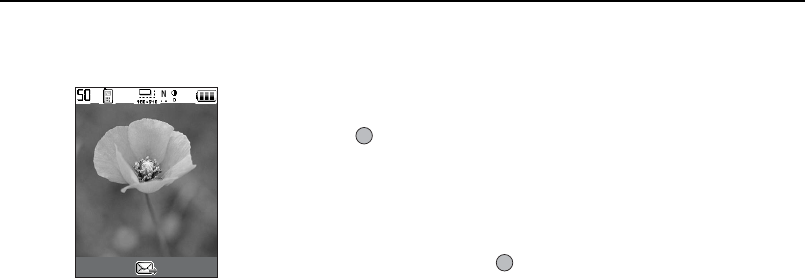
69
Camera (M 5)
Your phone has an integrated digital camera.
This allows you to shoot and send pictures and video clips wherever you are.
Taking Pictures
“Camera”
1. Press to take the picture.
The shutter sounds and the still image of the taken picture is displayed.
2. Press [Save].
To cancel, press [Cancel].
The taken picture is saved in My Items.
Note
•Press the camera key instead of in the viewer position of the display.
•When the digital camera is not activated, press [Options] and select “Goto Photo
Camera”, or press d.
Taking a Self-Portrait
You can take a self-portrait while looking at the main display.
1. Rotate the main display 180° clockwise from the normal position.
2. Press the camera key on the side of the phone.
Save Cancel

70
Camera
Note
•Do not rotate the main display anti-clockwise. Otherwise, the phone may malfunction.
Sending Taken Pictures
You can send the taken picture via “With Message”.
“Camera”
1. Press to take the picture.
2. Press .
3. Select the send option.
For details, see “Creating a New Message” on page 87. After the message has been
sent, the taken picture is stored in My Items. (The resized picture is not saved in My
Items.)
Note
•When you try to send the picture that has too large a file size, the picture size is resized
for the message. The original sized picture is saved in My Items.

71
Camera
Selecting the Picture Size
You can select the size of pictures. All taken pictures are saved in the JPEG format.
“Camera”
→
[Options]
→
“Picture Settings”
→
“Picture Size”
1. Select the desired size.
Picture Sizes: 1224 ×1632 dots
960 ×1280 dots
768 ×1024 dots
480 ×640 dots
240 ×320 dots
120 ×160 dots
120 ×128 dots
Using the Digital Zoom Function
To Adjust the Zooming Ratio
1. In the viewfinder mode, press a or b.

72
Camera
To Enable or Disable the Optical Zoom
The optical zoom enables you to zoom the picture more clearly by the actual zooming action
of the optical lens. The optical zoom is used up to the [×2] zooming ratio. If you increase the
ratio more than that, it is replaced by the digital zoom.
“Camera”
→
[Options]
→
“Advanced”
1. Select “Enable Opt Zoom”.
Select “Disable Opt Zoom” to disable.
If you select “Disable Opt Zoom”, you can only use the digital zoom function.
2. Press a (or c/the side-up key) or b (or d/the side-down key).
Adjusting the Exposure
“Camera”
→
[Options]
→
“Picture Settings”
→
“Exposure”
1. Press a (Bright) or b (Dark).
Picture brightness (exposure level) indicators
: (Bright → Normal → Dark)
Once the phone has returned to the stand-by screen, the brightness settings return to
default.
Mobile Light
To Change the Light Colour
You can take a picture in various colour modes.
“Camera”
→
[Options]
→
“Picture Settings”
→
“Mobile Light”
→
“Light Colour”
1. Select the desired light colour.
Light Colours: White/Red/Yellow/Green/Blue/Violet/Light Blue/Disco

73
Camera
To Change the Mobile Light Mode
Set the mobile light according to your purpose.
“Camera”
→
[Options]
→
“Picture Settings”
→
“Mobile Light”
→
“Switch On/
Off”
1. Select the desired mode.
“On” ( ): The light is always on.
“Auto” ( ): The light turns on if the phone detects that the conditions are dark.
“Low Light” ( ): Select this mode for macro shooting.
“Off”: The light is always off.
The corresponding indicator is displayed on the screen. Select “Off” to turn it off.
Using the Timer (Timer)
“Camera”
→
[Options]
→
“Camera Modes”
→
“Timer”
1. Select “On” or “Off”.
“ ” is displayed on the screen when you select “On”.
Selecting the Scene
You can select the appropriate mode by scene when you take the picture.
“Camera”
→
[Options]
→
“Picture Settings”
→
“Scene”
1. Select the desired scene.

74
Camera
Continuous Shoot
You can take continuous shots in various options.
“Camera”
→
[Options]
→
“Camera Modes”
→
“Continuous Shoot”
1. Select the desired mode.
The following continuous shoot modes are available:
“Off”: The continuous shots are cancelled.
“4 Pictures”/“9 Pictures”: Takes 4 or 9 pictures continuously.
After selecting this mode, select the desired speed from the
following:
“Very Fast”
“Fast”
“Normal”
“Slow”
“Very Slow”
“Manual”
“Bracket”: Takes 9 continuous pictures with various colours and
brightness levels.
After selecting this mode, press then select “Fast” or
“Normal”.
“Overlapped”: Overlaps continuous pictures into one picture and makes an
afterimage.

75
Camera
Note
•When you select “Manual” to take continuous pictures, press or the camera key (in
the viewer position of the display) manually in the desired speed.
•When the Timer and Continuous Shoot functions are simultaneously set, “ ” (for “4
Pictures”, for example) is displayed instead.
Selecting a Frame
You can select the frame from preset patterns. You can also select a frame in Saved
Pictures.
“Camera”
→
[Options]
→
“Camera Modes”
→
“Photo Frame”
1. Select “Preset Frames” or “My Pictures”.
2. Select the desired frame.
The selected frame is confirmed on the display.
3. Press .
Note
•Images larger than 240 dots [W] × 320 dots [H] cannot be used.
Switching to the Video Camera Mode
You can switch from the camera mode to the video camera mode. You can also switch
between these two modes by pressing d.
“Camera”
→
[Options]
→
“Goto Video Camera”

76
Camera
Using the Full Screen
You can display the preview on the full screen without the soft key area and indicator area.
“Camera”
→
[Options]
→
“Advanced”
1. Select “Full Viewfinder”.
To return to the normal viewfinder, select “Normal Viewfinder”.
Selecting the Picture Quality
“Camera”
→
[Options]
→
“Picture Settings”
→
“Picture Quality”
1. Select the desired picture quality.
Picture quality indicators
: Super Fine
:Fine
:Normal
Selecting the Shutter Sound
You can select the shutter sound from 3 preset patterns.
“Camera”
→
[Options]
→
“Advanced”
→
“Shutter Sound”
1. Select the desired shutter sound.
Note
•Continuous Shoot uses the specialised shutter sound that cannot be changed from the
above settings.

77
Camera
Selecting the Storage Memory
You can select the location to save the taken pictures in.
“Camera”
→
[Options]
→
“Advanced”
→
“Save Pictures to”
1. Select the desired location from “Handset Memory”, “Memory Card” or “Choice”.
Note
•If you select “Choice”, select the desired location every time you save.
•The memory size of an SD memory card depends on its capacity. The phone may not
detect properly an SD memory card that has over 512 MB.
Focus Setting
This function enables you to set the focus mode along with the situation for taking a picture.
“Camera”
→
[Options]
→
“Advanced”
→
“Focus Setting”
1. Select the desired option.
Focus mode indicators
:Normal
:Macro
: Portrait
: Landscape
: Manual Focus

78
Camera
Auto Save
You can set the phone to save pictures automatically.
“Camera”
→
[Options]
→
“Advanced”
→
“Auto Save”
Using the Help Function
“Camera”
→
[Options]
→
“Help”
Exiting from the Viewer Position of the Display
Carry out the following operation when you want to go back from the viewer position of the
display to the normal position.
1. Press (and hold) the cancel key in the viewer position of the display to display the
Options menu.
2. Move the cursor with the side-up and side-down key to highlight “Exit” and press
the camera key.
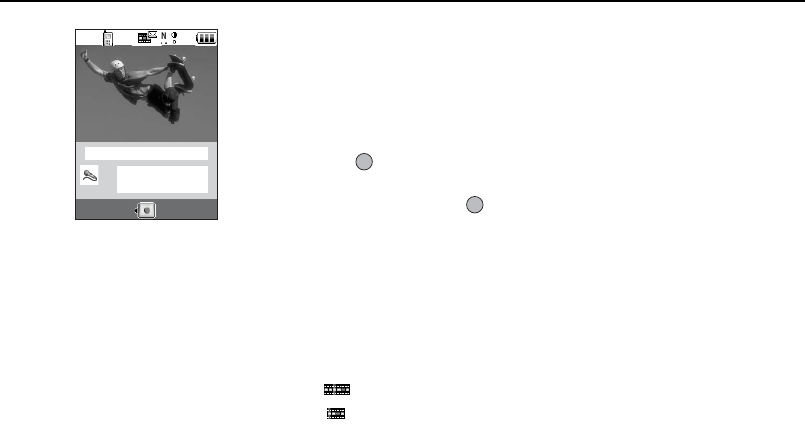
79
Camera
Recording Video Clips
You can record a video clip with your phone. You can also use this function in the viewer
position of the display.
Recording Video Clips
“Camera”
The preview is displayed through the screen.
1. Press .
Press the camera key in the viewer position of the display.
2. To stop recording, press .
To view the preview before saving, select “Play Video”.
3. Select “Save Video”.
The video clip is saved in “My Videos”.
Note
•If you want to record a video clip in landscape, set the phone to the viewer position of the
display while in the viewfinder mode. The display switches to landscape automatically.
•Put the phone into the video camera mode to record a video. Video clips are saved in
“.3gp” format in the following two modes:
For Message: QCIF or SubQCIF
Extended Videos: QCIF, SubQCIF or QVGA (MPEG4)
QVGA (MPEG4) is available when you select “Extended Videos” for the Recording Time
(p. 82) and select QVGA (MPEG4). The video clips are saved in “ASF” format.
Options Back
00:00:00 0KB/ 25KB
10

80
Camera
•The sound can be recorded with a video clip if the microphone is turned on. The default
setting of the microphone is set to “On”. To record a video clip without the sound, turn
off the microphone. For details, see “Recording Video Clips with the Sound” on page 84.
Sending Video Clips
“Camera”
1. Press .
Press the camera key in the viewer position of the display.
2. To stop recording, press .
To view the preview before saving, select “Play Video”.
3. Select “Save and Send”.
Select the desired way you wish to send.
For details, see “Creating a New Message” on page 87.
Note
•You can send video clips only when “For Message” is selected for the recording time. For
details, see “Selecting the Recording Time” on page 82.

81
Camera
Using the Zoom Function
To Adjust the Zooming Ratio
1. In the viewfinder mode, press a or b.
To Enable or Disable the Optical Zoom
The optical zoom enables you to zoom the picture more clearly by the actual zooming action
of the optical lens. The optical zoom is used up to the [×2] zooming ratio. If you increase the
ratio more than that, it is replaced by the digital zoom.
“Camera”
→
[Options]
→
“Advanced”
1. Select “Enable Opt Zoom”.
Select “Disable Opt Zoom” to disable.
Note
•The default setting is “Enable Opt Zoom”. If you select “Disable Opt Zoom”, you can use
only the digital zoom function.
To Adjust the Zooming Ratio
1. In the viewfinder mode, press a (or c/the side-up key) or b (or d/the
side-down key).

82
Camera
Adjusting the Exposure
“Camera”
→
[Options]
→
“Video Settings”
→
“Exposure”
1. Press a (Bright) or b (Dark).
Picture brightness (exposure level) indicators
: (Bright → Normal → Dark)
Once the phone has returned to the stand-by screen, the brightness settings return to
default.
Mobile Light
You can record a video clip in various colour modes.
“Camera”
→
[Options]
→
“Video Settings”
→
“Mobile Light”
1. Select the desired light colour.
Light Colours: White/Red/Yellow/Green/Blue/Violet/Light Blue/Disco
Select “Off” to cancel.
Selecting the Recording Time
“Camera”
→
[Options]
→
“Video Settings”
→
“Record Time”
1. Select “Extended Videos” or “For Message”.
For Message: Limits the size to send a message depending on service providers.
Extended Videos: No limitation for recording size (depending on the memory).

83
Camera
Note
•“Save and Send” is not displayed after recording in the Extended Videos mode.
•When you select “Extended Videos”, you can select the video format from “QCIF”,
“SubQCIF” or “QVGA(MPEG4)”.
Switching to the Photo Camera Mode
You can switch to the digital camera mode. You can also switch to the photo camera mode
by pressing c.
“Camera”
→
[Options]
→
“Goto Photo Camera”
Selecting Video Quality
“Camera”
→
[Options]
→
“Video Settings”
→
“Video Quality”
1. Select the desired video quality.
Video quality indicators
: Super Fine
:Fine
:Normal

84
Camera
Note
•“Super Fine” can be selected only in the Extended Videos mode. For details, see
“Selecting the Recording Time” on page 82.
•If you select “For Message” for the recording time, the file size is limited depending on
the service provider. Therefore, the quality is also limited for the setting.
•The better quality you select, the larger file size is needed.
Recording Video Clips with the Sound
To record a video clip with the sound, the microphone needs to be activated.
“Camera”
→
[Options]
→
“Video Settings”
→
“Microphone”
1. Select “On” or “Off”.
Note
•The microphone is already turned on in the default setting. Select “Off” to record a video
clip without the sound.
Tip
•The file size of a video clip can be reduced if the sound is not recorded.
Changing the Displaying Size
You can change the displaying size during playback/recording.
“Camera”
→
[Options]
→
“Advanced”
→
“Picture Size”
1. Select “Large” or “Small”.

85
Camera
Selecting the Storage Memory
You can select the location to save the recorded video clips.
“Camera”
→
[Options]
→
“Advanced”
→
“Save New Videos to”
1. Select the desired location from “Handset Memory”, “Memory Card” or “Choice”.
Note
•If you select “Choice”, select the desired location every time you save.
•The memory size of an SD memory card depends on its capacity. The handset may not
detect properly an SD memory card that has over 512 MB.
Focus Settings
This function enables you to adjust the focus automatically along with the situation for
recording a video clip.
“Camera”
→
[Options]
→
“Advanced”
→
“Focus Settings”
1. Select the desired option.
Focus Mode indicators
:Normal
:Macro
: Manual Focus

86
Camera
To Use the Help Function
“Camera”
→
[Options]
→
“Help”
Video Encoding
“Camera”
→
[Options]
→
“Advanced”
→
“Video Encode”
1. Select the appropriate format.
Exiting from the Viewer Position of the Display
Carry out the following operation when you want to go back from the viewer position of the
display to the normal position.
1. Press the camera key in the viewer position of the display to display the Options
menu.
2. Move the cursor with the side-up and side-down keys to highlight “Exit” and press
the camera key.
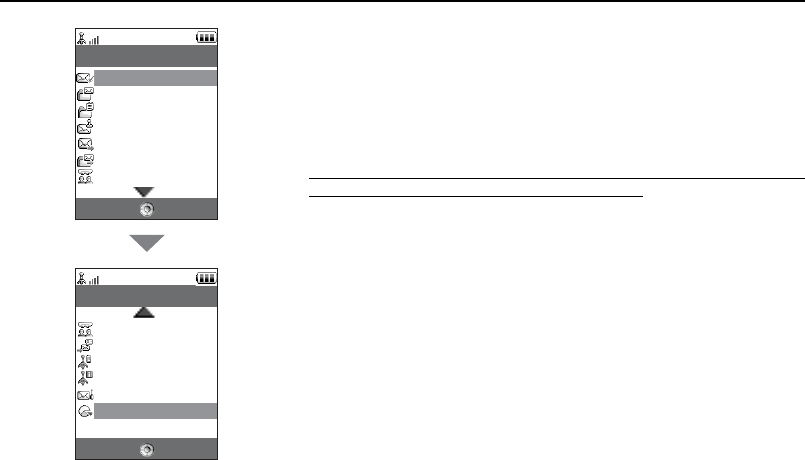
87
Messages (M 4)
Your phone allows you to send and receive text, multimedia and email, and receive WAP
alerts as well.
MMS
MMS allows you to send and receive multimedia messages of up to 300 KB with images,
sound, or video clips attached.
Note
•Some MMS functions may not always be available depending on your network.
Contact your network operator for more information.
•Maximum message size varies depending on the settings by the network operator.
SMS
SMS allows you to send text messages of up to 5 segments (160 characters/segment).
Email
Email allows you to send messages of up to 30 KB, while message size is limited to 300 KB.
Creating a New Message
(For Email)
A
→
“Create Message”
1. Enter the message.
Select Back
Messages
Create New
Inbox
Drafts
Templates
Sent
Outbox
Vodafone Messenger
Select Back
Messages
Vodafone Messenger
Voicemail Menu
Cell Broadcasts
Area Info
Settings
Memory Status

88
Messages
(For MMS/SMS)
A
→
“Create Message”
2. (For Email/MMS)
Press [Options] and select “Insert Item”, if you wish to attach files.
3. Select the desired item. Details are given in the following sections.
“Add Picture”: Attaches picture files.
“Add Sound”: Attaches sound files.
“Add Video”: Attaches video clip files.
“Attach File”: Attaches My Items data.
“Add vCard”: Attaches Contacts List entries.
“Add vCalendar”: Attaches Schedule entries.
4. Press D.
5. Enter or select the email address or phone number from the Contacts List.
To add multiple email addresses or phone numbers (up to 30), press [Options] and
select “Edit Recipient”, then select “Add Contact”.
Enter or select the email address or phone number, or select from the existing Contacts
List.
Up to 20 characters (SMS) or 128 characters (Email/MMS) can be entered for each
email address or phone number.
To change the recipient types, press [Options] and select “Change to TO”, “Change to
CC” or “Change to BCC”.
6. Enter the subject.

89
Messages
7. (For MMS/SMS)
Transportation type (SMS or MMS) is shown in the field of “Message Type”.
Press [Options] and select “Send as”. Select the desired transportation type.
8. Select “Settings” to set the advanced message sending options.
• “Priority” (“High”, “Normal”, “Low”):
Prioritises composed messages.
• “Expiration” (“Never delete”, “30min”, “1h”, “6h”, “1day”, “1week”, “Specific
Time”) (for SMS/MMS/Email):
Sets Expiry Time for a message to be saved in the server.
• “Delayed delivery” (“No Delay”, “30min”, “1h”, “6h”, “1day”, “1week”, “Specific
Time”) (for MMS):
Sets the time the message is delivered after the Send key is pressed.
• “Anonymous delivery” (“Yes”, “No”):
Sends the message anonymously.
• “Delivery Report” (“Yes”, “No”) (for SMS/MMS/Email):
Enables or disables Delivery Report when the message is successfully sent to the
recipient.
• “Read Receipt” (“Yes”, “No”):
Enables or disables Read Report when the recipient is required to inform the sender
that the message has been read.

90
Messages
9. Press .
After the message is sent, the message is moved to the Sent box.
Note
•The current message size displayed while you are creating the message is an
approximation.
•If a message cannot be sent for some reason, the message stays in the Outbox and the
“ ” is displayed during stand-by.
Tip
•To save the message without sending, press [Options] and select “Save Draft” in step 2.
•You can send the following items attached to multimedia messages. Details are given in
the following sections.
•My Items data
•Contacts List entry
•File (Microsoft Excel, Word files, Schedule entry created by Calendar), etc.
•You can use the template option to help you compose messages. For details on using this
option, see “Using Templates” on page 67.
To Attach My Items Data
1. In step 3 in “Creating a New Message” on page 87, select from “Picture”, “Sound”
or “Video”.

91
Messages
2. Select the desired file.
If you wish to take new pictures, record sounds or video clips, select “Take Picture”,
“Record Sound” or “Record Video”.
• (For pictures)
For attached pictures, select the appropriate resize option, as the maximum
message size for sending varies depending on the network operator.
• (For sounds)
For attached sounds, select the appropriate format option, as the maximum
message size for sending varies depending on the network operator.
To Attach Excel or Word Files
1. In step 3 in “Creating a New Message” on page 87, select “Add File”.
2. Select the desired file (“.xls” for Excel files or “.doc” for Word files).
A confirmation message is displayed.
3. Press [Yes].
To Attach a Schedule Entry
1. In step 3 in “Creating a New Message” on page 87, select “vCalendar”.
2. Select the desired day including a schedule entry you wish to add.
3. Select the desired schedule entry.

92
Messages
To Add Information from a Contacts List Entry
1. In step 3 in “Creating a New Message” on page 87, select “Contacts Details”.
2. Select the desired entry.
If you wish to select your own Contacts List entry, select “My Contact Details”.
3. Select the desired field.
The selected information is entered.
To Add a Slide Show
1. In step 2 in “Creating a New Message” on page 87, select “Add Slide”.
If you wish to add more slides, select “Add Slide Before” or “Add Slide After”.
2. Enter the message.
If you wish to set the duration of each slide, select “Slide Duration”, then select the
desired duration.
Tip
•You can create messages up to 300 KB. Each slide can contain one picture and/or one
sound file or video clip.
To Remove or Replace Attachments
1. In step 3 in “Creating a New Message” on page 87, press [Options] and select the
corresponding remove option for each attachment.

93
Messages
Sending a Message in the Drafts Box
A
→
“Drafts”
1. Select the desired tab, SMS/MMS or Email.
2. Press [Options] and select “Edit”.
3. Modify the message, if necessary.
4. Select “Resend”.
5. Press to send.
Reading MMS
Messages you receive are saved in the Inbox.
To View Messages Before Downloading
The MMS indicator ( ) is displayed when you are receiving an incoming message.
A
→
“Inbox”
1. Select the message alert you wish to view.
Tip
•The volume varies depending on the Application Volume settings (p. 145). The sound is
deactivated when “Application Volume” is set to “Silent”.
Storing the Phone Number of a Sender in the Contacts List
A
→
“Inbox”
1. Highlight the message from which you wish to store the phone number or email
address.

94
Messages
2. Press [Options] and select “Save (phone number)”.
The new Contacts List entry screen including the phone number is displayed. For details
on creating a new Contacts List entry, see “Add New Contact” on page 54.
Calling the Phone Number of a Sender Embedded in the Message
A
→
“Inbox”
1. Highlight the message including the phone number you wish to dial.
2. Press [Options] and select “Call (phone number)”.
Downloading a Single MMS
A
→
“Inbox”
1. Highlight the message alert ( ) you wish to download.
2. Press [Options] and select “Download”.
The downloading starts and the indicator becomes .
Tip
•You can press instead of step 2 to start downloading.
•You can download multiple messages at the same time. See the next section.
Downloading Multiple MMS
A
→
“Inbox”
1. Press [Options] and select “Advanced”.
2. Highlight the desired message alert using the “Mark/Unmark” or “Select All” option.
3. Select “Download”.
The selected messages are downloaded at the same time.

95
Messages
Replying to a Message or to All Addresses
A
→
“Inbox”
1. Highlight the message the sender of which you wish to reply to.
2. Press [Options] and select “Reply” or “Reply All”.
3. Enter the message.
4. Press [Send].
5. Press .
Forwarding a Message
A
→
“Inbox”
1. Highlight the message you wish to forward.
2. Press [Options] and select “Forward”.
3. Perform steps 2 to 9 in “Creating a New Message” on page 87.
Remote Forward
You can transfer your email messages saved in the mail server directly to other recipients.
A
→
“Inbox”
1. Highlight the message alert ( ) you wish to transfer.
2. Press [Options] and select “Forward”.
3. Perform steps 2 to 5 in “Creating a New Message” on page 87.

96
Messages
Sorting the Messages in the List
A
→
“Inbox”
1. Press [Options] and select “Advanced”.
2. Select “Sort”.
Locking or Unlocking the Messages
A
→
“Inbox”
1. Highlight the message you wish to lock or unlock.
2. Press [Options] and select “Advanced”.
3. Select “Lock/Unlock”.

97
Messages
Cell Broadcasts
You can receive cell broadcast messages or general messages such as weather forecasts
and traffic reports. This information is broadcast to subscribers in certain network areas.
This function may not be available on all mobile phone networks. Contact your network
operator for more information.
Enabling/Disabling Cell Broadcasts
“Messages”
→
“Cell Broadcasts”
→
“Switch On/Off”
1. Select “On” or “Off”.
Reading Cell Broadcast Messages
“Messages”
→
“Cell Broadcasts”
→
“Read Messages”
1. Select the desired subject.
2. Scroll the screen to read the message.
3. Press [Back].
Setting Languages
You can select your preferred language for the cell broadcast message display.
“Messages”
→
“Cell Broadcasts”
→
“Settings”
→
“Language”
The current language is displayed.
1. Press .
The language list is displayed.
(M 4-9)

98
Messages
2. Select the desired language.
3. Press [Save].
Subscribing to Cell Broadcasts
Select the page of the cell broadcast message that you want.
“Messages”
→
“Cell Broadcasts”
→
“Settings”
→
“Set Info Subjects”
→
[Options]
1. Select “Add/Remove”.
2. Select the desired page.
3. Press [Back].
Tip
•If the desired page is not in the list that appears in step 2, select “Create Subject” in step
1, then enter the subject code to add a page. For details on the subject code, contact your
service provider.

99
Messages
Area Info
The Area Info is the message information that operators send to subscribers in certain
areas.
When you receive Area Info, the message (area code) is displayed during stand-by.
Note
•This function may not be available on all mobile phone networks. Contact your network
operator for more information.
Enabling/Disabling Area Info
“Messages”
→
“Area Info”
1. Select “On” or “Off”.
Note
•If Area Info is set to “On”, the stand-by time will decrease.
(M 4-10)

100
Messages
Setting Up MMS/SMS/Email
General Settings
“Messages”
→
“Settings”
→
“General Settings”
1. Select the item you wish to set up.
• “In-Network” (“Always download”, “Always defer”):
Controls message download timing inside your network area.
“Always download”: Downloads messages immediately from the server.
“Always defer”: Defers message download.
• “Roaming” (“Always download”, “Always defer”):
Controls message download timing when roaming outside of your network.
“Always download”: Downloads messages immediately from the server.
“Always defer”: Defers message download.
• “Delivery Report” (“Always”, “Never”, “Ask first”):
Disables or enables Delivery Report when receiving a message, which applies to the
Delivery Report function, or displays the confirmation message whether or not you
request a delivery report.
• “Anonymous Sender” (“Yes”, “No”):
Accepts or rejects a message from an unknown or empty address name.
• “Auto Delete” (“None”, “Inbox”, “Sent”, “Both”):
Deletes the oldest message automatically, when the Inbox, Sent or both (Inbox and
Sent) is full.
(M 4-11)

101
Messages
• “Message Type” (“SMS”, “MMS”):
Defines the default message type when you select “Create Message”.
• “Signature”:
Opens the screen to enter the signature.
SMS Settings
“Messages”
→
”Settings”
→
“SMS Settings”
1. Select the item you wish to set up.
• “Message center”:
Enter the centre phone number.
If you wish to enter a country code for a message to an international number, press
and hold Q until a + sign is displayed.
• “Expiration”:
This indicates the number of days and hours for which a message you send may
remain undelivered to the message recipient. During this period, the message
service centre will continually try to deliver the message to the recipient.
Select the validity period.
• “Format”:
Select the message format to be used when creating a new message.
•“Reply Path”:
Accepts or rejects the same reply path with the send path when receiving the reply
message for your message.

102
Messages
• “Delivery Report”:
Enables or disables Delivery Report when receiving a message, which applies to the
Delivery Report function.
• “Charset optimization”:
When set “On” (default), double-byte characters such as European characters with
an accent are converted into single-byte characters and sent.
When “Off”, double-byte characters are sent as displayed.
Please note that you may be charged double for double-byte characters sent in an
SMS when Optimisation is set “Off”.
Select “On” or “Off”.
MMS Settings
“Messages”
→
”Settings”
→
“MMS Settings”
1. Select the item you wish to set up.
• “Delivery Report”:
Enables or disables Delivery Report when receiving a message, which applies to the
Delivery Report function.
• “Expiry Time”:
This indicates the number of days and hours for which a message you send may
remain undelivered to the message recipient. During this period, the message
service centre will continually try to deliver the message to the recipient.
Select the validity period.

103
Messages
• “Anonymous Delivery”:
Sends the message anonymously.
• “Read Receipt”:
Notifies you when your message was read by the message recipient.
• “Slide Duration”:
Sets the duration of the slide.
Email Settings
“Messages”
→
”Settings”
→
“Email Settings”
1. Select the item you wish to set up.
• “Polling Interval”:
Sets the polling interval.
• “Max Message Size”:
Defines the maximum size of messages that are downloaded.

104
Vodafone live! (M 2)
Your phone is already configured to access Vodafone live! and the mobile internet*.
Vodafone live! is a new mobile internet portal which is your gateway to a new world of
information, games, music and services.
Because your phone uses GPRS, it has a system that is much faster than previous ways of
getting mobile information. Also, the connection is ‘always on’ which means there is no
need to wait for dialling up. You only have to pay for the data you send or receive, not how
long you’re connected.
* If you have problems getting connected, please phone Vodafone Customer Support.
Your phone contains a WAP browser used for surfing on the Mobile Internet, where you can
get a lot of useful information. Normally, pages are designed for a mobile phone.
Your phone is already setup to Vodafone site for WAP/MMS Settings.
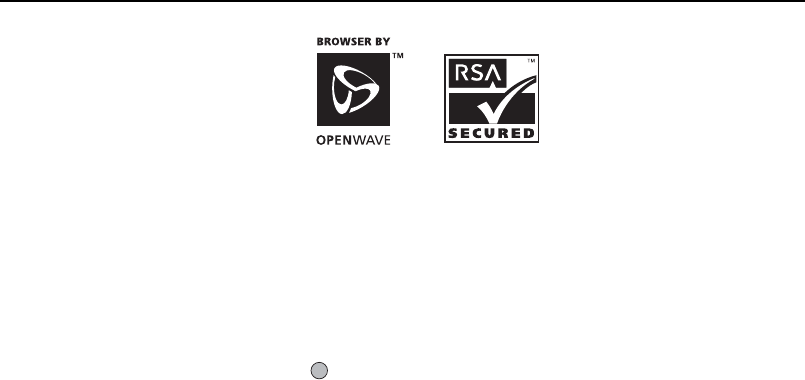
105
Vodafone live!
Starting the WAP Browser
1. Press C during stand-by.
To Exit the WAP Browser
1. Press F to exit the browser.
Navigating a WAP Page
•a b c d:
Move the highlights around in the screen.
• : Executes the option displayed in the lower centre of the screen.
•A: Launches the browser option menu.
•C: Selects an action displayed in the lower right of the screen.
Used to access “Vodafone live!” by opening the browser.

106
Vodafone live!
•F(short press):
Exits the browser.
(press and hold):
Turns off the phone.
Browser Menu
To Edit Favourites
“Vodafone Live!”
→
[Options]
→
“Favourites”
1. Select the desired URL, and press [Options].
You can edit the list of Favourites by the following options:
“Details”: Displays detailed information of the WAP page.
“Send”: Sends the URL address to recipients.
“New”: Creates new folders or favourites.
“Move”: Moves Favourites to another location.
“Rename”: Renames favourites.
“Edit URL”: Edits URL address of the favourite.
“Delete”: Deletes favourites.
“Delete All”: Deletes all favourites.

107
Vodafone live!
The Browser Options
You can use various options of the WAP browser.
“Vodafone Live!”
→
[Options]
“Home”: Goes to the homepage.
“Mark Page”: Marks the selected WAP page.
“Save Items”: Saves items from WAP pages.
“Go to URL”: Goes to the WAP page that you enter the URL address.
“Access History”: Shows the history where you have browsed.
“Reload Page”: Reloads the WAP page again to get new information.
“Advanced”: Displays the advanced menus.
“Exit”: Exits the browser.
The Advanced Options
“Vodafone Live!”
→
[Options]
→
“Advanced”
“Snapshots”: Displays snapshots of the WAP page.
“Save this Page”: Saves the WAP page as the local file.
“Send Page”: Sends the WAP page data.
“Details”: Shows detailed information of the WAP page.
“Browser Data”: Edits the browser data. You can clear the cache/cookies/
history.
“Search in Page”: Searches specific words in the WAP page.
“Alert inbox”: Displays WAP Push alerts.
“Copy Text”: Copies the text on the web page.
“Settings”: Displays the Settings menus.
“Restart Browser”: Restarts the browser.
“About”: Displays the browser information.

108
Vodafone live!
Browser Settings
“Vodafone Live!”
→
[Options]
→
“Advanced”
→
“Settings”
“Sender Referrer”: Enables or disables the notification of the referrer.
“Cookies”: Adjusts the setting of cookies.
“Downloads”: Categorises downloading data from the images/sounds/
objects.
“Security”: Adjusts the security prompt level.
“Mobile identification”: Enables or disables the notification of mobile phone
identification.
“Scroll Step”: Sets the speed of scrolling.
“Font Size”: Sets the size of the browsing font.
“Location prompt”: Adjusts the location prompt level.
To Restart the Browser
“Vodafone Live!”
→
[Options]
→
“Restart Browser”

109
Media Player (M 3)
Media Player can play sound files and video clip files by switching between two applications:
Music Player and Video Player. These applications can handle files in MP4 and 3gp (video
clip, sound) format. While playing back files in the background, you can use other menus.
Switching between Music Player and Video Player
When you start the Media Player for the first time, the Music Player is started.
“Media Player”
The All List of the last-launched player is displayed.
1. When the desired playlist is not displayed, press [Options] and select “Open Video”
or “Open Music”.
2. Select from “Handset Memory”, “Memory Card” (or “SD VIDEO” or “SD AUDIO”).
Music Player
Playing Back Sound Files
“Media Player”
1. Select the desired file.
To pause playback, press .
Note
•When you press the Multimedia key, you are asked whether or not to play sounds.

110
Media Player
Tip
•You can return to the Main menu screen while playing back the file in the background.
•You can create your playlist listing only the desired files (p. 112).
•You can make tone adjustment in step 1. Press [Options] and select “Tone Control”.
Select from “Normal”, “Bass”, “Surround” or “Surround Bass”.
•You can select the playback pattern in step 1. Press [Options] and select “Playback
Pattern”.
“Normal”: Plays back all files in the selected folder once and stops playback.
“Repeat”: Continues to play back the selected file.
“Repeat All”: Plays back all files in the selected folder.
“Random”: Plays back files in the selected folder at random.
Searching a File to Be Played Back
“Media Player”
1. Press [Options] and select “Search”.
2. Enter the first few letters of the title.
Search results are displayed in alphabetical order and the matching file is highlighted.
Adding a File to the Playlist
You can create a playlist registering desired files.
“Media Player”
1. Highlight the file you wish to add to the playlist.

111
Media Player
2. Press [Options] and select “Add to Playlist”.
The playlists are displayed. For details on creating a playlist, see “Creating a New
Playlist” on page 112.
3. Select the desired folder.
4. Press .
The file highlighted in step 1 is saved.
To delete the playlist, highlight the playlist and press [Options]. Then select “Delete
Playlist”.
Streaming
You can play back sound files while downloading them from the mobile network.
You can also register the address of the Web site as a bookmark.
“Media Player”
1. Press [Options] and select “Streaming”.
2. Select from “Enter URI”, “Favourites” or “Access Log”.
“Enter URI”: Enter the desired address of the Web site. The browser opens, starts
downloading and plays back.
“Favourites”: The address of the Web site is registered.
“Access Log”: Shows the logs of the Web site you accessed. From the log you can
start streaming.

112
Media Player
Creating a New Playlist
“Media Player”
1. Press [Options] and select “Open Music”.
2. Select “Handset Memory” or “Memory Card”.
3. Press [Options] and select “Add New Playlist”.
4. Enter the desired playlist name.
5. Press .
Video Player
Playing Back Video Clip Files
“Media Player”
1. Select the desired file.
To pause playback, press .
To stop playback, press C.
Tip
•You can create your playlist listing only the desired files (p. 114).

113
Media Player
Searching a File to Be Played Back
“Media Player”
1. Press [Options] and select “Search”.
2. Enter the first few letters of the title.
Search results are displayed in alphabetical order and the matching file is highlighted.
Adding a File to the Playlist
You can create a playlist registering desired files.
“Media Player”
1. Highlight the file you wish to add to the playlist.
2. Press [Options] and select “Add to Playlist”.
The playlists are displayed. For details on creating a playlist, see “Creating a New
Playlist” on page 114.
3. Select the desired folder.
4. Press .
The file highlighted in step 1 is saved.
To delete files from the playlist, highlight the playlist and press [Options]. Then select
“Delete from Playlist”.

114
Media Player
Streaming
You can play back video clip files while downloading them from the mobile network.
You can also register the address of the Web site as a bookmark.
“Media Player”
1. Press [Options] and select “Streaming”.
2. Select from “Enter URI”, “Favourites” or “Access Log”.
“Enter URI”: Enter the desired address of the Web site. The browser opens, starts
downloading and plays back.
“Favourites”: The address of the Web site is registered.
“Access Log”: Shows the logs of the Web site you accessed. From the log you can
start streaming.
Creating a New Playlist
“Media Player”
1. Press [Options] and select “Open Video”.
2. Select “Handset Memory”, “Memory Card” or “SD VIDEO”.
3. Press [Options] and select “Add New Playlist”.
4. Enter the desired playlist name.
5. Press .

115
Media Player
Editing the Video Clip File
“Media Player”
1. Select the file you wish to edit.
2. Press [Options] and select “Edit”.
3. Select the desired option.
“Crop”: Select the desired area to be cropped.
“Subtitle”: Create a subtitle to add to the file.
Backlight
“Media Player”
1. Select the file the backlight of which you wish to adjust.
2. Press [Options] and select “Settings”.
3. Select “Backlight:”.
4. Select from “Always On”, “Always Off” or “Normal Settings”.
“Always On”: Lit while the file is played back.
“Always Off”: Unlit while the file is played back even if a key is pressed.
“Normal Settings”: Works with the main backlight setting (p. 181).
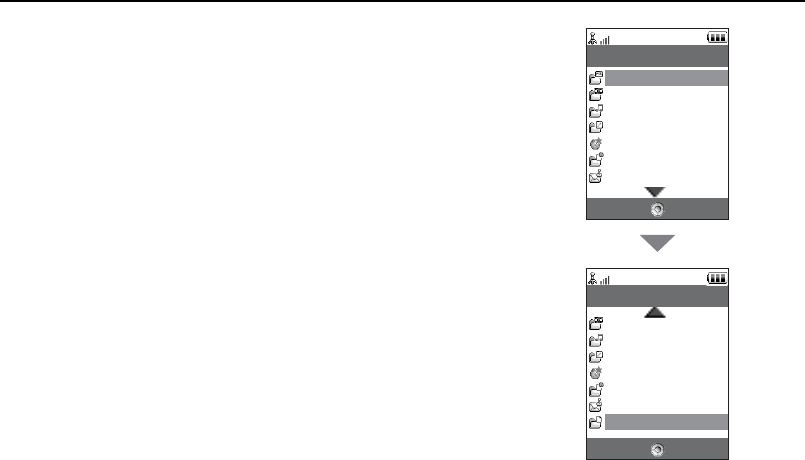
116
My Items (M 6)
My Items contains several types of picture, sound and video clip data. Also included in My
Items are frequently used text message phrases and accessed WAP pages (addresses)
which you can use. You can also transmit picture, sound and video clip data via infrared or
Bluetooth
wireless technology to OBEX-enabled phones.
Note
•The phone can store approximately 7.5 MB of data across Pictures, Games & More,
Sounds, Videos and Other Documents.
Select Back
My Items
Pictures
Videos
Sounds & Ringtones
Games & More
Bookmarks
My Saved Page
Text Templates
Select Back
My Items
Other Documents
Videos
Sounds & Ringtones
Games & More
Bookmarks
My Saved Page
Text Templates

117
My Items
Pictures
Pictures that are taken by a digital camera or images that are downloaded from mobile
Internet sites can be managed. You can register pictures in the following formats: JPEG,
PNG, WBMP and GIF.
Viewing Pictures
“My Items”
→
“Pictures”
1. Select the file you wish to view.
The selected picture is displayed.
Switching the Memory Source
“My Items”
→
“Pictures”
1. Press d.
The tab switches and the list is displayed from the memory card. To go back to the
handset memory, press c.
2. Select the picture file you wish to view.
Using Images as Wallpaper
“My Items”
→
“Pictures”
1. Highlight the file you wish to use as wallpaper.
2. Press [Options] and select “Set as Wallpaper”.
(M 6-1)
Options Back
Pictures
Picture002
01-15-05
More Contents
20KB
20KB
Picture001

118
My Items
Saving an Image to Contacts List Entries
You can use this option only for pictures saved in the handset memory.
“My Items”
→
“Pictures”
1. Highlight the file you wish to add to Contacts List.
2. Press [Options] and select “Add to Contact”.
To overwrite, select the data you wish to save.
To save as a new entry, select “As New Contact”.
For details on entering a name, see “Add New Contact” on page 54.
Editing Pictures
“My Items”
→
“Pictures”
1. Highlight the file you wish to edit.
2. Press [Options] and select “Picture Editor”.
3. Select the desired option.
Note
•The size of pictures that you can retouch is 52 dots [W]
×
52 dots [H] minimum.

119
My Items
Adjusting the Size
You can adjust the picture to an appropriate size depending on the scene.
“My Items”
→
“Pictures”
1. Highlight the file you wish to adjust the size of.
2. Press [Options] and select “Resize”.
3. Select the desired option.
Each option resizes the picture for each use.
“To Wallpaper”
“Power On/Off”
“For Incoming Call”
“Alarm”
“Cut”
Note
•“Resize” may not be available depending on the original picture and copyright issued.

120
My Items
Sending a Picture File
“My Items”
→
“Pictures”
1. Highlight the file you wish to send.
2. Press [Options] and select “Send”.
3. Select the desired option.
For details on creating a message, see “Creating a New Message” on page 87.
Note
•Some pictures protected with a copyright may not be sent attached to a message.
Operating the Files
You can copy, move, sort, rename, and delete the saved pictures.
“My Items”
→
“Pictures”
1. Highlight the desired file.
2. Press [Options] and select “Advanced”.
Select the desired option according to your purpose.
“Move”: Moves the files to another folder. Select the desired folder to
move.
“Copy”: Copies the file. Select the desired folder to copy.
“Create Folder”: Creates a new folder.

121
My Items
Using Multiple Select
You can select more than one file for moving, copying and deleting.
“My Items”
→
“Pictures”
→
[Options]
→
“Advanced”
→
“Multiple Select”
1. Select the desired file names.
2. Press [Options] and select the desired menu.
If you select “Delete”, a confirmation message is displayed.
Tip
•To remove the check, select the file again or select “Unselect” in step 2.
•If you wish to select all files, select “Select All” in step 2. To unselect all, select “Unselect
All”. Then press [Options] to select the desired menu.
To Sort the Files
“My Items”
→
“Pictures”
→
[Options]
→
“Advanced”
→
“Sort List”
1. Select the desired order.
To Rename the File
“My Items”
→
“Pictures”
1. Highlight the desired file.
2. Press [Options] and select “Rename”.
Options Back
Pictures
Picture003
01-15-05
20KB
20KB
Picture001
01-15-05 20KB
Picture002
01-15-05

122
My Items
To Delete the File
“My Items”
→
“Pictures”
1. Highlight the desired file.
2. Press [Options] and select “Delete”.
To See the Picture Details
“My Items”
→
“Pictures”
1. Highlight the file of which you wish to view the detail information.
2. Press [Options] and select “Details”.
Downloading Picture Files
“My Items”
→
“Pictures”
→
“Get new”
The picture file download site is displayed.
Tip
•For details on transmitting My Items data, see “Sending My Items Data” on page 136.

123
My Items
Videos
Video clips that are recorded by a video camera or video clips that are downloaded from
mobile Internet sites can be managed.
Playing Back Video Clip Files
“My Items”
→
“Videos”
1. Select the file you wish to play back.
2. Press .
To resume, press again.
To stop playback, press [Back].
Switching the Memory Source
“My Items”
→
“Videos”
1. Press d.
The tab switches and the list is displayed from the memory card. To go back to the
handset memory, press c.
2. Select the video clip you wish to view.
(M 6-2)

124
My Items
Sending a Video Clip File
“My Items”
→
“Videos”
1. Highlight the file you wish to send.
2. Press [Options] and select “Send”.
3. Select the desired option.
For details on creating a message, see “Creating a New Message” on page 87.
Note
•Video clips protected with a copyright cannot be sent attached to a message, with the
exception of Separate Delivery files.
To Record a Video
You can record a video also from My Items.
“My Items”
→
“Videos”
→
[Options]
→
“Record Video”
The video camera application launches. To record a video, see “Recording Video Clips” on
page 79.
Operating the Files
You can copy, move, sort, rename, and delete the saved video clips.
“My Items”
→
“Videos”
1. Highlight the desired file.

125
My Items
2. Press [Options] and select “Advanced”.
Select the desired option according to your purpose.
“Move”: Moves the files to another folder. Select the desired folder to
move.
“Copy”: Copies the file. Select the desired folder to copy.
“Create Folder”: Creates a new folder.
Using Multiple Select
You can select more than one file for moving, copying and deleting.
“My Items”
→
“Videos”
→
[Options]
→
“Advanced”
→
“Multiple Select”
1. Select the desired file names.
2. Press [Options] and select the desired menu.
If you select “Delete”, a confirmation message is displayed.
Tip
•To remove the check, select the file again or select “Unselect” in step 2.
•If you wish to select all files, select “Select All” in step 2. To unselect all, select “Unselect
All”. Then press [Options] to select the desired menu.
To Sort the Files
“My Items”
→
“Videos”
→
[Options]
→
“Advanced”
→
“Sort List”
Select the desired order.

126
My Items
To Rename the File
“My Items”
→
“Videos”
1. Highlight the desired file.
2. Press [Options] and select “Rename”.
To Delete the File
“My Items”
→
“Videos”
1. Highlight the desired file.
2. Press [Options] and select “Delete”.
To See the Video Clip Details
“My Items”
→
“Videos”
1. Highlight the file of which you wish to view the detail information.
2. Press [Options] and select “Details”.

127
My Items
Downloading Video Clip Files
“My Items”
→
“Videos”
→
“Get new”
The video clip file download site is displayed.
Setting a Ring Video
You can set your video clip to play back when the phone rings.
“My Items”
→
“Videos”
1. Highlight the desired video clip.
2. Press [Options] and select “Set as Ring Video”.

128
My Items
Sounds & Ringtones
The downloaded sound files and the AMR data recorded by Voice Recorder are managed in
Sounds & Ringtones. The default ringtones are not contained within Sounds & Ringtones.
Only the sound files you can play back with the phone are stored in Sounds & Ringtones.
Playing Back Sound Files
“My Items”
→
“Sounds & Ringtones”
1. Select the file you wish to play back.
To stop playback, press .
Note
•This option may not be available in all regions.
Switching the Memory Source
“My Items”
→
“Sounds & Ringtones”
1. Press d.
The tab switches and the list is displayed from the memory card. To go back to the
handset memory, press c.
2. Select the desired sound file.
(M 6-3)

129
My Items
Using the Sound Files as a Ringtone
“My Items”
→
“Sounds & Ringtones”
1. Highlight the file you wish to use as a ringtone.
2. Press [Options] and select “Set as Ringtone”.
Note
•The formats that can be used for ringtones are SMAF, MIDI (SMF, SP-MIDI), MP3, MP4
and XMF. Other formats cannot be used.
Sending a Sound File
“My Items”
→
“Sounds & Ringtones”
1. Highlight the file you wish to send.
2. Press [Options] and select “Send”.
3. Select the desired option.
For details on creating a message, see “Creating a New Message” on page 87.
Note
•Sounds protected with a copyright cannot be sent attached to a message, with the
exception of Separate Delivery files.

130
My Items
Operating the Files
You can copy, move, sort, rename, and delete the saved sound files.
“My Items”
→
“Sounds & Ringtones”
1. Highlight the desired file.
2. Press [Options] and select “Advanced”.
Select the desired option according to your purpose.
“Move”: Moves the files to another folder. Select the desired folder to
move.
“Copy”: Copies the file. Select the desired folder to copy.
“Create Folder”: Creates a new folder.
Using Multiple Select
You can select more than one file for moving, copying and deleting.
“My Items”
→
“Sounds & Ringtones”
→
[Options]
→
“Advanced”
→
“Multiple
Select”
1. Select the desired file names.
2. Press [Options] and select the desired menu.
If you select “Delete”, a confirmation message is displayed.
Tip
•To remove the check, select the file again or select “Unselect” in step 2.
•If you wish to select all files, select “Select All” in step 2. To unselect all, select “Unselect
All”. Then press [Options] to select the desired menu.

131
My Items
To Sort the Files
“My Items”
→
“Sounds & Ringtones”
→
[Options]
→
“Advanced”
→
“Sort List”
Select the desired order.
To Rename the File
“My Items”
→
“Sounds & Ringtones”
1. Highlight the desired file.
2. Press [Options] and select “Rename”.
To Delete the File
“My Items”
→
“Sounds & Ringtones”
1. Highlight the desired file.
2. Press [Options] and select “Delete”.
To See the Sound Details
“My Items”
→
“Sounds & Ringtones”
1. Highlight the file of which you wish to view the detail information.
2. Press [Options] and select “Details”.

132
My Items
Downloading Sound Files
“My Items”
→
“Sounds & Ringtones”
→
“Get new”
The sound file download site is displayed.
Games & More
Along with the preloaded application, downloaded applications are saved in Applications.
Using Applications
Various kinds of Vodafone specific applications can be used on this phone.
To use applications, download the applications via the mobile Internet.
Some applications offer the ability to connect to a network either within a game or a network
based application.
Note
•Applications may be both localised (no connectivity) and network based (using the mobile
Internet to update information/play games). The network may charge you more for using
network-based applications. Please contact your service provider for more information.
(M 6-4)

133
My Items
Downloading Applications
Confirmation Screen
Before downloading the application you are asked to confirm what you are about to receive.
After checking the information on the confirmation screen, the application can be
downloaded.
Note
•User authentication may be required before downloading the application on some
information screens.
Executing Applications
“My Items”
→
“Games & More”
Downloaded applications are sequentially displayed from the latest one.
1. Select the title of the application you wish to execute.
The selected application is executed. When using network connection type applications,
connection to the network can be selected.
2. To end the application, press A and select “End”.

134
My Items
To Set a Screensaver Application
“My Items”
→
“Games & More”
1. Highlight the desired screensaver application.
2. Press .
The confirmation screen to set a screensaver is displayed.
3. Select [Yes].
Switching the Memory Source
“My Items”
→
“Games & More”
1. Press d.
The tab switches and the list is displayed from the memory card. To go back to the
handset memory, press c.
2. Select the desired application.
Moving Files to the Memory Card
“My Items”
→
“Games & More”
1. Highlight the application you wish to move.
2. Press [Options] and select “Move to Card”.
3. Select [OK] or .

135
My Items
More Games
“My Items”
→
“Games & More”
→
“More Games”
1. Select the application you wish to download.
The confirmation screen is displayed after various WAP browser screens.
2. Press to start downloading.
3. Press when finished.
Activating Files with Copyright Protection (DRM)
Some pictures, sound files, and video clips have a digital copy protection program, which is
called DRM (Digital Rights Management). You need to activate the digital licence permission
to open the files. Files protected with DRM are displayed with .
“My Items”
1. Select the desired menu from “Pictures”, “Sounds & Ringtones” or “Videos”.
2. Highlight the file you wish to activate.
3. Press [Options] and select “Activate”.
Note
•Some pictures with DRM may not open even when an attempt is made to activate it.
•Pictures with DRM cannot be sent attached to a message, with the exception of Separate
Delivery files.

136
My Items
Sending My Items Data
Choose the appropriate menu.
“My Items”
→
“Pictures”
“My Items”
→
“Sounds & Ringtones”
“My Items”
→
“Videos”
“My Items”
→
“Other Documents”
1. Highlight the desired file.
2. Press [Options] and select “Send”.
3. Select “Via Bluetooth” or “Via Infrared”.
For “Via Bluetooth”
For details, see “Bluetooth” on page 205.
For “Via Infrared”
For details, see “Infrared” on page 211.
Note
•Pictures/Sounds/Video clips protected with a copyright cannot be sent, with the exception
of Separate Delivery files.
•When pairing, you need to enter your passcode when establishing contact with a
Bluetooth wireless technology enabled device for the first time.

137
My Items
Receiving the My Items Data
When the phone receives the My Items data, a confirmation message is displayed during
stand-by.
1. Press [Yes].
The received data is saved in the corresponding My Items folder.
Tip
•For details on Infrared or Bluetooth wireless settings, see “Connectivity” on page 205.
Bookmarks
You can store desired (or frequently used) pages (addresses) in Bookmarks. It can save you
time in accessing WAP pages. For details, see “Vodafone live!” on page 104.
“My Items”
→
“Bookmarks”
1. Select the page you wish to browse.
My Saved Page
You can save the WAP page as a screenshot.
“My Items”
→
“My Saved Page”
1. Select the desired file to view.
(M 6-5)
(M 6-6)

138
My Items
Text Templates
You can register up to 50 text templates for use in text messages and multimedia
messages. The maximum capacity of the text templates is 100 KB.
Adding Phrases to Text Templates
“My Items”
→
“Text Templates”
→
“Add New Templates”
1. Select the number you wish to register.
2. Enter the text and press .
Editing Text Templates
“My Items”
→
“Text Templates”
1. Highlight the text template you wish to edit.
2. Press [Options] and select “Edit”.
3. Modify the text and press .
Viewing Text Templates
“My Items”
→
“Text Templates”
The list of Text Templates is displayed.
1. Highlight the text template you wish to view.
2. Press [Options] and select “View”.
Deleting Text Templates
“My Items”
→
“Text Templates”
1. Highlight the text template you wish to delete.
2. Press [Options] and select “Delete”.
(M 6-7)

139
My Items
Sending Text Templates
“My Items”
→
“Text Templates”
1. Highlight the text template you wish to send.
2. Press [Options] and select “Send Template”.
3. Select the desired option to send.
Other Documents
Some types of files excluding picture files are stored in the Other Documents folder of the
phone. You can edit and use these files as My Items data.
Opening the Document File
“My Items”
→
“Other Documents”
1. Select the desired file.
Sending the Document File
“My Items”
→
“Other Documents”
1. Highlight the file you wish to send.
2. Press [Options] and select “Send”.
3. Select the desired option.
(M 6-8)

140
My Items
Operating the Files
You can copy, move, sort, rename, and delete the saved documents.
“My Items”
→
“Other Documents”
1. Highlight the desired file.
2. Press [Options] and select “Advanced”.
Select the desired option according to your purpose.
“Move”: Moves the files to another folder. Select the desired folder to
move.
“Copy”: Copies the file. Select the desired folder to copy.
“Create Folder”: Creates a new folder.
Using Multiple Select
You can select more than one file for moving, copying and deleting.
“My Items”
→
“Other Documents”
→
[Options]
→
“Advanced”
→
“Multiple
Select”
1. Select the desired file names.
2. Press [Options] and select the desired menu.
If you select “Delete”, a confirmation message is displayed.
Tip
•To remove the check, select the file again or select “Unselect” in step 2.
•If you wish to select all files, select “Select All” in step 2. To unselect all, select “Unselect
All”. Then press [Options] to select the desired menu.

141
My Items
To Sort the Files
“My Items”
→
“Other Documents”
→
[Options]
→
“Advanced”
→
“Sort List”
1. Select the desired order.
To Rename the File
“My Items”
→
“Other Documents”
1. Highlight the desired file.
2. Press [Options] and select “Rename”.
To Delete the File
“My Items”
→
“Other Documents”
1. Highlight the desired file.
2. Press [Options] and select “Delete”.
To See the Document Details
“My Items”
→
“Other Documents”
1. Highlight the file of which you wish to view the detail information.
2. Press [Options] and select “Details”.

142
Games & More (M 1)
Games
The list of Java™ applications is displayed.
Downloaded applications are displayed in order starting from the latest one.
Executing Applications
For details on executing applications, see “Executing Applications” on page 133.
Setting Security Level
You can set the security level for selected Java™ applications.
“Games & More”
→
“Games”
1. Highlight the desired Java™ application.
2. Press [Options] and select “Security Level”.
3. Select one of the following options:
“Network Access”: Sets security to access the network.
“Messaging”: Sets security to perform MMS and SMS messaging.
“Auto Run”: Sets security to perform the Auto Run function.
“Local Connection”: Sets security to access local contents.
“Read User Data”: Sets security to read user data, such as Contacts List entries,
mailbox (Inbox) and My Items data.
(M 1-1)
Select Back
Games & More
Games
Screensavers
Settings
Java™ Information

143
Games & More
“Write User Data”: Sets security to write entries in your phone, such as Contacts List
entries, mailbox (Inbox) and My Items data.
“Use Multimedia”: Sets security to use the barcode scanning function.
“Location Access”: Sets security to update the positioning function.
“Reset”:
4. Select one of the following options:
“Session”: The confirmation message is not displayed until you exit the
application, while execution of the API of the specified function
group is authorised.
“Oneshot”: The confirmation message is displayed every time the API of the
specified function group is executed.
“Blanket”: The confirmation message is not displayed until the application is
deleted or you change the settings, while execution of the API of
the specified function group is authorised.
“No”: Execution of the API of the specified function group is not
authorised.
Setting Network Access
In order to download Java™ applications, you need to set the network access.
“Games & More”
→
“Games”
→
[Options]
→
“Security Level”
→
“Network
Access”
1. Select “Session”, “Oneshot”, “Blanket” or “No”.

144
Games & More
Viewing Application Information
You can check the information of Java™ applications.
“Games & More”
→
“Games”
1. Highlight the desired Java™ application.
2. Press [Options] and select “Information”.
Deleting an Application
You can delete an application from the handset memory.
“Games & More”
→
“Games”
1. Highlight the desired Java™ application.
2. Press [Options] and select “Delete”.
Screensavers
You can download screensaver applications for the stand-by screen.
Switching the Screensaver On or Off
“Games & More”
→
“Screensavers”
→
“Switch On/Off”
1. Select “On” or “Off”.
Note
•If you select “On” and a screensaver application is not set, a list displaying available
screensavers is displayed, asking you to make a selection.
(M 1-2)

145
Games & More
Set Applications
“Games & More”
→
“Screensavers”
→
“Set Applications”
The downloaded applications are displayed.
1. Select the desired screensaver application.
Settings
Application Volume
You can set the volume of the application such as the sound effect to one of the five levels
or silent. When “Application Volume” is set to “Silent”, this setup has priority.
“Games & More”
→
“Settings”
→
“Application Volume”
The current volume level is displayed.
1. Press a (or d) to increase the volume or press b (or c) to decrease the volume
and then press .
Backlight
“Games & More”
→
“Settings”
→
“Backlight”
→
“Switch On/Off”
1. Select from “Always On”, “Always Off” or “Normal Settings”.
“Always On”: Lit while the application is operated. Blinks when the blink setting
is on.
“Always Off”: Unlit while the application is operated even if a key is pressed.
“Normal Settings”: Works with the main backlight setting (p. 181). Blinks when the
blink setting is on.
(M 1-3)

146
Games & More
To Set the Blinking Operation
This setting enables the backlight to be controlled by the application. If set to “Off”, the
backlight cannot be turned on from the application.
“Games & More”
→
“Settings”
→
“Backlight”
→
“Blink”
1. Select “On” or “Off”.
Vibration
When the vibrator is set in the application, you can choose whether the operation is enabled
or disabled.
When a SMAF file is specified in the application, you can operate the vibrator set in the
SMAF file.
Note
•SMAF (Synthetic music Mobile Application Format) is a music data format for mobile
phones.
“Games & More”
→
“Settings”
→
“Vibration”
1. Select from “On”, “Link to Sound” or “Off”.
When you set “Link to Sound”, the vibration is synchronised with the sound of SMAF file
in the application.

147
Games & More
Calls & Alarms
You can set the priority of incoming calls and alarms while an application is operating.
“Games & More”
→
“Settings”
→
“Calls & Alarms”
1. Select “Incoming Call”, “Video Call”, “Incoming Message” or “Alarm”.
2. Select the desired method.
• “Call Priority”, “Message Priority” or “Alarm Priority”:
The application is suspended automatically, and you can receive a call or a message, or
the alarm will sound. After finishing the call or the message, or the alarm ends, the
suspend indicator ( ) is displayed letting you know there is a suspended application.
• “Call Notice”, “Message Notice” or “Alarm Notice”:
The marquee (character scrolls) is displayed on the first line of the screen while the
application continues. If you press D, the application is suspended, and you can receive
a call or a message. After finishing the call or the message, the suspend indicator ( )
is displayed letting you know there is a suspended application.
Java™ Information
The information about the licences belonging to Java™ is displayed.
(M 1-4)

148
Organiser (M 7)
Calendar
Calendar allows you to easily schedule appointments or events, which are associated with
the date and time.
These entries can also be sent via infrared or
Bluetooth
wireless technology to a PC to share
the same schedules. When you exchange entries with other devices, the date and time
displayed may be different to that of the original data depending on the data format of the
receiving device.
Creating a New Entry
“Organiser”
→
“Calendar”
1. Select the desired day to which you want to add an event.
2. Select “Add New Entry”.
3. Enter the subject.
4. Enter the location.
5. Select the desired category.
6. Enter the start date and then enter the start time.
7. Select the duration.
8. Select the reminder time or date.
(M 7-1)

149
Organiser
9. Select “Repeat” and select the desired option.
10. Select “Description” and enter a memo for the schedule entry.
11. Select “Secret” and select “On” or “Off” to make it secret data.
12. Press [Save].
Note
•If the date and time settings have not been made, the date and time entry screen is
displayed (p. 185).
•The reminder functions even if the phone is switched off.
•The reminder will not sound when “Ringer Volume” (p. 171) is set to “Silent”.
Sending a Schedule Entry
“Organiser”
→
“Calendar”
1. Select the day including schedule entries you wish to send.
2. Press [Options] and select “Send”.
3. Select “As Message”, “Via Bluetooth” or “Via Infrared”.
For “Via Bluetooth”
For details, see “Bluetooth” on page 205.
For “Via Infrared”
For details, see “Infrared” on page 211.
Note
•When pairing, you need to enter your passcode when establishing contact with a
Bluetooth wireless technology enabled device for the first time.

150
Organiser
Receiving a Schedule Entry
When the phone receives a schedule entry, a confirmation message is displayed during
stand-by.
1. Press [Yes].
The received entry is saved in the Calendar.
Press [No] to reject.
Tip
•For details on making Infrared or Bluetooth wireless settings, see “Connectivity” on
page 205.
Viewing a Schedule Entry
“Organiser”
→
“Calendar”
1. Select the day you wish to view.
The daily view is displayed.
To Search By Date
1. In the monthly or weekly view, press [Options] and select “Go to”.
2. Select “Today” to display today or “Enter Date” to enter the desired date.
Editing a Schedule Entry
“Organiser”
→
“Calendar”
1. Select the day you wish to edit.
The daily view is diplayed.
Select Back
20.02.2005
Options
Select
Edit
Add New Entry
Send
Go to

151
Organiser
2. Press [Options] and select “Edit”.
3. Select the desired item and modify the entry.
4. Press [Save].
Deleting Schedule Entries
1. In the monthly or daily view, press [Options] and select “Delete”.
2. Select the desired option.
“This Appointment” (daily view only):
Deletes the selected appointment.
“All this Day” (daily view only):
Deletes all entries for the selected day.
“All this Month”: Deletes all entries for the selected month.
“Up to Last Month”:
Deletes all entries before this month.
“All Appointments”:
Deletes all entries in this application.
Viewing the Memory Status
1. In the monthly or daily view, press [Options] and select “Memory Status”.
The current memory status is displayed.

152
Organiser
Alarms
Setting the Alarms
The alarm function allows you to be alerted at a specified time.
Note that you need to set the current date and time before setting the alarm function if it
has not been done already.
Note
•The alarm functions even if the phone is switched off.
•The alarm will not ring when “Ringer Volume” (p. 171) is set to “Silent”.
“Organiser”
→
“Alarms”
1. Select the blank setting.
2. Enter the desired time.
3. Select the repeat option.
To Change the Type of Alarm Tone
1. On the Set Alarm screen, select “Assign Tone/Video”.
2. Select “Assign Alarm Tone”.
3. Select “Preset Sounds” or “My Sounds”.
4. Select the desired tone.
For details on selecting a tone, see “Assigning a Ringtone” on page 172.
(M 7-2)

153
Organiser
To Change the Type of Video
1. On the Set Alarm screen, select “Assign Tone/Video”.
2. Select “Assign Alarm Video”.
3. Select the desired video.
To Change the Snooze of the Alarm Tone
1. On the Set Alarm screen, select “Snooze”.
2. Select the desired snooze option.
To Change the Alarm Volume
1. On the Set Alarm screen, select “Alarm Volume”.
2. Press a (or c) to increase the volume or press b (or d) to decrease the volume.
To Change the Vibration of Alarm Tone
1. On the Set Alarm screen, select “Vibration”.
2. Select “On”, “Link to Sound” or “Off”.
For details on selecting a vibration, see “Vibration” on page 175.
To Change the Duration of the Alarm Tone
1. On the Set Alarm screen, select “Duration”.
2. Select the desired duration.
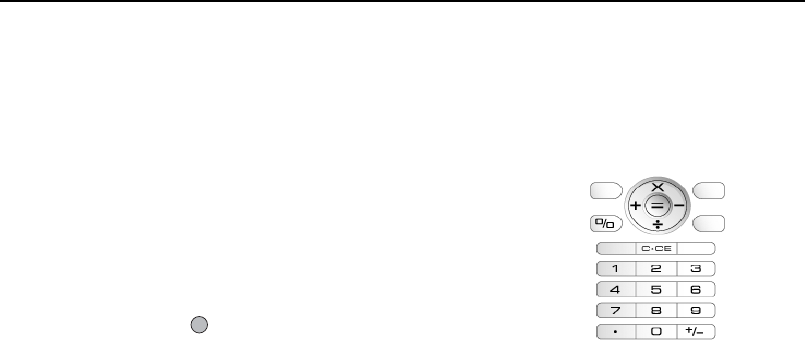
154
Organiser
Resetting an Alarm Setting
“Organiser”
→
“Alarms”
1. Highlight the alarm you wish to reset.
2. Press [Options] and select “Reset Alarm”.
Resetting All Alarm Settings
“Organiser”
→
“Alarms”
→
“Clear All”
Calculator
The calculator function performs the 4 arithmetic calculations using up to 12 digits.
“Organiser”
→
“Calculator”
The calculator is displayed on the display.
Key operations for calculation are as follows:
To enter a decimal point, press P.
To clear the entered number or function, press [Clear].
To do the calculations, press .
To start a new calculation, press [Clear].
(M 7-3)

155
Organiser
Rate Conversion
You can also use the calculator as a currency calculator to convert from/to a home currency
using a conversion rate that you enter.
To Set a Currency Conversion Rate
“Organiser”
→
“Calculator”
→
[Options]
→
“Currency Converter”
→
“Exchange
Rate”
1. Select “Domestic” or “Foreign”.
2. Enter the currency conversion rate.
To delete a digit, press [Clear].
To Convert a Value
“Organiser”
→
“Calculator”
1. Enter the value to be converted.
2. Press [Options] and select “Currency Converter”.
3. Select “Convert to Domestic” or “Convert to Foreign”.
The result is displayed.
Note
•You cannot perform step 3 when an arithmetic symbol (
+
,
−
,
×
or
÷
) is displayed.

156
Organiser
Voice Recorder
This allows you to record a voice clip, which can be used to remind you of schedule entries
or be sent within a multimedia message. The recorded voice clip is saved in Saved Sounds.
Voice clips are saved in .amr format.
Recording a Voice Clip
“Organiser”
→
“Voice Recorder”
1. Press to start recording.
To stop recording before the recording time is over, press .
2. Select “Save” to save the voice clip.
Note
•Press a (or the side-up key) or b (or the side-down key) to adjust the sound volume
when playing back the recorded file.
Sending Voice Clips
“Organiser”
→
“Voice Recorder”
1. Press to start recording.
2. Press to stop recording.
3. Select “Save and Send”.
For details on creating a message, see “Creating a New Message” on page 87.
Note
•“Save and Send” is not displayed after recording in extended voice mode.
(M 7-4)

157
Organiser
Viewing Record Time
“Organiser”
→
“Voice Recorder”
→
[Options]
→
“Record Time”
1. Select “For Message” or “Extended Voice”.
The recorded voice is always saved in your phone.
Selecting Storage Memory
“Organiser”
→
“Voice Recorder”
→
[Options]
→
“Save Recording To”
1. Select the desired location.
When selecting “Choice”, you can select the location when saving a voice clip.
Scanner
With the built-in digital camera, you can read texts and barcodes in Jan format and QR
codes, and create QR codes. The scanned data can be saved as a Contacts List entry, URL,
email address and text.
Note
•When scanning does not place it may be for one of the following reasons: type or size of
barcode, scratches, dirt, damage, print quality, light reflection, etc.
Reading Barcodes
“Organiser”
→
“Scanner”
→
“Scan Barcode”
1. Display the barcode using the external camera.
2. Press .
The scanning starts and the scanned result is displayed.
(M 7-5)

158
Organiser
3. Select the desired option.
The options vary depending on the scanned data.
“Open Link”: The browser opens the URL.
“Copy URL”: The URL is copied.
“Send Mail”: The result is sent as SMS or MMS.
“Copy”: The result is copied.
Using the Scanning Options
1. In the scanning mode, press [Options] and select the desired option.
“Scan” Scanning is performed.
“Saved Files” The saved files are displayed.
“Auto Focus”: Select the focusing option from “Normal”, “Macro” or
“Manual Focus”.
“Continuous Scan”: The continuous scanning is turned on.
“Mobile Light”: The mobile light is turned on or off.
“Brightness”: The brightness is adjusted in the following steps: +2, +1, 0,
−1, −2.
“Help”: The Help for using the scan function is displayed.
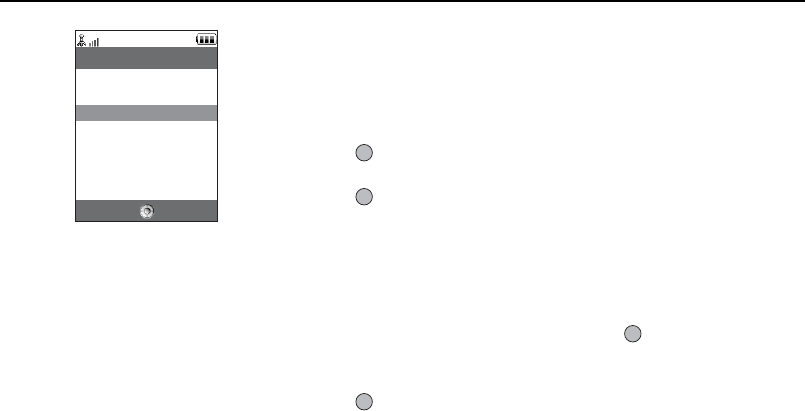
159
Organiser
Creating QR Codes
You can create QR codes using Contacts List entries, texts and My Items data.
“Organiser”
→
“Scanner”
→
“Create QR code”
1. Select the desired option.
“Text Input”: Create a QR code using the text you enter.
“My Items”: Create a QR code using the My Items data.
2. Press .
Creation of the barcode starts and is displayed on the screen.
3. Press .
Tip
•You can save the QR code in PNG format. Press [Options] and select “Save”.
Scanning Texts
“Organiser”
→
“Scanner”
→
“Scan Text”
1. Display the text using the external camera.
2. When the bar under the scanned text is blue, press .
The scanning starts and the scanned result is displayed.
3. Press a or b to select the desired text.
4. Press .
Select Back
Scanner
Scan Barcode
Open Barcode
Create QR code
Scan Text
Scanned Results

160
Organiser
5. Press [Options] and select the desired option.
“OK”: The scanned result is in the text entry screen.
“Select/Edit”: The scanned result can be modified.
“Change Mode”: The scanned result can be converted to a web address, mail
address, phone number or to roman text.
Using the Scanning Options
1. In the scanning mode, press [Options] and select the desired option.
“Start scanning”: Scanning is performed.
“Saved Files”: The saved files are displayed.
“Auto Focus”: Select the focusing option from “Standard”, “Macro” or
“Manual”.
“Reversed Text”: Select the desired option from “Auto”, “Standard Text” or
“Reversed Text”.
“Mobile Light”: The mobile light is turned on or off.
“Brightness”: The brightness is adjusted in the following steps: +2, +1, 0,
−1, −2.
“Key Ops Guide”: The Help for using the scan function is displayed.
Deleting the Scanned Data
“Organiser”
→
“Scanner”
→
“Scanned Result”
1. Highlight the data you wish to delete.
2. Press [Options] and select “Delete”.

161
Organiser
Renaming the Scanned Data
“Organiser”
→
“Scanner”
→
“Scanned Result”
1. Highlight the data you wish to rename.
2. Press [Options] and select “Rename”.
Checking the Information of the Scanned Data
“Organiser”
→
“Scanner”
→
“Scanned Result”
1. Highlight the data the information of which you wish to check.
2. Press [Options] and select “Information”.
Stopwatch
You can store 4 lap times when using the stopwatch function.
“Organiser”
→
“Stopwatch”
1. Press to start.
Press [LAP] to view the lap time before the stopwatch stops. Last 4 lap times are saved.
2. Press to stop.
Tip
•You can save a record of lap time and stop time in Text Templates by pressing [Options]
and selecting “Save to Templates”.
Resetting Time
1. After stopping the stopwatch, press [Options] and select “Reset”.
(M 7-6)

162
Organiser
Tasks
You can register your schedule as task entries which are associated with the date and time.
Creating a New Entry
“Organiser”
→
“Tasks”
1. Select “Add New Entry”.
2. Enter the subject.
3. Enter the due date and then due time.
4. Select the reminder option.
When selecting “Other”, enter the desired reminder date and time.
5. Select “Description” and enter a memo for the task entry.
6. Select “Secret” and select “On” or “Off” to make it a secret data.
7. Press [Save].
Note
•If the date and time settings have not been made, the date and time entry screen is
displayed (p. 185).
Setting the Alarms
You can set the alarm at a specified time on the entry.
“Organiser”
→
“Tasks”
1. Highlight the desired entry.
2. Press [Options] and select “Edit”.
3. Select “Reminder” and “Reminder Time”.
4. Select the desired reminder time.
(M 7-7)

163
Organiser
To Change the Type of Alarm Tone
1. On the Reminder screen, select “Tone/Video”.
2. Select “Assign Tone”.
3. Select “Preset Sounds” or “My Sounds”.
4. Select the desired tone.
For details on selecting a tone, see “Assigning a Ringtone” on page 172.
To Change the Type of Video
1. On the Reminder screen, select “Tone/Video”.
2. Select “Assign Video”.
3. Select the desired video clip file.
To Change the Duration of Alarm Tone or Video
1. On the Reminder screen, select “Duration”.
2. Select the desired duration.
Editing the Task Entry
“Organiser”
→
“Tasks”
1. Highlight the desired entry.
2. Press [Options] and select “Edit”.
3. Modify the entry.

164
Organiser
Sending a Task Entry
“Organiser”
→
“Tasks”
1. Highlight the task entry you wish to send.
2. Press [Options] and select “Send”.
3. Select the desired option.
“As Message”: Sends the entry as a message.
“Via Bluetooth”: Sends the entry through Bluetooth conneciton.
“Via Infrared”: Sends the entry through Infrared connection.
For “Via Bluetooth”
For details, see “Bluetooth” on page 205.
For “Via Infrared”
For details, see “Infrared” on page 211.
Note
•When pairing, you need to enter your passcode when establishing contact with a
Bluetooth wireless technology enabled device for the first time.
Viewing the Memory Status
“Organiser”
→
“Tasks”
1. Highlight the task entry you wish to view the memory status of.
2. Press [Options] and select “Memory Status”.
The current memory status is displayed.

165
Organiser
Deleting Entries
“Organiser”
→
“Tasks”
→
[Options]
→
“Delete”
1. Select the desired option.
“Delete This Tasks”: Deletes the selected entry.
“All Completed Tasks”: Deletes all checked entries.
“All Tasks”: Deletes all entries.
World Clock
Setting the Time Zone
“Organiser”
→
“World Clock”
1. Select the current local time zone.
2. Select “Set Time Zone”.
The current time zone is indicated on the world map.
3. Press c or d to change the time zone.
4. Press .
(M 7-8)

166
Organiser
To Set the Custom Time Zone
“Organiser”
→
“World Clock”
1. Select the current local time zone.
2. Highlight “Set Time Zone”.
3. Press [Options] and select “Set Custom Zone”.
4. Enter the desired city name and time.
5. Press [OK].
Setting the Daylight Saving
“Organiser”
→
“World Clock”
1. Select the current local time zone.
2. Select “Daylight Saving”.
3. Select “On” or “Off”.
Countdown Timer
“Organiser”
→
“Countdown Timer”
1. Enter the time to count.
You can set the time from 1 second to 60 minutes.
2. Press [OK].
3. Press to start counting.
4. Press to pause.
Press again to continue counting.
(M 7-9)

167
Organiser
5. When the countdown has finished, press C and then to start the countdown
again.
Editing the Countdown Time
1. In the countdown start screen, press [Options] and select “Edit”.
2. Modify the desired time.
3. Press [OK].
Expenses Memo
You can record an expenses memo with predefined or edited categories.
Recording in the Expenses Memo
“Organiser”
→
“Expenses Memo”
→
“Add New Expense”
1. Enter the expenses using the digit keys.
2. Select the desired category.
Expenses memo is registered.
Viewing Totals
“Organiser”
→
“Expenses Memo”
→
”Totals”
Recorded expenses are displayed on the screen.
To Change Amount
1. In the total view, select the desired item.
2. Press [Options] and select “Change Amount”.
3. Enter the desired amount using the digit keys.
(M 7-10)

168
Organiser
To Delete a Recorded Item
1. In the total view, select the desired item.
2. Press [Options] and select “Delete Item”.
The selected item is deleted from the list.
To Delete All Items
1. In the total view, select the desired item.
2. Press [Options] and select “Delete All”.
Editing the Category Name
“Organiser”
→
“Expenses Memo”
→
“Edit Category”
1. Select the desired category name.
2. Modify the name.
Phone Help
You can view the help list and use it to guide you in the phone’s functions.
“Organiser”
→
“Phone Help”
1. Press a or b.
(M 7-11)

169
SIM Application (M 9)
You can refer to the information on the SIM/USIM. Contact your service provider for further
details.
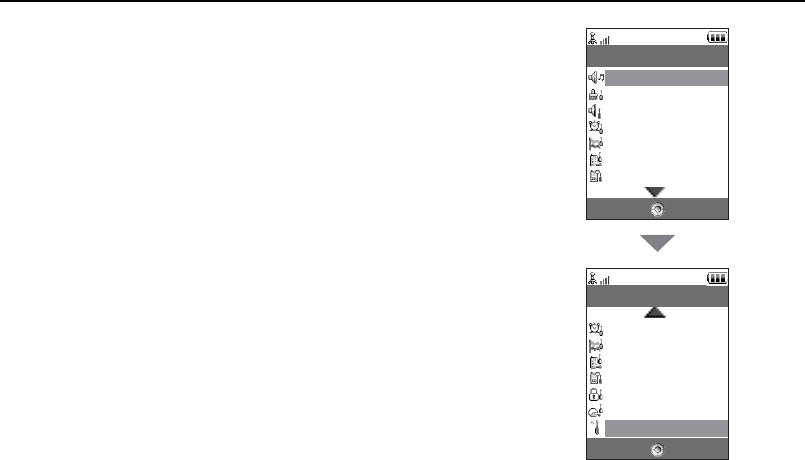
170
Settings (M 12)
Profiles
The tone sound and vibration settings can be customised for each profile according to your
environment.
There are 6 profiles: “Normal”, “Meeting”, “Activity”, “Car”, “Headset” and “Silent”.
Activating a Profile
“Settings”
→
“Profiles”
1. Select the desired profile.
Note
•When a profile is set, the corresponding indicator described on page 27 is displayed
during stand-by.
Tip
•Press and hold R to switch Profiles settings between the mode most recently activated
and Silent mode during stand-by.
Customising Profiles
“Settings”
→
“Profiles”
1. Highlight the profile you wish to customise.
2. Press [Options] and select “Personalise”.
3. Select the setting you wish to customise and change as desired.
For details on settings, see pages 171 to 176.
(M 12-1)
Select Back
Settings
Profiles
Display Settings
Sound Settings
Time & Date
Language
Call Settings
Video Call Settings
Select Back
Settings
Time & Date
Langage
Call Settings
Video Call Settings
Security Settings
Memory Settings
Master Reset

171
Settings
Resetting Profile Settings
“Settings”
→
“Profiles”
1. Highlight the profile you wish to reset.
2. Press [Options] and select “Set to Default”.
3. Enter your handset code.
The default handset code is “9999”. For details on changing the handset code, see “To
Change the Handset Code” on page 198.
Ringer Volume
You can adjust the ringer volume to one of six levels or to a step tone.
“Settings”
→
“Profiles”
1. Highlight the profile you wish to customise.
2. Press [Options] and select “Personalise”.
3. Select “Volume”.
The current volume level is displayed.
4. Press a (or d) to increase the ringer volume or press b (or c) to decrease the
ringer volume and then press .
To select “Step Tone”, press a (or d) at level 5.
To select “Silent”, press b (or c) at level 1.

172
Settings
Tip
•You can select from two levels or a step tone, when selecting the “Silent” profile.
Assigning a Ringtone
You can select the ringtone from 28 tones including 5 patterns, 3 alerts, 10 sound effects
and 10 melodies. You can also select a sound in Saved Sounds as the default ringtone
excluding the AMR or WAVE format.
“Settings”
→
“Profiles”
1. Highlight the profile you wish to customise.
2. Press [Options] and select “Personalise”.
3. Select “Ringtone/Ringvideos”.
4. Select “For Voice Call”, “For Video Call” or “For New Messages”.
5. Select “Assign Tone”.
6. Select “Preset Sounds” or “My Sounds”.
7. Select the ringtone you wish to use.
To hear the demo play, press [Options] and select “Play”.
8. Press [Options] and select “Assign”.

173
Settings
Note
•Even if you delete a ringtone that uses a sound in Saved Sounds, the setting remains the
same and the default ringtone sounds. If you delete a ringtone assigned for the Power On
sound, the default ringtone is set.
Assigning a Ring Video Clip File
You can select the ring video clip file from 5 preset video clip files. You can also select a
video clip file in Saved Videos as the default ring video clip file.
“Settings”
→
“Profiles”
1. Highlight the profile you wish to customise.
2. Press [Options] and select “Personalise”.
3. Select “Ringtone/Ringvideos”.
4. Select “For Voice Call”, “For Video Call” or “For New Messages”.
5. Select “Assign Video”.
6. Select the ring video clip file you wish to use.
To preview the file, press [Options] and select “Play”.
7. Press [Options] and select “Assign”.

174
Settings
Message Notification
When receiving messages, your phone will notify you of their arrival with the ringtone or ring
video you specify.
“Settings”
→
“Profiles”
1. Highlight the profile you wish to customise.
2. Press [Options] and select “Personalise”.
3. Select “Ringtone/Ringvideos”.
4. Select “For New Messages”.
5. Select “Assign Tone” or “Assign Video”.
6. Select the desired ringtone or ring video clip.
For details on selecting a ringtone or a ring video, see “Assigning a Ringtone” on
page 172 or “Assigning a Ring Video Clip File” on page 173.
7. Press [Assign].
8. Select “For New Messages” and select “Duration”.
9. Enter the desired duration.
Keypad Tones
When the keypad tone is set on, you will hear a confirmation tone each time you press any
keys.
“Settings”
→
“Profiles”
1. Highlight the profile you wish to customise.
2. Press [Options] and select “Personalise”.

175
Settings
3. Select “System Sounds”.
4. Select “Keypad Tones”.
5. Select the desired tone pattern.
6. Press [Options] and select “Assign”.
Vibration
When the vibrator option is set on, the phone will vibrate for incoming calls regardless of the
ringer volume and ringtone settings.
“Settings”
→
“Profiles”
1. Highlight the profile you wish to customise.
2. Press [Options] and select “Personalise”.
3. Select “Vibration”.
4. Select “On”, “Link to Sound” or “Off”.
Tip
•When the “Link to Sound” option is selected in step 4, the vibrator synchronises with your
selected melody to pulse in time with the melody. Please note that not all melodies
support the “Link to Sound” option.
•When you select “On” or “Link to Sound” in step 4, “ ” is displayed during stand-by.

176
Settings
External Light Colour
You can select from 7 colours and 1 pattern for each profile and change it during an
incoming call.
“Settings”
→
“Profiles”
1. Highlight the profile you wish to customise.
2. Press [Options] and select “Personalise”.
3. Select “External Light”.
4. Select “For Voice Call”, “For Video Call” or “For New Messages”.
5. Select the desired colour or “Off”.
Tip
•If you select “Disco” in step 5, all 7 colours flash in order during an incoming call.
Any Key Answer
You can answer a call by pressing any key except F or [Busy]. For details, see page 37.
“Settings”
→
“Profiles”
1. Highlight the profile you wish to customise.
2. Press [Options] and select “Personalise”.
3. Select “Any Key Answer”.
4. Select “On” or “Off”.

177
Settings
Setting the Display
You can change the settings of the main and sub displays.
Setting the Main Display
Wallpaper
For the stand-by screen, 5 pictures are provided.
Pictures taken with the digital camera or images downloaded from a WAP site can be used
for wallpapers.
Setting My Pictures
“Settings”
→
“Display Settings”
→
“Wallpaper”
1. Select “My Pictures”.
2. Select the desired picture.
3. After displaying the picture, press .
Note
•Some pictures cannot be used because of their picture and data types.
•If the picture in My Pictures is already set, it is displayed in step 1. Press [Change] and
select the desired picture.
(M 12-2)

178
Settings
Assigning the Pictures
Pictures can be displayed when turning the power on or off, when receiving an incoming
call, or when operating the alarm.
Pictures taken with the digital camera or images downloaded from a WAP site can be used.
To Set Built-in Pictures
“Settings”
→
“Display Settings”
→
“System Graphics”
1. Select the desired scene to set the picture to.
2. Select “Preset Animation” when you select “Power On” or “Power Off” in step 1.
Select “Pattern 1”, “Pattern 2” or “Pattern 3” when you select “Incoming Call” or
“Alarm” in step 1.
To Set My Pictures
“Settings”
→
“Display Settings”
→
“System Graphics”
1. Select the desired scene to set the picture to.
2. Select “My Pictures”.
3. Select the desired picture.
4. After displaying the picture, press .

179
Settings
Note
•Some pictures cannot be used because of their picture and data types.
•If the picture in My Pictures is already set, it is displayed in step 2. Press [Change] and
select the desired picture.
Setting the Font Weight
You can change the font weight displayed on the screen.
“Settings”
→
“Display Settings”
→
“Font Settings”
1. Select “Very Thin”, “Thin”, “Normal” or “Bold”.
The preview image is displayed in the selected weight.
Setting the Greeting Message
You can set the message which is displayed when the phone is turned on.
“Settings”
→
“Display Settings”
→
“Greeting Message”
→
“Switch On/Off”
1. Select “On” or “Off”.
2. Select “Edit Message” and enter the message when you select “On” in step 1.
Up to 16 characters can be saved as a message.
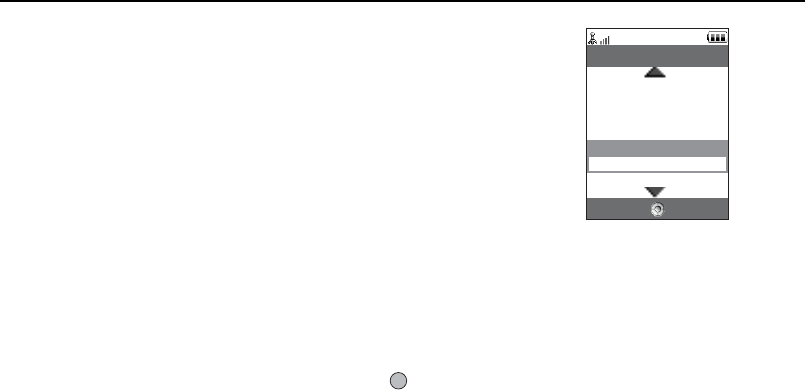
180
Settings
Setting the Sub Display
To Turn On/Off the Sub Display
You can turn the sub display on or off when the phone is closed.
“Settings”
→
“Display Settings”
→
“Sub Display”
→
“Display On/Off”
1. Select “On” to turn sub display on or “Off” to turn sub display off.
To Turn On/Off the Backlight of the Sub Display
You can turn the backlight of the sub display on or off when the phone is closed.
“Settings”
→
“Display Settings”
→
“Sub Display”
→
“Backlight”
1. Select “On” or “Off”.
To Select the Backlight Time Out
“Settings”
→
“Display Settings”
→
“Sub Display”
→
“Backlight”
1. Select the desired time out.
Select “Off” to shut the backlight off.
To Adjust the LCD Contrast of the Sub Display
You can adjust the LCD contrast of the sub display to suit certain lighting conditions.
“Settings”
→
“Display Settings”
→
“Sub Display”
→
“Contrast”
1. Press a (Light) or b (Dark) to adjust the contrast and press .
The LCD contrast can be adjusted to 9 levels.
Select Back
Display Settings
Font Settings
Normal
Greeting Message
Off
Sub Display
On
Clock & Calendar

181
Settings
To Set Incoming Indication
Caller number or registered caller name can be displayed on the external display when
receiving an incoming call.
“Settings”
→
“Display Settings”
→
“Sub Display”
→
“Caller Display”
1. Select “On” or “Off”.
Showing the Clock
You can display the calendar or the current date and/or time during stand-by.
To Set the Clock Display of the Main Display
“Settings”
→
“Display Settings”
→
“Clock & Calendar”
→
“Show Clock”
1. Select the desired clock type or “Off” to set clock display off.
Tip
•When you select “Calendar”, you can display one or two consecutive calendars by
selecting “1 Month” or “2 Months”.
Backlight
The backlight will shut off if you do not press the keypad for a certain length of time. You
can specify a desired time to elapse before the backlight shuts off, which will help conserve
battery life.
Tip
•When you purchase this phone, Backlight is set to 15 seconds.

182
Settings
To Select the Backlight Time Out
“Settings”
→
“Display Settings”
→
“Backlight”
1. Select the desired time.
Select “Off” to shut it off.
Adjusting the Brightness of the Backlight
You can adjust the brightness of the backlight of the screen between 4 levels.
“Settings”
→
“Display Settings”
→
“Brightness”
1. Press a (Light) and b (Dark) for maximum clarity.
2. Press .
Setting the Display Saving
The screen of this phone will automatically turn off after a given amount of time. You can
change the length of time before the Display Saving goes into effect, which will help
conserve battery life.
Tip
•When you purchase this phone, Display Saving is set to 2 minutes.
“Settings”
→
“Display Settings”
→
“Display Saving”
1. Select the desired time.

183
Settings
Note
•Display Saving does not work while you are making a call, using WAP, or using an
application.
•To cancel the Display Saving: The display saving continues until either a key is pressed
or there is an incoming alert. The first key press only cancels this function. You must
press another key in order to enter any numerical or text value.
Setting Video Out
With the optional cable, you can connect your phone to other device, such as TVs or videos
set to output, and display images or video clips stored on your phone. It is also possible to
output and display data stored in the memory card.
To Set Output Function On
You need to connect your phone to the other device with the optional cable beforehand.
“Settings”
→
“Display Settings”
→
“Video Output”
→
“Output”
→
“On”
Select “Off” on the Output screen when finished.
Note
•When closing your phone, you cannot output data to the connected device.
•It is not possible to output some images or video clips.

184
Settings
To Select Display Size
You can display images in enlarged size.
“Settings”
→
“Display Settings”
→
“Video Output”
→
“Display Size”
1. Select “Enlarge”.
To display in original size, select “Original Size”.
To Rotate Image
“Settings”
→
“Display Settings”
→
“Video Output”
→
“Rotate Image”
1. Select the desired item.
The image displayed on the device will rotate until the selected degree.
To Select TV System
You need to select the appropriate TV system. Refer to the instruction manual of your
connected device to confirm the TV system.
“Settings”
→
“Display Settings”
→
“Video Output”
→
“TV System”
1. Select the desired item.
Sound Settings
You can use this menu to check or edit the current Profiles settings (except “Any Key
Answer”).
(M 12-3)

185
Settings
Time & Date
You need to set the correct time and date in order for your phone’s various time-based
functions to work correctly.
“Settings”
→
“Time & Date”
→
“Set Date/Time”
1. Enter the day, month and year using the digit keys.
2. Enter the time using the digit keys.
Tip
•When you enter the time in the 12-hour format, press a or b to switch between am
and pm. The order in which the date and time is displayed is based on the format setting.
Selecting the Time Format
“Settings”
→
“Time & Date”
→
“Time Format”
1. Select “24 Hour” or “12 Hour”.
(M 12-4)

186
Settings
Selecting the Date Format
“Settings”
→
“Time & Date”
→
“Date Format”
1. Select from “D.M.Y”, “M-D-Y” or “Y/M/D”.
Setting the Daylight Saving
“Settings”
→
“Time & Date”
→
“Daylight Saving”
1. Select “On” or “Off”.
Setting the Time Zone
“Settings”
→
“Time & Date”
→
“Set Time Zone”
1. Press c or d to select the home city to set.
2. Press .
Customising the Time Zone
“Settings”
→
“Time & Date”
→
“Set Time Zone”
→
[Options]
→
“Set Custom
Zone”
1. Enter the city name.
2. Enter the time-zone differences using the digit keys.
Pressing Q switches between – and +.
3. Press .
Setting the Calendar Format
“Settings”
→
“Time & Date”
→
“Calendar Format”
1. Select “Sunday-Saturday” or “Monday-Sunday”.

187
Settings
Language Setting
You can change the language that the phone uses to display messages.
“Settings”
→
“Language”
1. Select the desired language.
Tip
•You can also change the input language on the text entry screen (p. 65).
Note
•If you select “Automatic” in step 1, the language preset on the SIM/USIM card is selected.
•If the language preset on the SIM/USIM card is not supported, then the default language
of the phone is selected.
Call Settings
Set various types of functions and services for voice calls.
Diverts
Note
•This service may not be available on all mobile phone networks. Contact your network
operator for more information.
This service is used to divert incoming calls to your voice mail system or to another phone
number depending on certain conditions in which you cannot answer a call.
(M 12-5)
(M 12-6)

188
Settings
To Divert Calls
“Settings”
→
“Call Settings”
→
“Diverts”
1. Select one of the following options:
“All Calls”: Diverts all calls without ringing.
“When Busy”: Diverts incoming calls when you are talking on the phone.
“No Answer”: Diverts incoming calls if you do not answer a call within a certain
period of time.
“Not Reachable”: Diverts incoming calls when your phone has no network service or
is switched off.
“Cancel All”: Clears all the above settings.
If you select “No Answer”, go to step 5.
2. Select “On”.
3. Enter a phone number to which you wish to divert calls or search for it in the
Contacts List (p. 56).
To use a phone number in the Contacts List, press [Contacts].
4. Press .
5. Select the period of time from 6 levels (05 to 30 seconds).
Note
•When a divert is set to “All Calls”, “ ” is displayed during stand-by.
Tip
•If you select “By Service” in step 2, you can select further divert options.

189
Settings
To Check the Divert Status
“Settings”
→
“Call Settings”
→
“Diverts”
1. Select the divert option you wish to check.
2. Select “Status”.
Call Waiting
Note
•This service may not be available on all mobile phone networks. Contact your network
operator for more information.
If you wish to be able to receive another incoming call while you have a call in progress, you
must activate the Call Waiting service.
“Settings”
→
“Call Settings”
→
“Call Waiting”
1. Select “On”, “Off” or “Status”.
Showing Your Phone Number
This lets you control whether to show your phone number when calling another party or not.
“Settings”
→
“Call Settings”
→
“Show Your Number”
1. Select “On”, “Off” or “Status”.
Note
•Some networks do not support this service. Please check with your service provider for
availability.

190
Settings
Call Information
With this setting On, the information of an incoming call is displayed.
“Settings”
→
“Call Settings”
→
“Display Call Info”
1. Select “On” or “Off”.
Restrict Calls
This function lets you place restrictions on incoming and outgoing calls. To activate this
option you will need the specified password, which is available from your service provider.
“Settings”
→
“Call Settings”
→
“Restrict Calls”
1. Select from one of the following options:
“Outgoing Calls”: Restricts outgoing calls.
“Fixed Dialling No.”: Restricts calls for fixed dialling numbers in the Contacts List.
“Incoming Call”: Restricts incoming calls.
“Rejected Numbers”: You can register for dialling numbers to be restricted.
“Change N/W Password”: Changes the network password.
2. Select one of the following options:
(For “Outgoing Calls”)
“Bar All Outgoing Calls”: Restricts all outgoing calls except emergency calls.
“Bar International Calls”: Restricts all outgoing international calls.
“Only Local & Home”: Restricts all outgoing international calls except to your home
country.

191
Settings
(For “Incoming Calls”)
“Bar All Incoming Calls”: Restricts all incoming calls.
“Bar if Abroad”: Restricts all incoming calls when you are outside of the
coverage from your registered network operator.
3. Select one of the following options:
(For “Outgoing Calls” and “Incoming Calls”)
“All Services”: Restricts all services.
“Voice Calls”: Restricts all voice calls.
“Video Calls”: Restricts all video calls.
“Data”: Restricts all data calls.
“Fax”: Restricts all fax calls.
“Messages”: Restricts all messages.
“All except msgs”: Restricts all services except messages.
4. Select “On”, “Off” or “Status”.
5. Enter the network password.
To Cancel Settings
“Settings”
→
“Call Settings”
→
“Restrict Calls”
1. Select “Outgoing Calls” or “Incoming Calls”.
2. Select “Cancel All”.
3. Enter the network password.

192
Settings
Fixed Dialling No.
When the Fixed Dialling No. is enabled, you can only call pre-registered numbers.
To Enable Fixed Dialling No.
“Settings”
→
“Call Settings”
→
“Restrict Calls”
→
“Fixed Dialling No.”
→
“Switch On/Off”
1. Select “On” to enable this function.
To Add a New Name
“Settings”
→
“Call Settings”
→
“Restrict Calls”
→
“Fixed Dialling No.”
→
“Edit
Dial List”
1. Press [Options] and select “Add New Dial”.
2. Enter your PIN2 code.
3. Add a name and a phone number.
For details on adding a name and a phone number, see “Add New Contact” on page 54.
4. Press [Save].

193
Settings
Rejecting an Incoming Call
You can register phone numbers you do not wish to answer.
To Reject the Registered Number
“Settings”
→
“Call Settings”
→
“Restrict Calls”
→
“Rejected Numbers”
→
“Switch On/Off”
1. Select “On” or “Off”.
To Register the Rejected Number
“Settings”
→
“Call Settings”
→
“Restrict Calls”
→
“Rejected Numbers”
→
“Set
Rejecting Number”
1. Select a blank field.
2. Enter the desired number.
Changing the Network Password
“Settings”
→
“Call Settings”
→
“Restrict Calls”
→
“Change N/W Password”
1. Enter the old network password.
2. Enter a new network password.
3. Enter the new network password again.
If you enter the incorrect password, you are asked to enter the password again.
4. Press .

194
Settings
Minute Minder
Minute Minder function informs you of your talk time by sounding a tone after every minute.
“Settings”
→
“Call Settings”
→
“Minute Minder”
1. Select “On” or “Off”.
Displaying Call Timer
“Settings”
→
“Call Settings”
→
“Display Call Timer”
1. Select “On” or “Off”.
Video Call Settings
Set various types of functions and services for video calls.
Selecting an Image for the Alternative Image
You can select your image to be sent through the internal camera from the saved picture
files.
Turning On or Off the Speakers
“Settings”
→
“Video Call Settings”
1. Select “Switch Loud Speaker On” to turn on the stereo speakers on the back of the
phone, or select “Switch Loud Speaker Off” to turn them off.
Selecting the Picture Quality
Select the desired incoming data format for your environment.
“Settings”
→
“Video Call Settings”
→
“Picture Quality”
1. Select from “Normal”, “Quality Prior” or “Frame Rate Prior”.
Select “Frame Rate Prior” to perform faster communication.
(M 12-7)

195
Settings
Backlight
With this setting On, the phone’s backlight is on when making a video call.
“Settings”
→
“Video Call Settings”
→
“Backlight”
1. Select “On”, “As Normal Setting” or “Off”.
The “As Normal Setting” option depends on the backlight setting of the main display
(p. 181).
Mute
You can mute the microphone while making a video call.
“Settings”
→
“Video Call Settings”
→
“Mute Microphone”
1. Select “Unmute Microphone” to cancel the mute.
Assigning Hold Guidance Picture
You can display an image saved in the phone on your main display while you are putting a
call on hold.
“Settings”
→
“Video Call Settings”
→
“Hold Guidance Pict”
1. Select “Preset Picture” or “My Pictures”.
2. Select the desired picture.

196
Settings
Security
Enabling/Disabling the PIN Code
If the PIN code is enabled you are asked to enter the PIN code each time the phone is
switched on. Your PIN code is registered on the SIM/USIM card and you should have been
made aware of the code when you purchased the SIM/USIM card. Contact your service
provider for further details.
“Settings”
→
“Security Settings”
→
“PIN Entry”
→
“Switch On/Off”
1. Select “On” to enable the PIN code or “Off” to disable.
2. Enter your PIN code.
Note
•If you enter the wrong PIN code three times in step 2, the SIM/USIM card will lock. To
remove the lock, contact your service provider/SIM/USIM card vendor.
To Change the PIN Code
This allows you to change the PIN code registered on the SIM/USIM card. Before you change
the PIN code, select “On” in step 1 in “Enabling/Disabling the PIN Code”.
“Settings”
→
“Security Settings”
→
“PIN Entry”
→
“Change PIN”
1. Enter the existing PIN code.
2. Enter a new PIN code.
3. Enter the new PIN code again.
(M 12-8)

197
Settings
Changing the PIN2 Code
The PIN2 code is used to protect certain functions in the phone such as Fixed Dialling No.
and call cost limits. The following shows you how to change the PIN2 code.
“Settings”
→
“Security Settings”
→
“Change PIN2”
1. Enter the existing PIN2 code.
2. Enter a new PIN2 code.
3. Enter the new PIN2 code again.
Handset Lock
The Handset Lock is an additional security feature which prevents unauthorised use of the
phone or certain features.
“Settings”
→
“Security Settings”
→
“Handset Lock”
1. Select “On” or “Off”.
2. Enter your handset code.
The default handset code is “9999”. For details on changing the handset code, see “To
Change the Handset Code” on page 198.

198
Settings
To Change the Handset Code
Before you change the handset code, select “On” in step 1 in “Handset Lock”.
“Settings”
→
“Security Settings”
→
“Change Handset Code”
1. Enter the old handset code.
2. Enter a new handset code.
3. Enter the new handset code again.
Phone Lock
By setting this option on, your phone will lock the keypad until the correct handset code is
entered.
“Settings”
→
“Security Settings”
→
“Phone Lock”
1. Select “On” or “Off”.
To Activate Your Phone after turning on the Phone Lock
You need to enter your handset code after setting Phone Lock on.
1. Enter your handset code.
The default handset code is “9999”. For details on changing the handset code, see “To
Change the Handset Code”.
To Turn Off the Phone Lock
Enter your handset code during stand-by to turn the Phone Lock off.

199
Settings
Showing Secret Data
By setting this option on, the hidden data can be displayed.
“Settings”
→
“Security Settings”
→
“Show Secret Data”
1. Select “On” to display or “Off” to hide.
Memory Settings
Viewing the Memory Status
“Settings”
→
“Memory Settings”
→
“Memory Status”
1. Select from “Handset” or “Memory Card”.
The memory status of the selected item is displayed.
Formatting Memory Card
“Settings”
→
“Memory Settings”
→
“Format Card”
1. Enter your handset code.
The default handset code is “9999”. For details on changing the handset code, see “To
Change the Handset Code” on page 198.
2. Press [Yes] to start formatting.
(M 12-9)

200
Settings
Master Reset
You can reset M12 settings or all settings from M1 to M12.
Resetting M12 Settings
“Settings”
→
“Master Reset”
→
“Reset Settings”
1. Enter your handset code.
The default handset code is “9999”. For details on changing the handset code, see “To
Change the Handset Code” on page 198.
Resetting All Settings from M1 to M12
“Settings”
→
“Master Reset”
→
“Reset All”
1. Enter your handset code.
The default handset code is “9999”. For details on changing the handset code, see “To
Change the Handset Code” on page 198.
(M 12-10)

201
Call Log (M 11)
The phone will record the last 10 missed calls, received calls and dialled numbers.
Viewing Call Log
“Call Log”
1. Select a tab from “A” for All Calls, “D” for Dialled Calls, “M” for Missed Calls or “R”
for Received Calls.
The selected call log list is displayed.
To switch logs, press c or d.
2. Select the phone number you wish to view.
If you wish to dial the number, press .
Tip
•You can also confirm call logs by pressing D during stand-by.
Sending Messages
1. In the call log list, highlight the call log you wish to send a message to.
2. Press [Options] and select “Create Message”.
3. Select “Multimedia” or “Text”.
For details on creating a message, see “Creating a New Message” on page 87.
Select Back
Call Log
All Calls
Missed Calls
Received Calls
Dialled Calls
Call Timers
Call Costs

202
Call Log
Deleting a Call Log
1. In the call log list, press [Options] and select “Delete”.
Call Timers
This function lets you check the duration of your calls.
Checking the Duration of the Last Call and All Calls
“Call Log”
→
“Call Timers”
1. Select “Received Calls” or “Dialled Calls”.
The duration of the last call and all calls is displayed.
Resetting Call Timers
“Call Log”
→
“Call Timers”
→
“Clear Timers”
1. Enter your handset code.
The default handset code is “9999”. For details on changing the handset code, see “To
Change the Handset Code” on page 198.
(M 11-5)

203
Call Log
Call Costs
This function lets you check the charges for your calls.
Some networks do not support
Charging Advice. Please check with your service provider for availability.
Checking the Cost of the Last Call
“Call Log”
→
“Call Costs”
→
“Last Call”
The cost of the last call is displayed.
Checking the Total Call Cost
“Call Log”
→
“Call Costs”
→
“All Calls”
The cost of all calls is displayed.
Setting the Charge Rate
Set the charge rate to calculate the call cost and set the maximum limit for call cost.
“Call Log”
→
“Call Costs”
→
“Cost Units”
→
“Set Units”
1. Enter your PIN2 code.
2. Enter a currency unit (up to 3 characters).
3. Enter a cost per unit.
To enter a decimal point, press R.
(M 11-6)

204
Call Log
Setting the Charge Limit
This function is useful if you wish to make sure you do not exceed a certain charge limit.
“Call Log”
→
“Call Costs”
→
“Max Cost”
→
“Set Limit”
1. Enter your PIN2 code.
2. Enter a value.
Checking the Residual Credit
“Call Log”
→
“Call Costs”
→
“Residual Credit”
Resetting All Call Costs
“Call Log”
→
“Call Costs”
→
“Clear Costs”
1. Enter your PIN2 code.
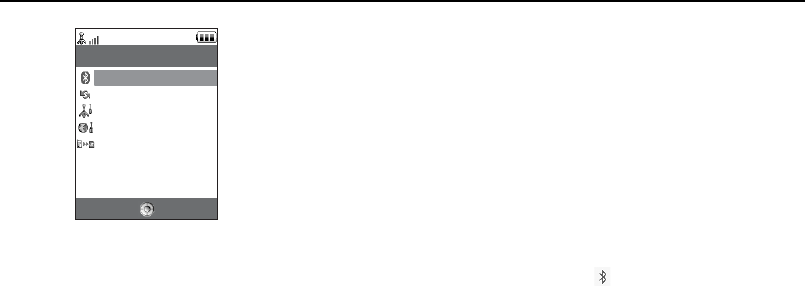
205
Connectivity (M 10)
By configuring the settings in this menu, you can connect to
Bluetooth
wireless technology
or infrared enabled phones via these connections, as well as a PC via
Bluetooth
wireless
technology or infrared connections.
Bluetooth
For using the
Bluetooth
wireless function, you need to search for other
Bluetooth
wireless
technology enabled devices to establish contact with your phone. Keep your phone within a
distance of 10 metres before searching.
Using the Bluetooth Wireless Function
To Turn On or Off
“Connectivity”
→
“Bluetooth”
→
“Switch On/Off”
1. Select “On” or “Off”.
The
Bluetooth
wireless setting is activated, and “ ” is displayed.
To Show or Hide Your Phone
“Connectivity”
→
“Bluetooth”
→
“Visibility”
1. Select the desired visibility settings.
“Show My Phone”:
Allows other devices to recognise your phone.
“Hide My Phone”:
Hides your phone from other devices.
Select Back
Connectivity
Bluetooth
Infrared
Network Settings
Internet Settings
Backup/Restore
(M 10-1)

206
Connectivity
To Search for Devices to be Paired
“Connectivity”
→
“Bluetooth”
→
“Search for Devices”
The phone starts searching for devices within 10 metres. A maximum of 16 devices can be
searched for and listed on the displayed.
1. Select the desired device for pairing.
2. Enter the device passcode.
Note
•If the Bluetooth wireless function is off before searching, the phone turns the Bluetooth
wireless function on automatically and starts searching.
•You can only select one device for pairing. To change the paired device, see “Handsfree
Devices”.
Handsfree Devices
You can activate, rename and delete the paired handsfree device in the list.
To Activate a Device
“Connectivity”
→
“Bluetooth”
→
“Handsfree Devices”
1. Select the device you wish to activate.

207
Connectivity
Tip
•You can save battery power by turning the Bluetooth wireless function off while it is not
in use. Turn the Bluetooth wireless function off in “To Turn On or Off” on page 205 or in
“To Turn Off Automatically” on page 210.
•During a call, you can divert voice calls to the paired device. Press [Options] and select
“Bluetooth Headset”. If you wish to disconnect the paired device, select “Off”.
To Rename a Device
“Connectivity”
→
“Bluetooth”
→
“Handsfree Devices”
1. Highlight the device you wish to rename.
2. Press [Options] and select “Change Name”.
3. Enter your handset code.
The default handset code is “9999”. For details on changing the handset code, see “To
Change the Handset Code” on page 198.
4. Rename the device.
To Clear a Device Name
“Connectivity”
→
“Bluetooth”
→
“Handsfree Devices”
1. Highlight the device you wish to clear.
2. Press [Options] and select “Delete”.

208
Connectivity
Paired Devices
You can rename and delete the paired device in the list.
“Connectivity”
→
“Bluetooth”
→
“Paired Devices”
1. Highlight the desired device.
2. Press [Options].
3. Select “Change Name” or “Delete”.
4. Enter your handset code.
The default handset code is “9999”. For details on changing the handset code, see “To
Change the Handset Code” on page 198.
You can rename or delete by pressing after selecting desired device.
To Send All Data to Other Devices
You can send all the data for applications such as Contacts List, Schedule, Tasks or etc. to
selected devices.
“Connectivity”
→
“Bluetooth”
→
“Send All”
1. Select the desired device.
If a device is not specified, searching starts automatically.

209
Connectivity
2. Enter the device passcode.
3. Select the desired data to send.
Note
•If the handsfree device is connected, the confirmation screen to deactivate the handsfree
function is displayed. Press [Yes] to deactivate.
Bluetooth Wireless Settings
With this setting you can rename your phone, prevent other phones from recognising your
phone, turn the
Bluetooth
wireless function off automatically to save battery power, etc.
To Rename Your Phone
You can rename your phone. The name is shown in other devices when your phone is
detected.
“Connectivity”
→
“Bluetooth”
→
“Bluetooth Settings”
→
“Device Name”
1. Enter your handset code.
The default handset code is “9999”. For details on changing the handset code, see “To
Change the Handset Code” on page 198.
2. Enter the new device name.

210
Connectivity
To Turn Off Automatically
“Connectivity”
→
“Bluetooth”
→
“Bluetooth Settings”
→
“Bluetooth Timeout”
1. Select the desired time.
Your phone turns the function off automatically in the specified time.
To Switch the Handsfree Settings
You can switch modes of the handsfree kit between two modes; talking with the handsfree
kit or talking with the phone.
“Connectivity”
→
“Bluetooth”
→
“Bluetooth Settings”
→
“Handsfree Settings”
1. Select “Private mode” or “Handsfree mode”.
“Private mode”: For talking with the handset
“Handsfree mode”: For talking with the handsfree kit

211
Connectivity
Infrared
In order to use the infrared function, you need to search for other infrared enabled devices
to establish contact with your phone. Keep your phone within a distance of 20 centimetres
before searching. The infrared setting will return to off when no data is transmitted/received
via infrared communication.
Turning On or Off
“Connectivity”
→
“Infrared”
→
“Switch On/Off”
1. Select “On” or “Off”.
The infrared setting is activated, and “ ” is displayed.
Sending All Data
“Connectivity”
→
“Infrared”
→
“Send All”
1. Enter the device passcode.
2. Select the desired data to send.
3. Enter the authorisation code.
Network Settings
System Settings
To Select a System Automatically
Each time the power is turned on, your phone always performs the selected system.
“Connectivity”
→
“Network Settings”
→
“System Settings”
→
“Auto”
(M 10-2)
(M 10-3)

212
Connectivity
To Set the System Manually
“Connectivity”
→
“Network Settings”
→
“System Settings”
1. Select “3G” or “GSM”.
Network Settings
To Select a Network Automatically
Each time the power is turned on, your phone always tries to connect to the preferred
network.
If your phone is not connected to the network, you can perform the following immediately
to establish the preferred network connection.
“Connectivity”
→
“Network Settings”
→
“Network Settings”
→
“Select
Network”
→
“Automatic”
To Set the Network Manually
“Connectivity”
→
“Network Settings”
→
“Network Settings”
→
“Select
Network”
→
“Manual”
1. Select the desired network.

213
Connectivity
To Add a New Network
“Connectivity”
→
“Network Settings”
→
“Network Settings”
→
“Select
Network”
→
“Add New Network”
If there are no entries, press and go to step 2.
If there is an entry, press and perform the following steps.
1. Select “Add”.
2. Enter the country code.
Up to 3 digits code can be entered.
3. Enter the network code.
Up to 3 digits code can be entered.
4. Enter a new network name.
Up to 25 characters can be entered.
5. Select “Select network type”.
6. Select the desired network.
To Change the Position of a Network in the Preferred List
“Connectivity”
→
“Network Settings”
→
“Network Settings”
→
“Select
Network”
→
“Set Preferred”
1. Select the name of the network you wish to change the position in the list.
2. Select “Insert” to insert over the selected position or “Add to end” to insert at the
end.

214
Connectivity
To Delete a Network from the Preferred List
“Connectivity”
→
“Network Settings”
→
“Network Settings”
→
“Select
Network”
→
“Set Preferred”
1. Select the name of the network you wish to delete.
2. Select “Delete”.
To Cut the Network Connection
“Connectivity”
→
“Network Settings”
→
“Network Settings”
→
“Off Line Mode”
1. Select “On” or “Off”.
To Show the Network Information
“Connectivity”
→
“Network Settings”
→
“Network Settings”
→
“Network
Information”
Information about the operator name, package and services are displayed.

215
Connectivity
Internet Settings
WAP/MMS Settings
Note
•In normal operations, you do not need to change the settings.
“Connectivity”
→
“Internet Settings”
→
“Application”
WAP Settings
“Profile Name”: WAP profile name (Unique name)
“Proxy”: Proxy setting for WAP
MMS Settings
“Profile Name”: MMS profile name (Unique name)
“Proxy”: Proxy setting for MMS
“Relay Server URL”: MMS relay server
EMail Settings
“Account Name”: Profile name, proxy and relay server URL for email
“POP3 Server”: Server name, user ID, password and port number for
POP3 server
“SMTP Server”: Server name, user ID, password and port number for
SMTP server
“SMTP Authentication”: Server name, user ID, password, port number for SMTP
server and SMTP Authentication
“Access Point”: Access point for email
“Email Address”: Email address
(M 10-4)

216
Connectivity
Streaming Settings
“Profile Name”: Profile name for streaming (unique name)
“Proxy Address”: Proxy address
“Port Number”: Port number (1-65535)
“Access Point”: Access point
Proxy Settings
“Proxy Name”: Proxy name
“Proxy Address”: Proxy address
“Access Point”: Access point
“Home Page”: Home page URL
“Port Number”: Port number (1-65535)
“Authentication Type”: Authentication Type (“HTTP-BASIC” or “HTTP-DIGEST”)
“User Name”: User name for authentication
“Password”: Password for authentication
Access Point Settings
“Access Point Name”: Access point name
“APN”: APN setting
“Authentication Type”: Authentication type (“PAP” or “CHAP”)
“User Name”: User name for access point
“Password”: Password for access point
“DNS”: DNS setting
“Linger Time”: Linger time setting

217
Connectivity
Re-Provisioning Operator Settings
“Get Latest”: Gets the latest provisioning data from the server.
“Execute Pending”: Updates provisioning data.
Clear DNS Cache: Clears the DNS cache.
White List:
“SMSC Address”: SMSC address
“SM Originating Address”: SM originating address
To Activate the WAP/MMS Profile
“Connectivity”
→
“Internet Settings”
→
“Application”
1. Select “WAP Settings” or “MMS Settings”.
2. Highlight the desired profile.
3. Press [Options] and select “Activate”.
To Edit the WAP/MMS Profile
“Connectivity”
→
“Internet Settings”
→
“Application”
1. Select “WAP Settings” or “MMS Settings”.
2. Highlight the desired profile.
3. Press [Options] and select “Edit”.
4. Edit the desired item.

218
Connectivity
To Copy the WAP/MMS Profile
“Connectivity”
→
“Internet Settings”
→
“Application”
1. Select “WAP Settings” or “MMS Settings”.
2. Highlight the desired profile.
3. Press [Options] and select “Copy”.
4. Edit the new profile name.
To Delete the WAP/MMS Profile
“Connectivity”
→
“Internet Settings”
→
“Application”
1. Select “WAP Settings” or “MMS Settings”.
2. Highlight the desired profile.
3. Press [Options] and select “Delete”.
Backup/Restore
With a memory card inserted in your phone, you can make backup files of Bookmarks, Text,
Contacts and Tasks in the handset memory card to the memory card. You can also restore
the backup data from the memory card.
(M 10-5)

219
Connectivity
Making a Backup File on the Memory Card
“Connectivity”
→
“Backup/Restore”
→
“Backup”
1. Enter your handset code.
The default handset code is “9999”. For details on changing the handset code, see “To
Change the Handset Code” on page 198.
2. Press [Yes].
3. Select the desired item to backup.
To Backup All Files
“Connectivity”
→
“Backup/Restore”
→
“Backup”
1. Enter your handset code.
2. Press [Yes].
3. Select “Select All”.
Restoring a Backup File
“Connectivity”
→
“Backup/Restore”
→
“Restore”
1. Enter your handset code.
2. Press [Yes].
3. Select the desired item.
4. Select the desired file to restore.
A confirmation message indicates deletion from the memory card is displayed on the
screen.
5. Press [Yes].

220
Connectivity
To Restore All Files
“Connectivity”
→
“Backup/Restore”
→
“Restore”
1. Enter your handset code.
2. Press [Yes].
3. Select “Select All”.
A confirmation message indicating deletion from the memory card is displayed on the
screen.
4. Press [Yes].
To Delete a Backup File
“Connectivity”
→
“Backup/Restore”
→
“Restore”
1. Enter your handset code.
2. Press [Yes].
3. Select the desired item.
4. Select the desired file.
5. Press [Options] and select “Delete”.
A confirmation message to delete the selected file is displayed on the screen.
6. Press [Yes].

221
Connecting 902SH to Your PC
You can use the following functions by connecting the 902SH to your PC using an infrared
port, USB port* or
Bluetooth
wireless technology port:
• 3G/GSM GPRS modem
• Handset Manager for 902SH
* Requires an optional USB data cable XN-1DC30 for USB port connection.
System Requirements
Operating System:
Windows® 98*, Windows® Me, Windows® 2000**, Windows® XP***
*Windows
® 98 Second Edition, Windows® 98 Service Pack 1 with Internet Explorer 5.01
or later
** Service Pack 4
*** Service Pack 1a
Supported Software:
Microsoft® Outlook/Outlook Express
Interface:
Infrared port, USB port or
Bluetooth
wireless port
CD-ROM drive

222
Connecting 902SH to Your PC
3G/GSM GPRS Modem
You can use 902SH as a 3G/GSM GPRS modem to access the Internet from your PC.
Connect your phone to your PC via
Bluetooth
wireless technology or USB interface. Software
installation on your PC is required. For details, see “Software Installation” on page 223.
Modem via the USB Cable
To use the modem function using a USB cable, use the cable mentioned above and see the
instructions accompanying the cable.
Modem via Bluetooth connection
To use the modem function via
Bluetooth
wireless technology interface, see “Using the
Bluetooth Wireless Function” on page 205 and turn the modem function on.
For details on software support, refer to the following site:
http://www.sharp-mobile.com
Note
•Modem communication is not possible while communicating with the Handset Manager
via Bluetooth wireless technology, infrared or USB interface.

223
Connecting 902SH to Your PC
Handset Manager
You can transmit the following items between your phone and your PC, and can use
Contacts List entries on your PC:
• My Items files (pictures/sounds/video clips/Other Documents data)
• Contacts List entries
• Schedule entries
(You can send Microsoft Outlook schedule entries to your phone.)
To use the Handset Manager function, see “Connecting 902SH to Your PC” on page 221
and set your phone to Data Transfer mode.
For details on software support, refer to the following site:
http://www.sharp-mobile.com
Software Installation
1. Insert the supplied CD-ROM into your CD-ROM drive.
The 902SH CD-ROM screen is displayed.
If the 902SH CD-ROM screen is not displayed, double-click [Launcher.exe] in your
CD-ROM.
2. Press the desired button.
The installation starts.
3. Follow the on-screen instructions to complete installation.
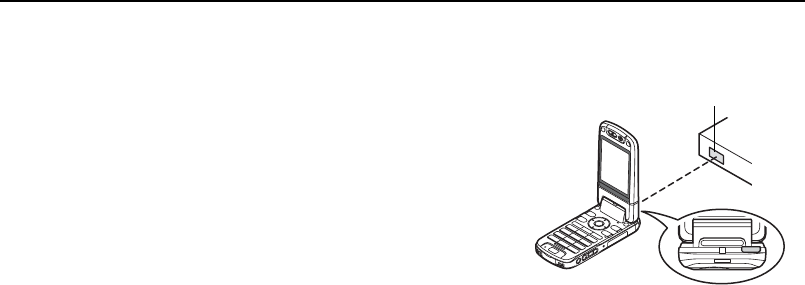
224
Connecting 902SH to Your PC
Note
•The phone may not recognise the USB data cable if it is connected while an application
(Camera, My Items, etc.) is running. Connect the USB data cable during stand-by.
Infrared communication
•Infrared ports need to be aligned with each other.
•Infrared ports need to be placed within 20 cm of each other and within a 30° angle.
3G/GSM GPRS modem
•It is not recommended that you make or answer calls when you are using 902SH as a
3G/GSM GPRS modem. The operation may be interrupted.
Handset Manager
•Some large files may not be able to be transmitted from the PC to the phone.
•Applications (Camera, My Items, etc.) do not run when the phone is connected to the PC
via Bluetooth wireless technology interface, infrared port or USB data cable.
Infrared port

225
Troubleshooting
Problem Solution
The phone does not turn on. •Make sure the battery is properly inserted and charged.
PIN code or PIN2 code is rejected.
•Make sure you have entered the correct code (4 to 8 digits).
•Your SIM/USIM card/protected functions will become locked after three unsuccessful attempts.
•Contact your SIM/USIM provider if you do not have the correct PIN code.
The SIM/USIM card becomes locked.
•Enter the PUK code (8 digits) provided by your service provider (if supported).
•If the attempt is successful, enter the new PIN code and confirm your phone is operational again.
Otherwise contact your dealer.
The display is difficult to read. •Adjust the backlight brightness for the display.
Phone functions do not work after the
phone is turned on.
•Check the radio signal strength indicator as you may be outside the service area.
•Check to see if any error message is displayed when you turn your phone on. If so, contact your dealer.
•Make sure the SIM/USIM card is correctly inserted.
Calls cannot be made or received.
•If the message “SIM card error” is displayed when the phone is switched on, you cannot use your SIM/
USIM card or the SIM/USIM card is damaged. Contact your dealer or network service provider.
•Check your call barring, fixed dialling setting, remaining battery and call forwarding settings.
•Check if your phone is currently performing data communication using Infrared (IrDA),
Bluetooth
wireless
technology interface or a USB data cable.
•Check the remaining balance if you are using a pre-paid SIM/USIM card.
Call quality is poor. •Your current location may not provide good call quality (i.e., in a car or train). Move to a location where
radio signal strength is greater.

226
Troubleshooting
Cannot access network service. •Check where your account has been registered and where the service is available.
Cannot send or receive text message. •Make sure you are correctly subscribed for the Short Message Service, that the network supports this
service, and that the centre number is set up correctly. If not, contact your network service provider.
Cannot connect to Multimedia Messaging
Service provider.
•MMS settings and configuration may be missing or incorrect or the network does not support it. Check
your service provider’s access point number.
Contact your service provider to confirm the correct settings.
Limited memory available. •Delete any unnecessary data.
Call is terminated unexpectedly. •Magnetised objects such as health necklaces placed near the phone may terminate the call. Keep your
phone away from such objects.
No entries are displayed in the Contacts
List. •Confirm that the Contacts Location setting (Handset or SIM/USIM) is made correctly.
Fax transmission failure •Before transmitting fax data, configure your fax software to use the software flow control.
•Use of the optional data cable is recommended for transmitting fax data.
Cannot receive OBEX data. •The OBEX data can only be received only during stand-by. The message “Please return to stand-by.”
is displayed.
Problem Solution

227
Safety Precautions and Conditions of Use
Your phone conforms to international regulations insofar as it is used under normal
conditions and in accordance with the following instructions.
CONDITIONS OF USE
Electromagnetic waves
• Do not switch on your phone aboard an aircraft (as your phone may interfere with the
aircraft’s electronic systems). Current legislation forbids this use and legal action can be
taken against the user.
• Do not switch on your phone in a hospital, except in designated areas.
• Use of your phone’s function may affect the performance of medical electronic units
(pacemakers, hearing aids, insulin pumps, etc.). When the phone function is on, do not
bring it near medical equipment or into areas in which medical equipment is being used.
If you have a hearing aid or a pacemaker, only use the phone on the opposite side of your
body from where it is located. The phone should be kept at least 6 inches (15.24 cm)
from a pacemaker ANYTIME the phone is switched on.
• Do not switch on your phone near gas or flammable substances.
• Observe the rules concerning the use of mobile phones at gasoline stations, chemical
plants and at all sites where a risk of explosion exists.

228
Safety Precautions and Conditions of Use
Caring for your phone
• Do not allow children to use your phone without supervision.
• Do not open or attempt to repair your phone yourself. The product can only be repaired
by authorised service personnel.
• Do not drop your phone or subject it to severe impacts. Bending the body and pushing
the display or keys with extreme force could damage the phone.
• Do not use solvents to clean your phone. Use only a soft, dry cloth.
• Do not carry your phone in your back pocket as it could break when you sit down. The
display is made of glass and is particularly fragile.
• Avoid touching the external connector on the underside of the phone, since the delicate
components within can be damaged by static electricity.

229
Safety Precautions and Conditions of Use
Battery
• Use your phone only with batteries, chargers and accessories recommended by the
manufacturer. The manufacturer disclaims any liability for damage caused by the use of
other chargers, batteries or accessories.
•Network configuration and phone usage will affect talk-time and stand-by
time.
Using the games or camera will hasten battery consumption.
•When the battery charging alert is displayed on the screen, charge the battery as
soon as possible. If you continue using your phone ignoring the alert, the phone may
cease to function, and all data and settings you have stored may be lost at any moment.
• Before removing the battery from the phone, make sure the phone is switched off.
• Replace and charge the new battery as soon as possible after removing the old one.
• Do not touch the battery terminals. Batteries can cause damage, injury or burns if a
conductive material touches exposed terminals. When the battery is detached from the
phone, use a cover made of non-conductive material for keeping and carrying the battery
safely.
• Recommended temperature for using and storing batteries is approximately 20°C.
• The batteries’ performance is limited in low temperatures, particularly below 0°C and the
phone may not work temporarily regardless of the amount of remaining battery power.
• Exposing the phone to extreme temperatures will shorten battery life.

230
Safety Precautions and Conditions of Use
• The battery can be charged and discharged hundreds of times but it will eventually wear
out. When the operating time (talk-time and stand-by time) is noticeably shorter than
normal, it is time to buy a new battery.
CAUTION
RISK OF EXPLOSION IF BATTERY IS REPLACED
BY AN INCORRECT TYPE,
DISPOSE OF USED BATTERIES ACCORDING
TO THE INSTRUCTIONS
See “Battery Disposal” on page 19.
Aerial Care
• Do not cover the top of the phone (p. 15, No. 21) with your hand when in use as this may
interfere with the performance of the built-in aerial. Call quality may deteriorate leading
to shortened talk-time and stand-by time because the mobile phone has to operate on a
higher power level than is necessary.

231
Safety Precautions and Conditions of Use
• Use only the aerial supplied or one approved by Sharp for your mobile phone. Using
unauthorised or modified aerials may damage the mobile phone. Moreover, since the
mobile phone may violate the appropriate regulations, it may lose performance or exceed
the limitation of SAR levels.
• To avoid impaired performance, do not damage the aerial of the mobile phone.
• While talking directly to the microphone, please hold the mobile phone so that the aerial
is upwards over your shoulder.
• To avoid interfering with blasting operations, please turn off the mobile phone in a
blasting area or in a place where a “turn off two-way radio” sign is posted.

232
Safety Precautions and Conditions of Use
Camera Operation
• Learn picture quality, file formats, etc. beforehand.
The taken pictures can be saved in JPEG format.
• Be careful not to move your hand while taking pictures.
If the phone moves while taking a picture, the picture can become blurred. When taking
a picture, hold the phone firmly to prevent it from moving, or use the delay timer.
• Clean the lens cover before taking a picture.
Fingerprints, oils, etc. on the lens cover hinder clear focusing. Wipe them off with a soft
cloth before taking a picture.
Others
• As with any electronic storage unit, data may be lost or corrupted under various
circumstances.

233
Safety Precautions and Conditions of Use
• Before connecting the phone with a PC or a peripheral unit, read the operation manual
for the other unit carefully.
• If the phone’s battery has been removed for some time, or the phone has been reset, the
unit’s clock and calendar may be reinitialised. The date and time should be updated in
this case.
ENVIRONMENT
• Keep your phone away from extreme heat. Do not leave it on the dashboard of a car or
near a heater. Do not leave it in any place that is extremely damp or dusty.
• Since this product is not waterproof, do not use it or store it where fluids such as water
can splash onto it. Raindrops, water spray, juice, coffee, steam, perspiration, etc. will also
cause malfunctions.

234
Safety Precautions and Conditions of Use
PRECAUTIONS CONCERNING VEHICLE USE
• It is the user’s responsibility to check the local laws governing the use of a mobile phone
in vehicles. Pay full attention to driving. Pull off to the side of the road, park the car, and
switch off the engine before making or answering a call.
• Use of your phone’s function may interfere with the vehicle’s electronic systems, such as
the ABS anti-lock brakes or the air-bag. To ensure no such problem occurs, please check
with your dealer or car manufacturer before connecting your phone.
• Only allow qualified service maintenance personnel to install the vehicle accessories.
The manufacturer disclaims any liability for damage which may result as a consequence of
improper use or use contrary to the instructions contained herein.

235
Safety Precautions and Conditions of Use
SAR
Your Sharp mobile phone has been designed, manufactured and tested so as not to exceed
the limits for exposure to electromagnetic fields set by the Australian Radiation Protection
and Nuclear Safety Agency (ARPANSA). These limits are part of comprehensive guidelines
developed by independent scientific organisations. The guidelines include a substantial
safety margin designed to assure the safety of the phone user and others and to take into
account variations in age and health, individual sensitivities and environmental conditions.
The exposure standards provide for the amount of radio frequency electromagnetic energy
absorbed by the body when using a mobile phone to be measured by reference to the
Specific Absorption Rate (SAR).
The SAR limit for the general public is currently 2.0 watts per kilogram averaged over 10
gram tissue. Your Sharp mobile phone SAR value is *.*** watts per kilogram. This has been
tested to ensure that this limit is not exceeded even when the phone is operating at its
highest certified power. In use however your Sharp mobile phone may operate at less than
full power because it is designed to use only sufficient power to communicate with the
network.

236
Safety Precautions and Conditions of Use
PRECAUTIONS FOR USE IN USA
FCC Declaration of Conformity
This mobile phone 902SH with PC/Data interface cable XN-1DC30 complies with part 15 of
the FCC Rules.
Operation is subject to the following two conditions:
(1) This device may not cause harmful interference, and
(2) this device must accept any interference received, including interference that may
cause undesired operation.
Responsible Party:
SHARP ELECTRONICS CORPORATION
Sharp Plaza, Mahwah, New Jersey 07430
TEL: 1-800-BE-SHARP
Tested To Comply With FCC Standards
FOR HOME OR OFFICE USE
FCC Notice
The phone may cause TV or radio interference if used in close proximity to receiving
equipment. The FCC can require you to stop using the phone if such interference cannot be
eliminated.
Information To User
This equipment has been tested and found to comply with the limits of a Class B digital
device, pursuant to Part 15 of the FCC Rules. These limits are designed to provide
reasonable protection against harmful interference in a residential installation. This
equipment generates, uses and can radiate radio frequency energy and, if not installed and
used in accordance with the instructions, may cause harmful interference to radio
communications.

237
Safety Precautions and Conditions of Use
However, there is no guarantee that interference will not occur in a particular installation; if
this equipment does cause harmful interference to radio or television reception, which can
be determined by turning the equipment off and on, the user is encouraged to try to correct
the interference by one or more of the following measures:
1. Reorient/Relocate the receiving antenna.
2. Increase the separation between the equipment and receiver.
3. Connect the equipment into an outlet on a circuit different from that to which the
receiver is connected.
4. Consult the dealer or an experienced radio/TV technician for help.
CAUTION: Changes or modifications not expressly approved by the manufacturer
responsible for compliance could void the user’s authority to operate the equipment.
Exposure to Radio Waves
THIS MODEL PHONE MEETS THE GOVERNMENT’S REQUIREMENTS FOR EXPOSURE
TO RADIO WAVES.
Your wireless phone is a radio transmitter and receiver. It is designed and manufactured not
to exceed the emission limits for exposure to radio frequency (RF) energy set by the Federal
Communications Commission of the U.S. Government. These limits are part of
comprehensive guidelines and establish permitted levels of RF energy for the general
population. The guidelines are based on standards that were developed by independent
scientific organizations through periodic and thorough evaluation of scientific studies. The
standards include a substantial safety margin designed to assure the safety of all persons,
regardless of age and health.

238
Safety Precautions and Conditions of Use
The exposure standard for wireless mobile phones employs a unit of measurement known
as the Specific Absorption Rate, or SAR. The SAR limit set by the FCC is 1.6W/kg.* Tests
for SAR are conducted using standard operating positions specified by the FCC with the
phone transmitting at its highest certified power level in all tested frequency bands.
Although the SAR is determined at the highest certified power level, the actual SAR level of
the phone while operating can be well below the maximum value. This is because the phone
is designed to operate at multiple power levels so as to use only the power required to reach
the network. In general, the closer you are to a wireless base station antenna, the lower the
power output.
Before a phone model is available for sale to the public, it must be tested and certified to
the FCC that it does not exceed the limit established by the government-adopted
requirement for safe exposure. The tests are performed in positions and locations (e.g., at
the ear and worn on the body) as required by the FCC for each model. The highest SAR value
for this model phone when tested for use at the ear is 0.338 W/kg and when worn on the body,
as described in this user guide, is 0.386 W/kg. Body-worn Operation; This device was tested
for typical body-worn operations with the back of the phone kept 1.5 cm from the body. To
maintain compliance with FCC RF exposure requirements, use accessories that maintain a
1.5 cm separation distance between the user’s body and the back of the phone. The use of
belt-clips, holsters and similar accessories should not contain metallic components in its
assembly.
The use of accessories that do not satisfy these requirements may not comply with FCC RF
exposure requirements, and should be avoided. While there may be differences between
the SAR levels of various phones and at various positions, they all meet the government
requirement for safe exposure.

239
Safety Precautions and Conditions of Use
The FCC has granted an Equipment Authorization for this model phone with all reported SAR
levels evaluated as in compliance with the FCC RF emission guidelines. SAR information on
this model phone is on file with the FCC and can be found under the Display Grant section
of http://www.fcc.gov/oet/fccid after searching on FCC ID APYHRO00038.
Additional information on Specific Absorption Rates (SAR) can be found on the Cellular
Telecommunications & Internet Association (CTIA) web-site at http://www.phonefacts.net.
* In the United States and Canada, the SAR limit for mobile phones used by the public is
1.6 watts/kg (W/kg) averaged over one gram of tissue. The standard incorporates a
substantial margin of safety to give additional protection for the public and to account for
any variations in measurements.

240
Specifications and Optional Accessories
Specifications
Weight: Approximately 149 g (with battery)
Dimensions (W × H × D): Approximately 50 × 102 × 26 mm (without protruding parts)
Battery: Lithium Ion, 3.7 V, 870 mAh
Optional Accessories
• Lithium Ion Battery (XN-1BT90)
• Cigarette Lighter Charger (XN-1CL90)
• USB Data Cable (XN-1DC30)
• AC Charger (XN-1QC32)
• External Antenna Cable (XN-1AT90)
• Audio Remote-Controller (XN-1AR90)
• Car Holder (XN-1CH90)
• Desktop Holder (XN-1DH90)
• Stereo Headset (XN-1H90)
• Handsfree Microphone Unit (XN-1HU90)
• Video Cable (XN-1VC90)
The above accessories may not be available in all regions.
For details, please contact your dealer.

241
Index
Symbols
#/Flash Light Key 14
* /Shift Key 12
A
Alarms 152
Resetting 154
Setting 152
Area Info 99
Enabling/Disabling 99
B
Backup/Restore 218
Making a Backup File 219
Restoring a Backup File 219
Battery 18
Charging 20
Disposal 19
Inserting 18
Removing 19
Battery Cover 15
Battery Level Indicator 21
Bluetooth Wireless Function 205
Built-in Aerial 15
C
Calculator 154
Calendar
Creating 148
Deleting Schedule Entries 151
Editing a Schedule Entry 150
Receiving a Schedule Entry 150
Sending a Schedule Entry 149
Viewing a Schedule Entry 150
Viewing the Memory Status 151
Call Costs 203
Checking the Cost of the Last Call 203
Checking the Residual Credit 204
Checking the Total Call Cost 203
Resetting All Call Costs 204
Setting the Charge Limit 204
Setting the Charge Rate 203
Call Log 201
Deleting 202
Sending Messages 201
Viewing 201
Call Settings 187
Call Information 190
Call Waiting 189
Changing the Network Password 193
Displaying Call Timer 194
Diverts 187
Fixed Dialling No. 192
Minute Minder 194
Rejecting an Incoming Call 193
Restrict Calls 190
Showing Your Phone Number 189
Call Timers 202
Checking the Duration of the Last Call
and All Calls 202
Resetting Call Timers 202
Camera (digital/video) 69
Adjusting the Exposure 72, 82
Auto Save 78
Changing the Displaying Size 84
Continuous Shoot 74
Focus Setting 77
Focus Settings 85
Mobile Light 72, 82
Recording Video Clips 79
Recording with Sound 84
Saving 77, 85
Selecting a Frame 75
Selecting the Picture Quality 76
Selecting the Picture Size 71
Selecting the Recording Time 82
Selecting the Scene 73
Selecting the Shutter Sound 76
Selecting Video Quality 83
Sending 70, 80
Switching to the Photo Camera Mode 83
Switching to the Video Camera Mode 75
Taking Pictures 69
Using the Timer 73
Using the Zoom Function 71, 81
Viewing 82
Cell Broadcasts 97
Enabling/Disabling 97
Reading 97
Setting Languages 97
Subscribing 98

242
Index
Centre Key 12, 27
Characters 63
Changing the Input Languages 65
Changing the Input Mode 65
Using Templates 67
Clear/Back Key 13
Conditions of Use 227
Connectivity 205
Bluetooth 205
Infrared 211
Internet Settings 215
Network Settings 211
Contacts List 52
Assigning a Ringtone or a Ring Video
Clip 59
Call Costs 62
Changing the List 53
Changing the List Order 54
Changing the Name Order 53
Copying 56
Creating 54
Deleting 57
Dialling 56
Editing 57
Finding 56
Manage Group 58
Memory Status 60
Receiving 62
Selecting the Storage Memory 54
Sending 61
Setting in the Speeddial List 60
Speeddial List 60
Viewing My Contact Details 55
Countdown Timer
Editing the Countdown Time 167
D
Display
Adjusting the Brightness of the Backlight
182
Assigning the Pictures 178
Backlight 181
Setting My Pictures 177
Setting the Display Saving 182
Setting the Font Weight 179
Setting the Greeting Message 179
Setting the Sub Display 180
Setting Video Out 183
Showing the Clock 181
Wallpaper 177
Display Indicators 27
Display Position
Normal Position 32
E
Earpiece 12
Earpiece Volume 39
Emergency Calls 35
End/Power Key 13
Expenses Memo 167
Modifying the Category Name 168
Recording 167
Viewing Totals 167
External Camera 15
External Connector 15
F
Flash Light Key 14
Functions
Navigating 33
G
Games & More 142
Activating Files with Copyright
Protection (DRM) 135
Deleting an Application 144
Downloading 133
Executing 133
Java™ Information 147
More Games 135
Receiving 137
Sending 136
Setting Network Access 143
Setting Security Level 142
Settings 145
Switching the Memory Source 134
Switching the Screensaver On or Off
144
Using 132
Viewing Application Information 144

243
Index
H
Handset Code 198
Handset Lock 197
I
Incall Menu (Video Call) 46
Changing the Image of Yourself 46
Muting the Microphone 46
Swapping Images 46
Turning the Stereo Speakers On and Off
47
Using the Optical Zoom Function 47
Video Call Settings 47
Incall Menu (Voice Call) 39
Accessing SMS/MMS Menu during a
Call 40
Adjusting the Earpiece Volume 39
Call Waiting 40
Conference Call 41
Muting the Microphone 43
Putting a Call on Hold 39
Turning the Stereo Speakers On and Off
39
Infrared 211
Infrared Port 16
International Calls 36
Internet Settings 215
J
Java™ Applications 142
K
Keypad 14
Keypad Lock 26
L
Language Setting 187
Left Soft Key 12
M
Main Display 13
Master Reset 200
Media Player 109
Music Player 109
Switching between Music Player and
Video Player 109
Video Player 112
Memory Card
Inserting 23
Removing 24
Memory Card Slot Cover 16
Memory Settings 199
Formatting Memory Card 199
Viewing the Memory Status 199
Menu and Shortcut 49
Messages (MMS/SMS/Email)
Calling the Phone Number 94
Creating 87
Downloading 94
Email Settings 103
Forwarding 95
General Settings 100
Locking or Unlocking 96
MMS Settings 102
Reading 93
Remote Forward 95
Replying 95
Sending a Message in the Drafts Box 93
SMS Settings 101
Sorting the Messages 96
Storing the Phone Number 93
Microphone 13
Mobile Light 15
Multimedia Key 13
Music Player 109
Adding a File to the Playlist 110
Creating a New Playlist 112
Playing Back 109
Searching a File to Be Played Back 110
Streaming 111
My Items 116
Bookmarks 137
Games & More 132
My Saved Page 137
Other Documents 139
Pictures 117
Sounds & Ringtones 128
Text Templates 138
Videos 123
N
Navigation Keys 12

244
Index
Network Settings 211
O
Organiser 148
Alarms 152
Calculator 154
Calendar 148
Countdown Timer 166
Expenses Memo 167
Phone Help 168
Scanner 157
Stopwatch 161
Tasks 162
Voice Recorder 156
World Clock 165
P
PC Connection 221
3G/GSM GPRS Modem 222
Handset Manager 223
Software Installation 223
System Requirements 221
Phone Help 168
Pictures
Adjusting the Size 119
Downloading 122
Editing 118
Operating 120
Saving to Contacts List Entries 118
Sending a Picture File 120
Switching the Memory Source 117
Viewing 117
Power On and Off 24
Profiles 170
Activating 170
Any Key Answer 176
Assigning a Ring Video Clip File 173
Assigning a Ringtone 172
Customising 170
External Light Colour 176
Keypad Tones 174
Message Notification 174
Resetting 171
Ringer Volume 171
Vibration 175
R
Redialling 37
Right Soft Key 13
S
Safety Precautions 227
Scanner 157
Checking the Information of the Scanned
Data 161
Creating QR Codes 159
Deleting the Scanned Data 160
Reading Barcodes 157
Renaming the Scanned Data 161
Scanning Texts 159
Screensavers 144
Setting Applications 145
Security 196
Changing the PIN2 Code 197
Enabling/Disabling the PIN Code 196
Handset Lock 197
Phone Lock 198
Showing Secret Data 199
Send/Redial Key 12
Shortcut Key 12
Side Keys 16
SIM Application 169
SIM Card 18
Inserting 18
Removing 19
Small Light 16
Sound Settings 184
Sounds & Ringtones
Downloading 132
Operating 130
Playing Back 128
Sending a Sound File 129
Switching the Memory Source 128
Using the Sound Files as a Ringtone 129
Speed Dialling 36
Stereo Speakers 15
Stopwatch 161
Sub Camera (Internal Camera) 13
Sub Display 15
Switching the Screensaver On or Off 144

245
Index
T
Tasks
Creating 162
Deleting 165
Editing 163
Sending 164
Setting the Alarm 162
Viewing the Memory Status 164
Time & Date 185
Customising the Time Zone 186
Selecting the Date Format 186
Selecting the Time Format 185
Setting the Calendar Format 186
Setting the Daylight Saving 186
Setting the Time Zone 186
Troubleshooting 225
V
Video Call
Answering 44
Letting the Caller Know You are
Unavailable 45
Making 43
Rejecting 45
Status Indicators 43
Video Call Settings 47, 194
Assigning Hold Guidance Picture 195
Backlight 195
Mute 195
Selecting Picture Quality 194
Turning On or Off the Speakers 194
Video Clip
Downloading 127
Operating 124
Playing Back 123
Sending a Video Clip File 124
Switching the Memory Source 123
Uploading 127
VIDEO OUT/Handsfree Microphone
Connector 15
Video Player 112
Adding a File to the Playlist 113
Backlight 115
Creating a New Playlist 114
Editing the Video Clip File 115
Playing Back Video Clip Files 112
Searching a File to Be Played Back 113
Streaming 114
Viewfinder Switch Key 12
Vodafone live! 104
Voice Call 35
Answering 37
Call Waiting 40
Conference Call 41
Earpiece Volume 39
Making 35
Muting 43
Putting on Hold 39
Rejecting 38
Speed Dialling 36
Voice Mail Key 12
Voice Recorder 156
Recording 156
Selecting Storage Memory 157
Sending 156
Viewing Record Time 157
W
WAP Browser
Browser Menu 106
Navigating a WAP Page 105
Starting 105
World Clock
Setting the Daylight Saving 166
Setting the Time Zone 165
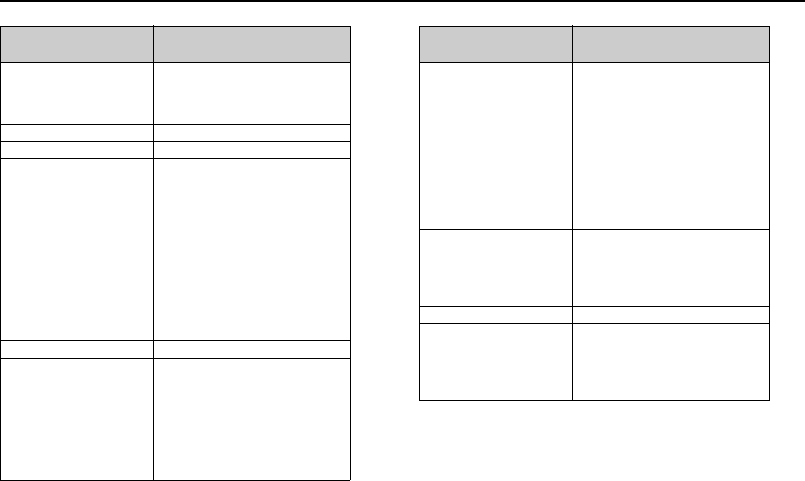
246
List of Menu Functions
Menu No./
Main Menu Menu No./
Sub Menu1
1Games & More
1Games
2Screensavers
3Settings
4Java™ Information
2Vodafone live!
3Media Player
4Messages
1Create New
2Inbox
3Drafts
4Templates
5Sent
6Outbox
7Vodafone Messenger
8Voicemail Menu
9Cell Broadcasts
10 Area Info
11 Settings
12 Memory Status
5Camera
6My Items
1Pictures
2Videos
3Sounds & Ringtones
4Games & More
5Bookmarks
6My Saved Page
7Text Templates
8Other Documents
7Organiser
1Calendar
2Alarms
3Calculator
4Voice Recorder
5Scanner
6Stopwatch
7Tasks
8World Clock
9Countdown Timer
10 Expenses Memo
11 Phone Help
8Contacts
1Contacts List
2Manage Group
3Speeddial List
4My Contact Details
5Advanced
9SIM Application
10 Connectivity
1Bluetooth
2Infrared
3Network Settings
4Internet Settings
5Backup/Restore
Menu No./
Main Menu Menu No./
Sub Menu1

247
List of Menu Functions
Menu No./
Main Menu Menu No./
Sub Menu1
11 Call Log
1All Calls
2Missed Calls
3Received Calls
4Dialled Calls
5Call Timers
6Call Costs
12 Settings
1Profiles
2Display Settings
3Sound Settings
4Time & Date
5Language
6Call Settings
7Video Call Settings
8Security Settings
9Memory Settings
10 Master Reset